We took a little trip! The marinas in Israel had no room for us so we decided to fly there and visit for a week. Our itinerary was packed. That was the plan: spend a little time in a lot of places to get a feel for the country and have diverse experiences.
Those who worked with me know that I tend to plan using the “back of the napkin” method. Here are the notes I took:
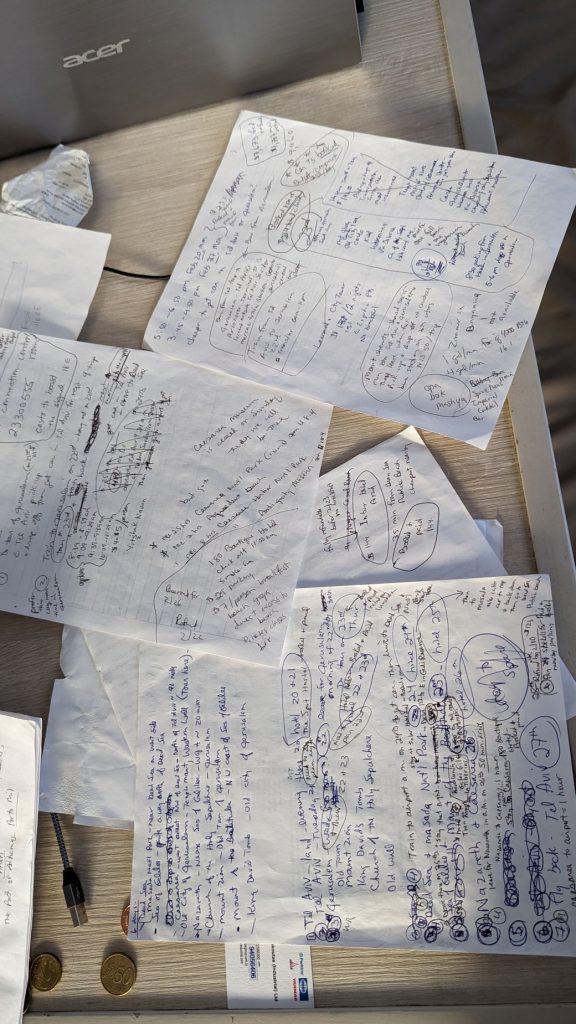
Perhaps those who utilize a similar system will recognize the superior methodology. I ended up with a very well-organized itinerary that I typed in Google docs. We didn’t follow it 100 percent but it was a very useful guide and allowed us to make amendments on the fly. I highly recommend this approach.
We flew to Tel Aviv. Michael got a window seat so I told him that it was his duty to take pictures. With great seat assignment comes great responsibility. He did well.
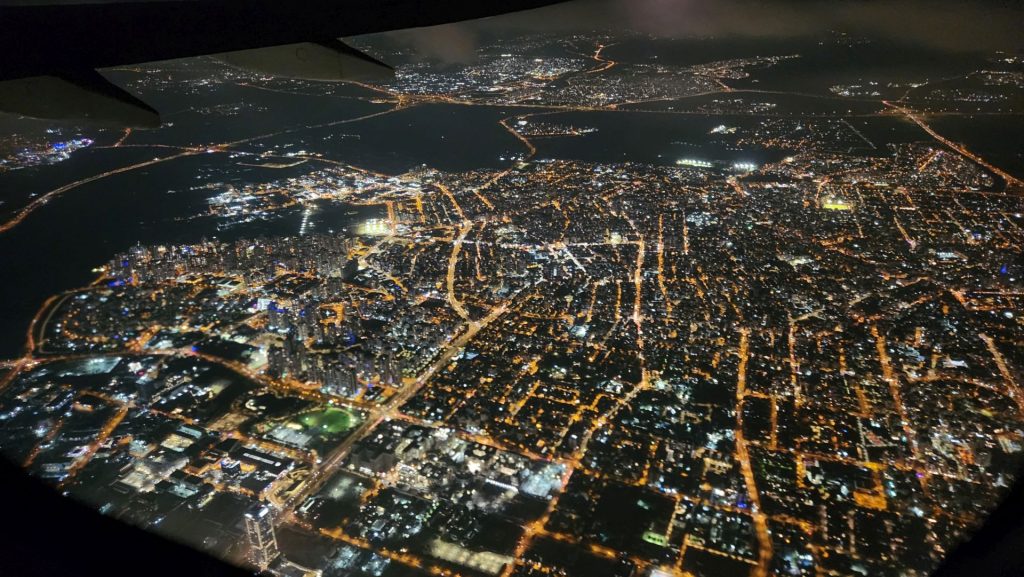
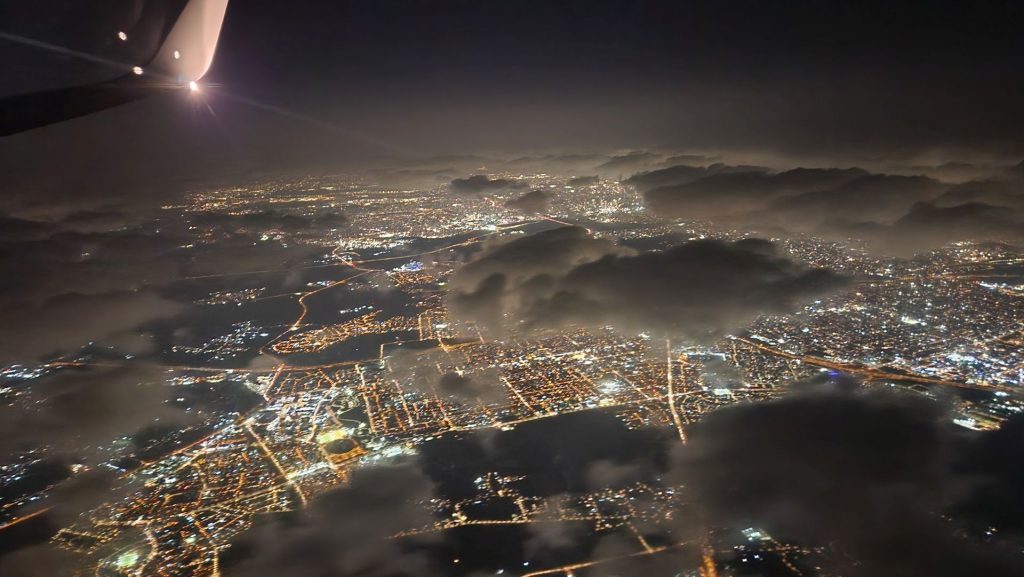
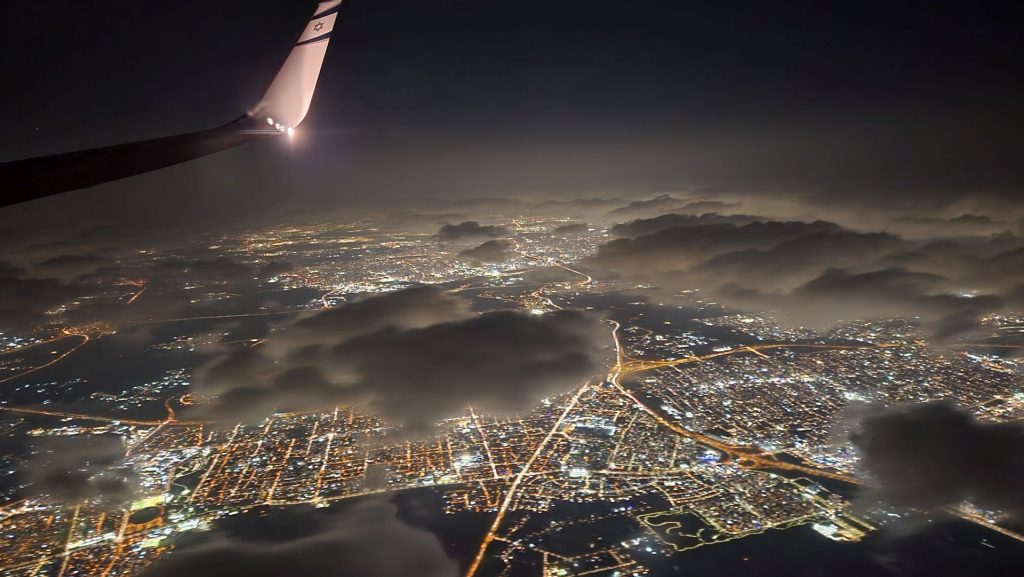
The plan was to take the train from the airport to a station near our lodging. The plan played out well. . . . and it was really cheap!
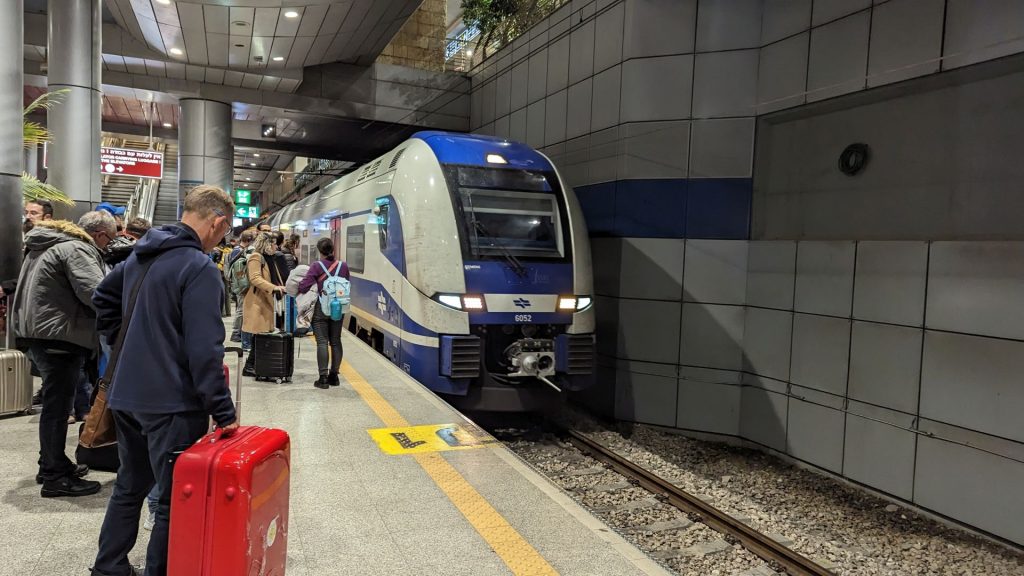
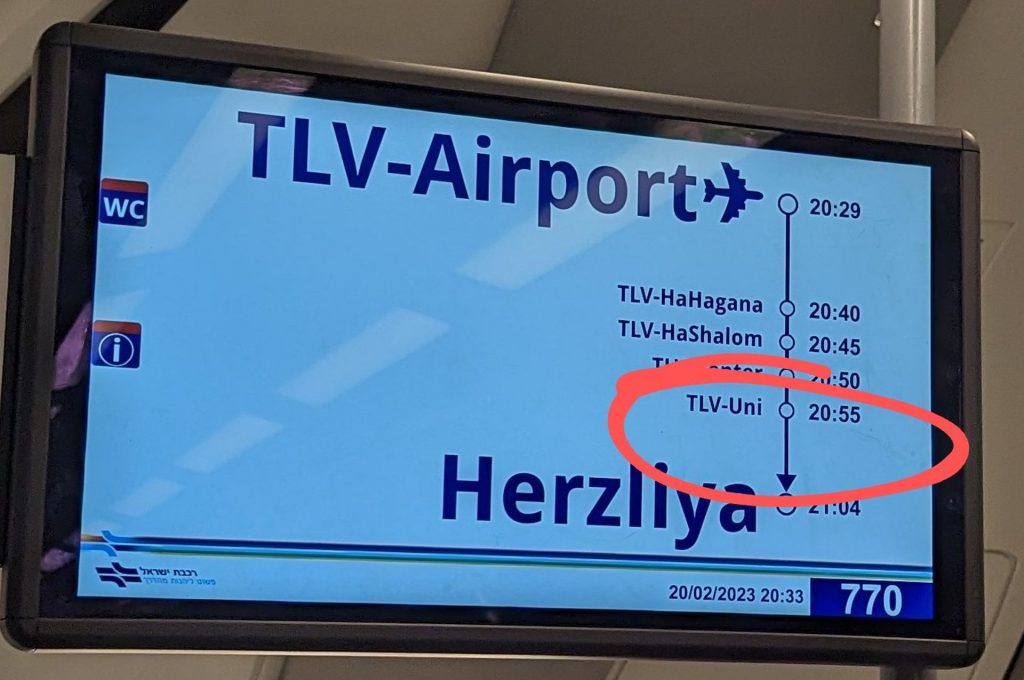
Michael surprised me by suggesting that we walk the three kilometers to the hostel. It was a lovely night and a nice walk.
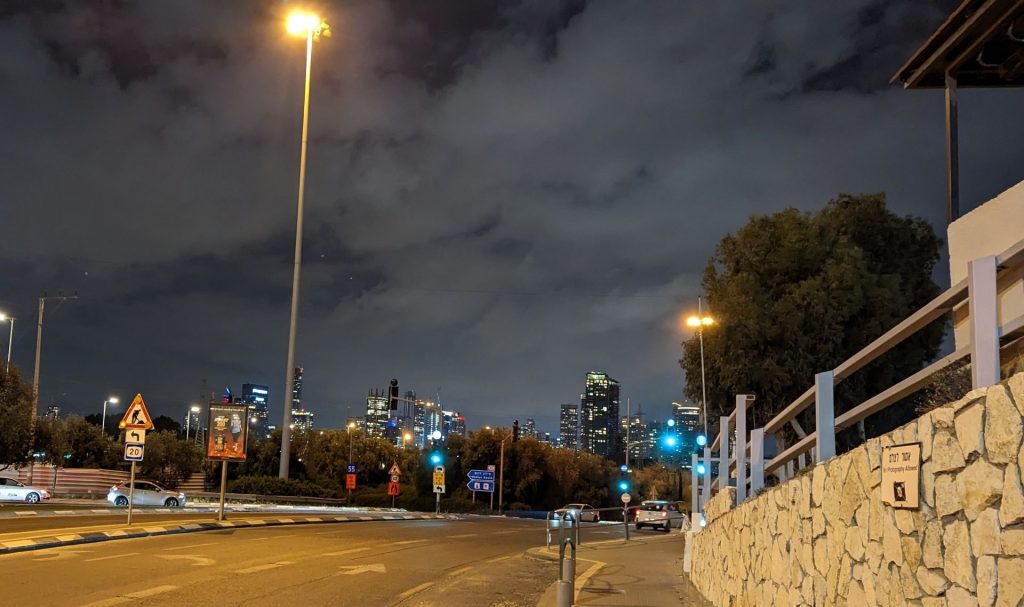
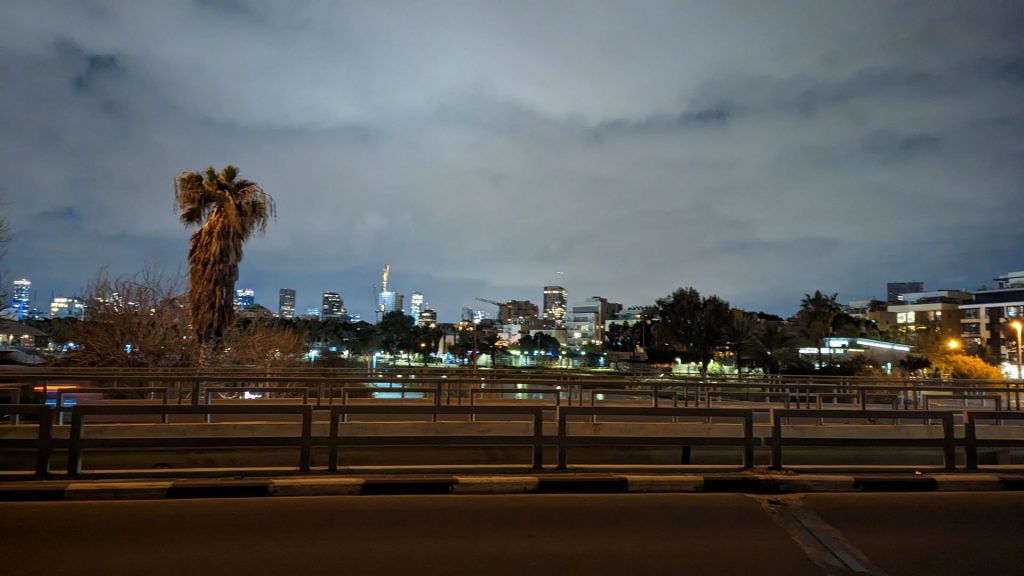
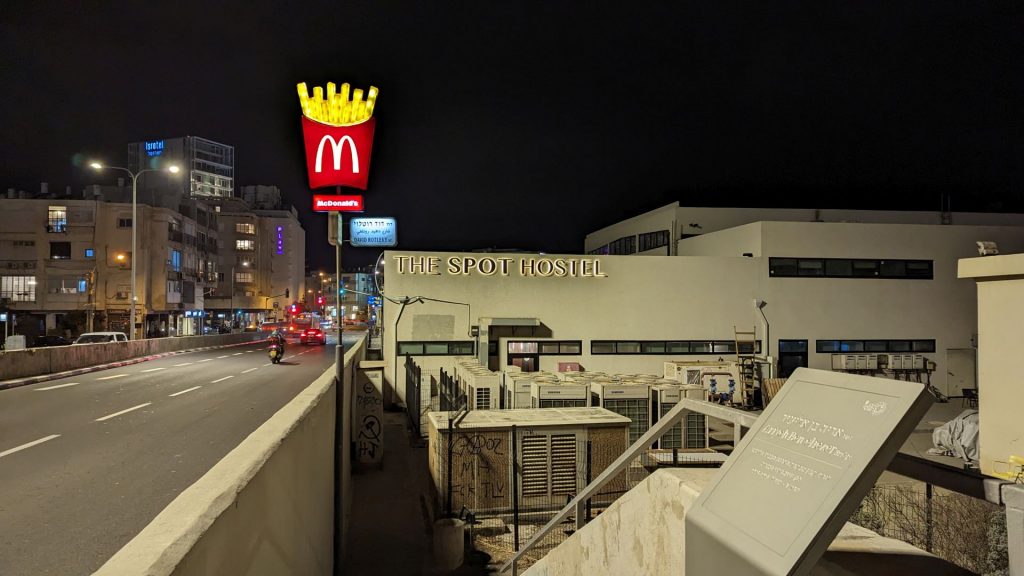
Once we checked in, we walked downstairs to the hostel bar for a beer. Michael was quite clear that he just wanted one beer. Okie dokie.
Little did we know that Matan (not sure how you actually spell his name, but it rhymes with “baton”) was bartending that night and that we would spend the next two hours laughing our heads off. I laughed so hard my stomach muscles hurt. The beer was also good. I was surprised when Matan asked us if we wanted a second round and Michael said yes. That’s when I knew for certain that he was having as good a time as I was.
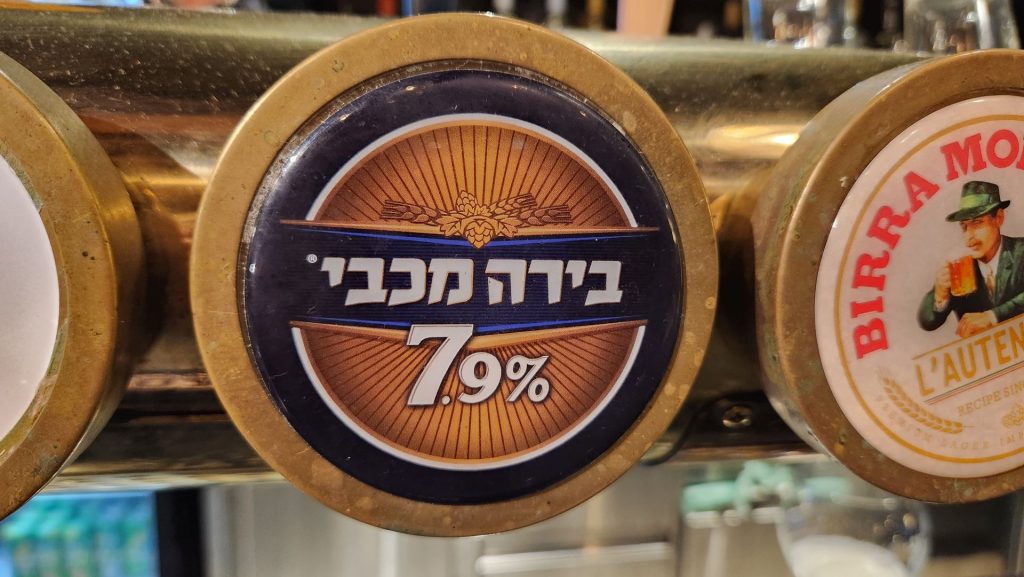
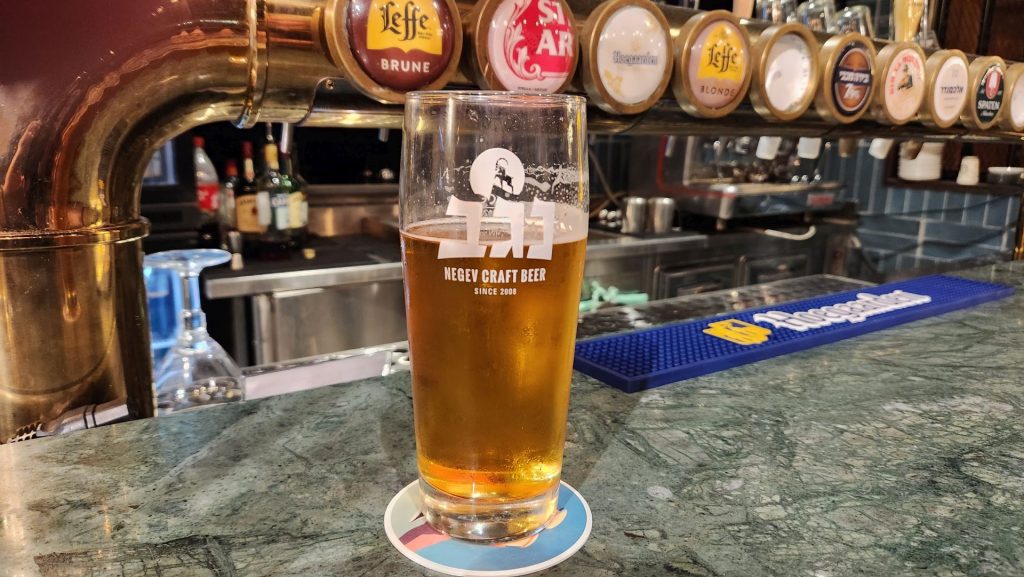
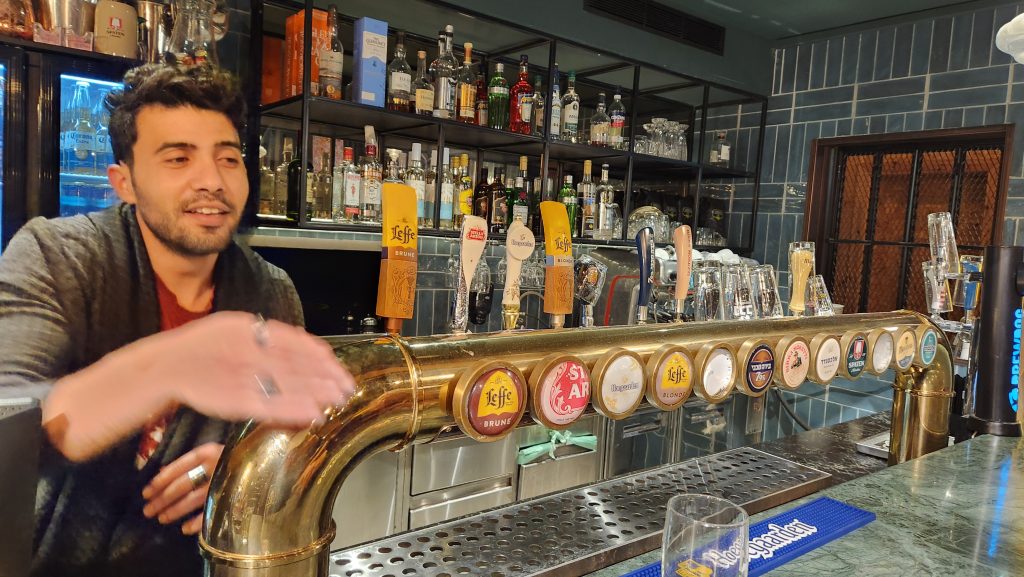
At some point during the long conversation, Matan mentioned that he was going to be rich and famous one day. Or maybe just rich. In any event, he is in the theater so he will be a star one day. I asked for his autograph so I could point to it one day and say, “I knew him before he made it big.” He obliged.
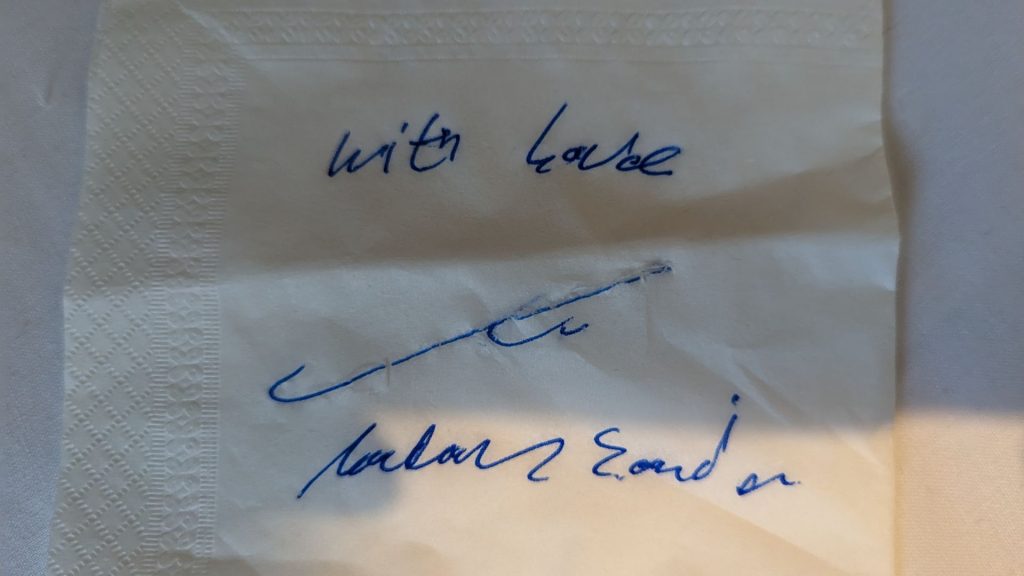
The hostel was lovely. We hadn’t stayed at one before. We reserved a room with a private bathroom, so I guess we didn’t get the full experience, but we loved the community feel.
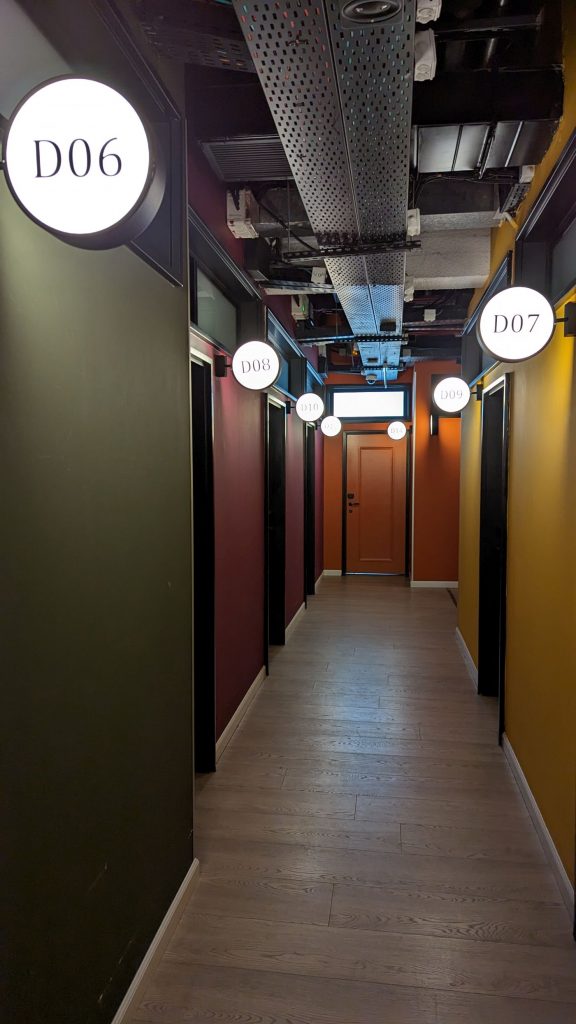
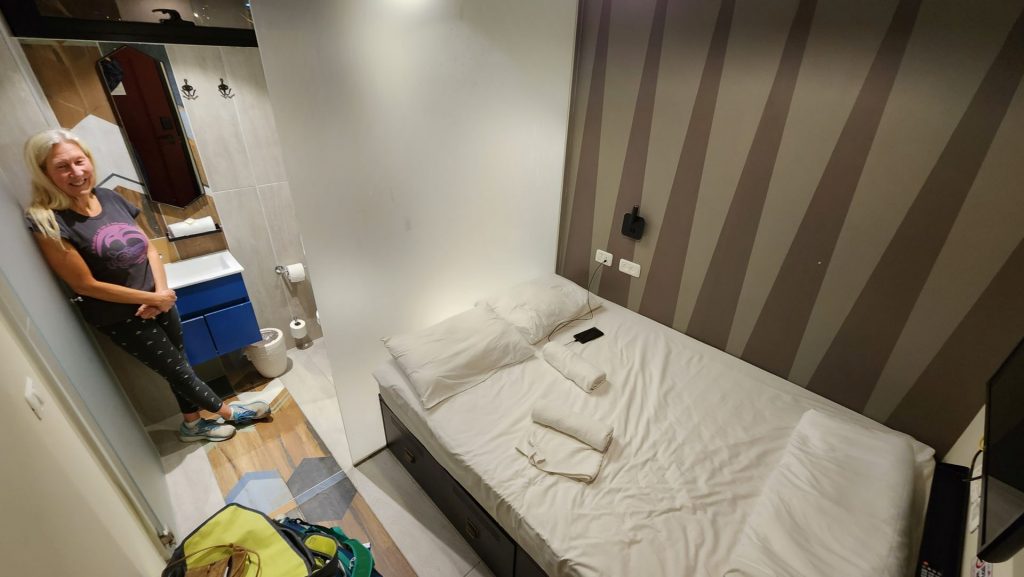
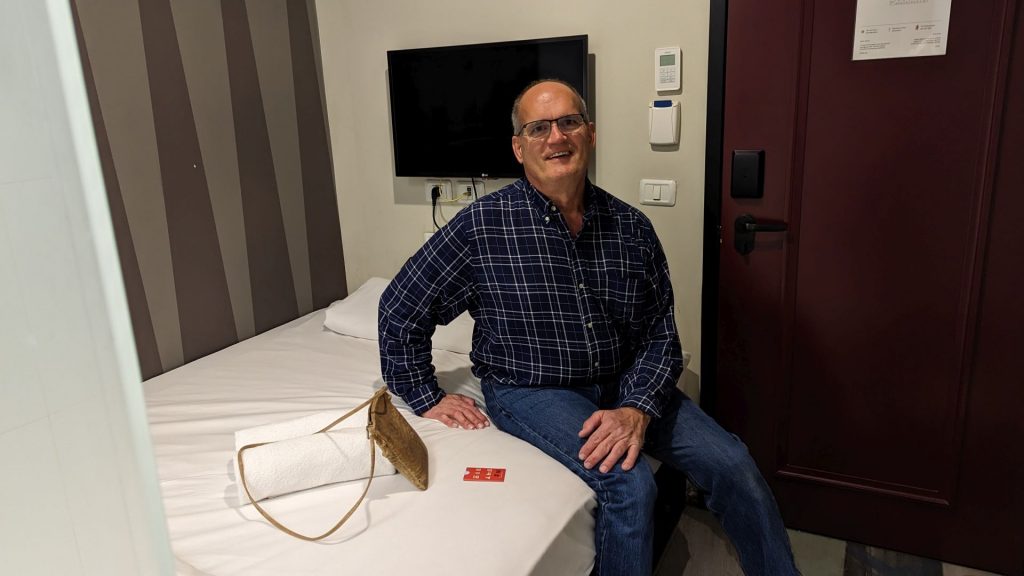
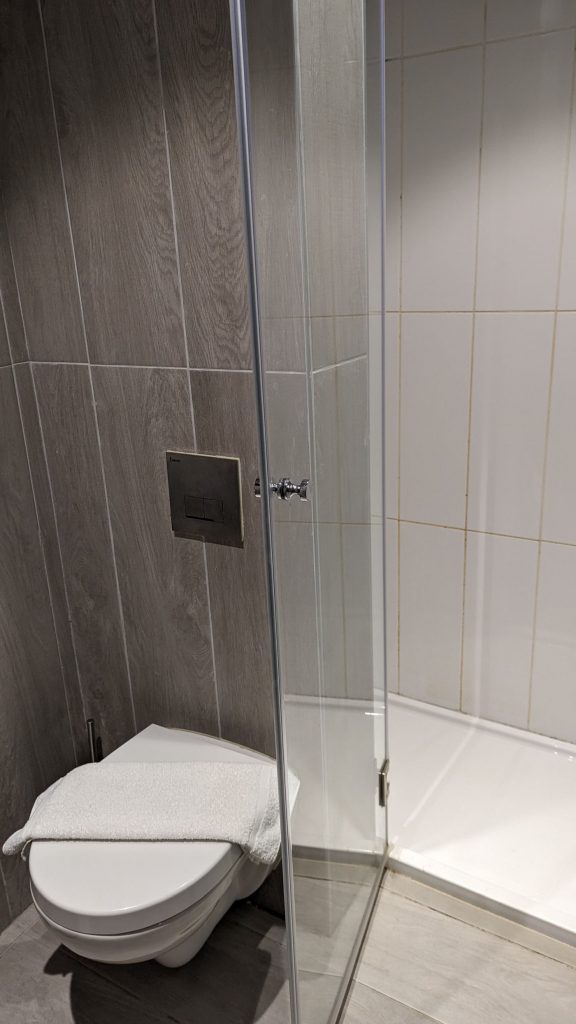
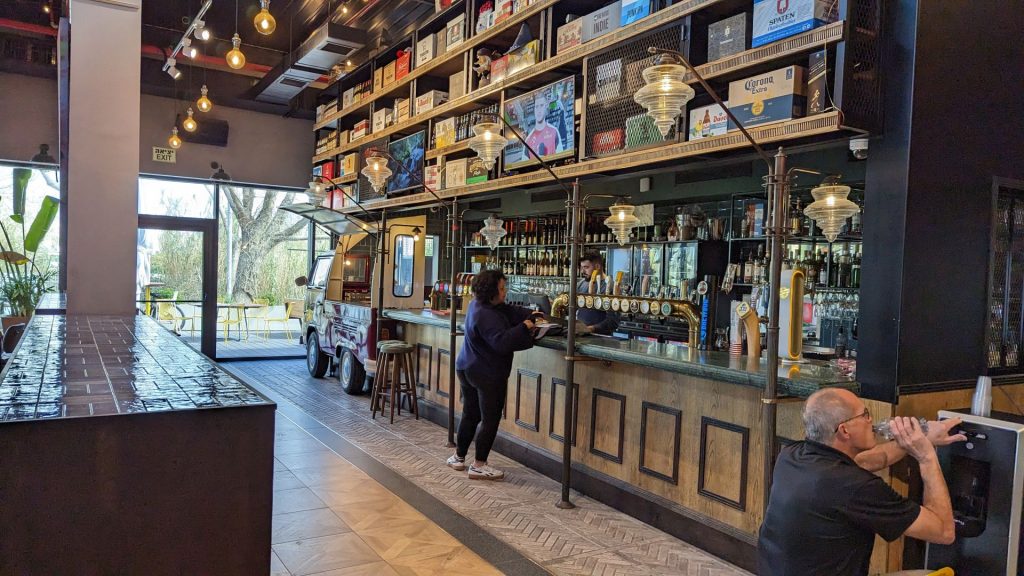
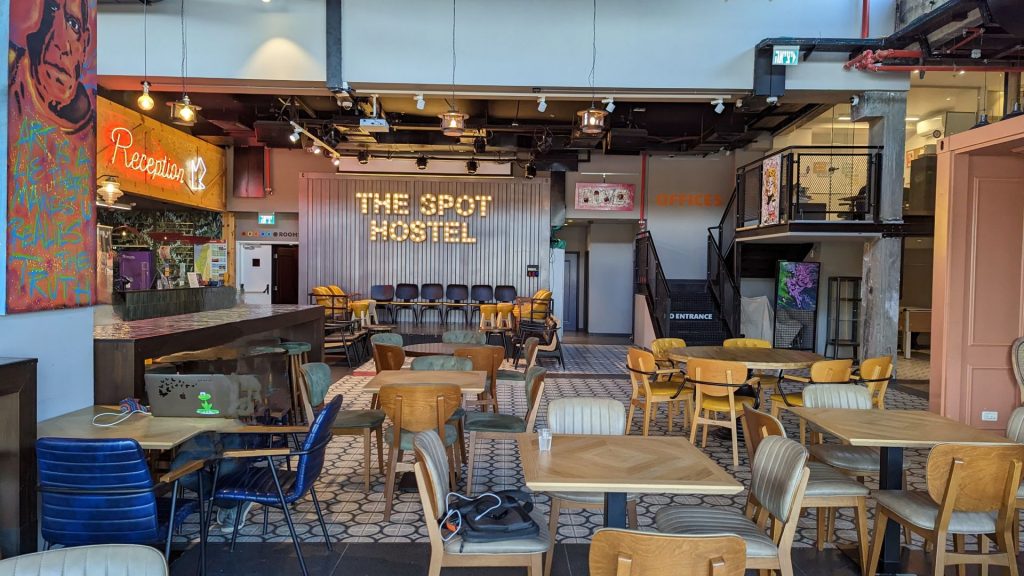
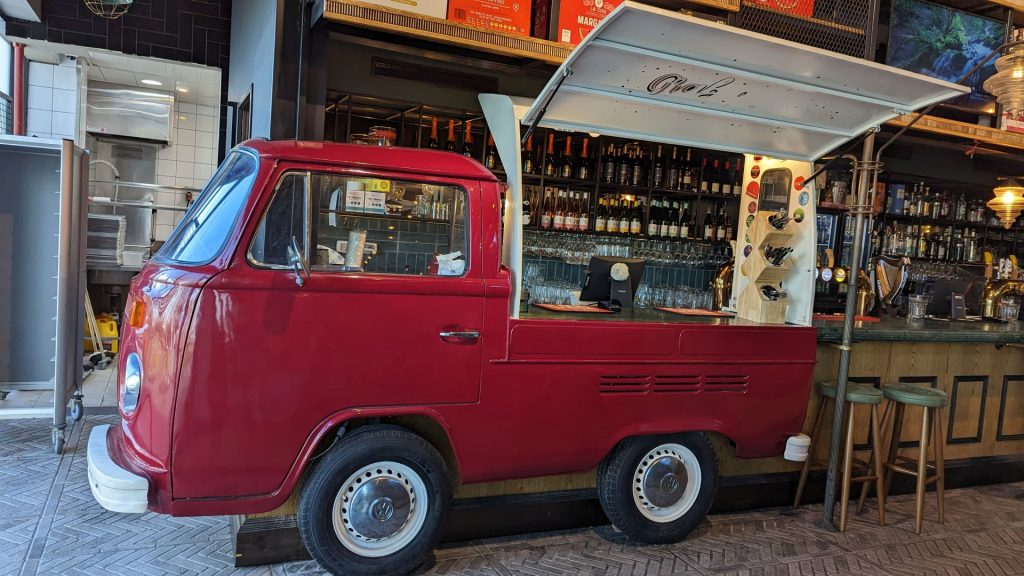
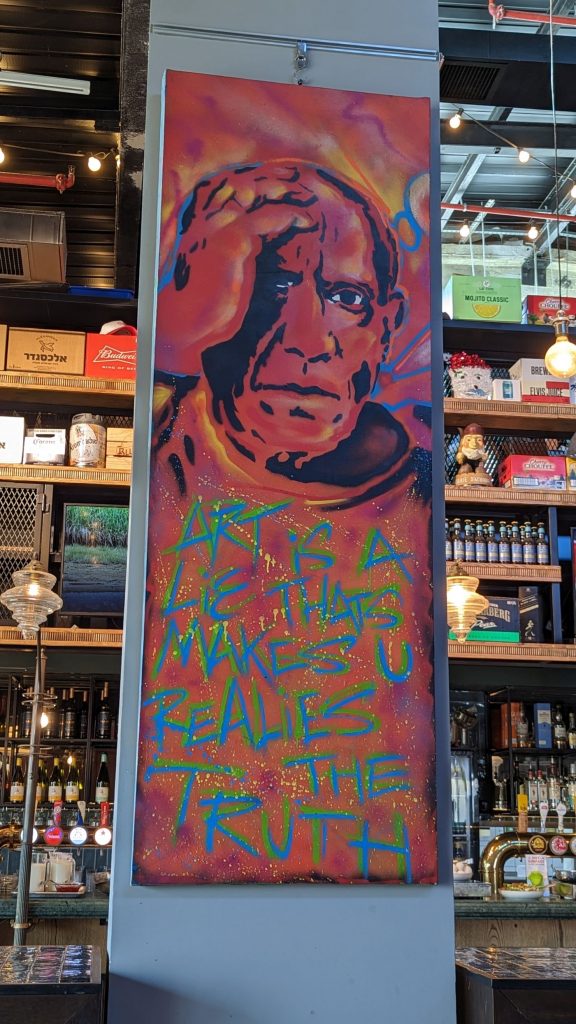
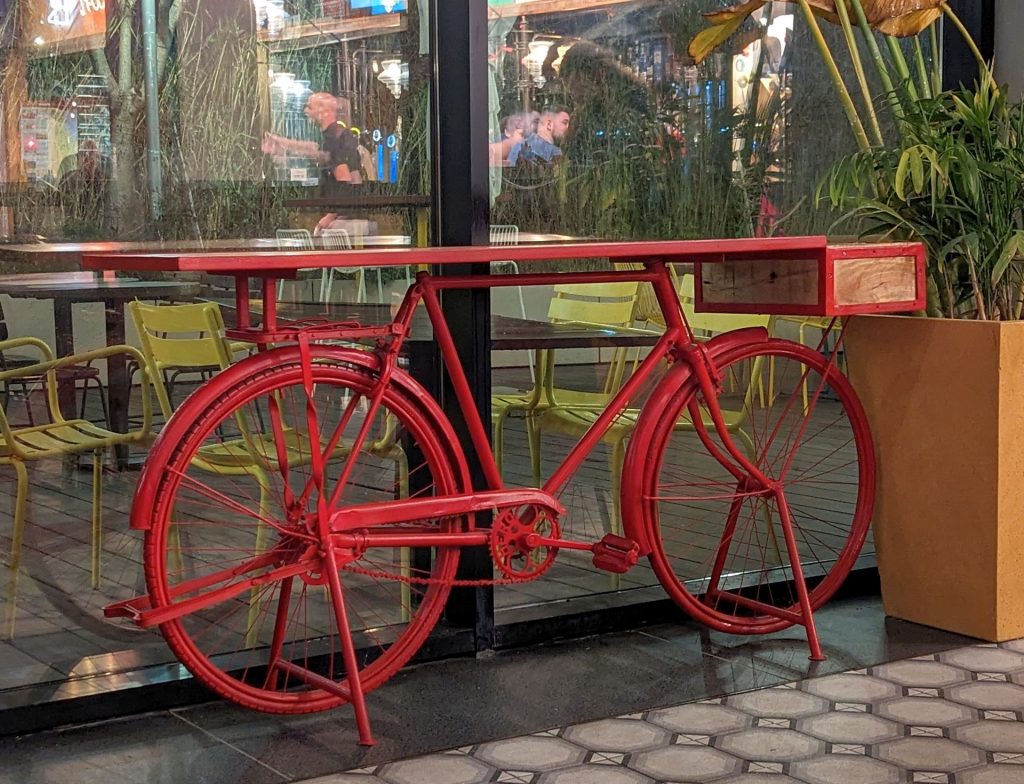
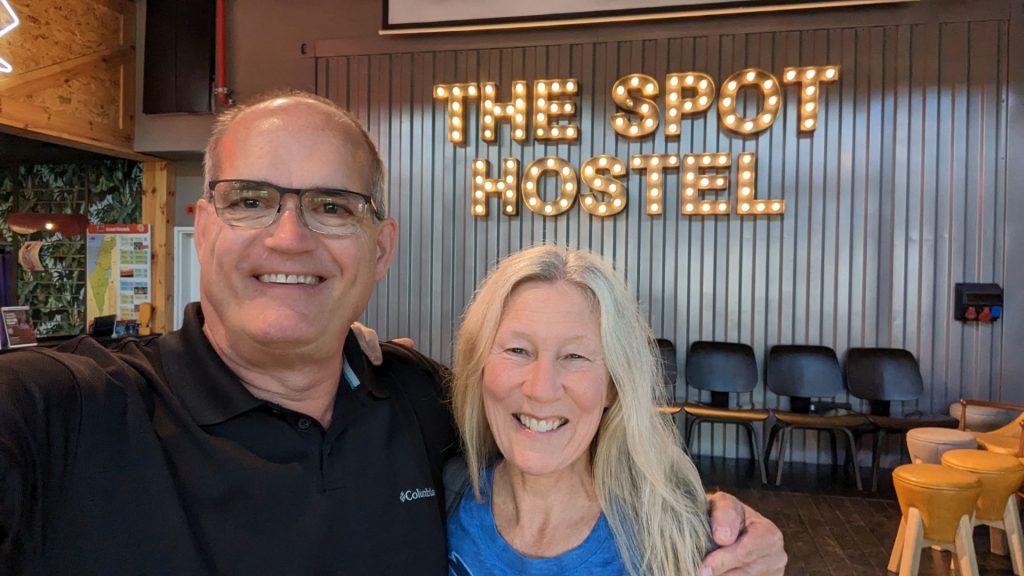
We walked to the light rail station the next day to get ourselves closer to our first stop of the day in Tel Aviv. As we approached an intersection I heard someone call out my name. It was Matan. He was riding an electric bike. We saw a lot of electric bikes and scooters in Israel. Folks rode those right between the cars. We thought it looked dangerous . . .
We were happy to see that the stops were displayed in English (as well as Hebrew and Arabic) on the train.
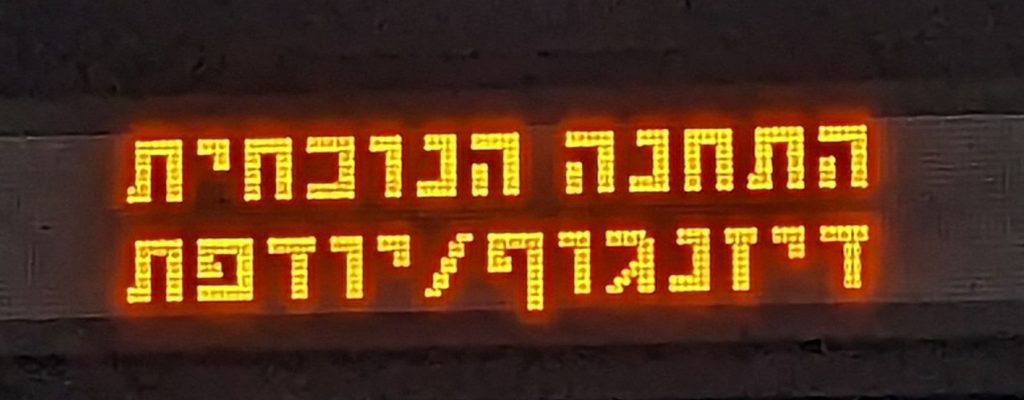
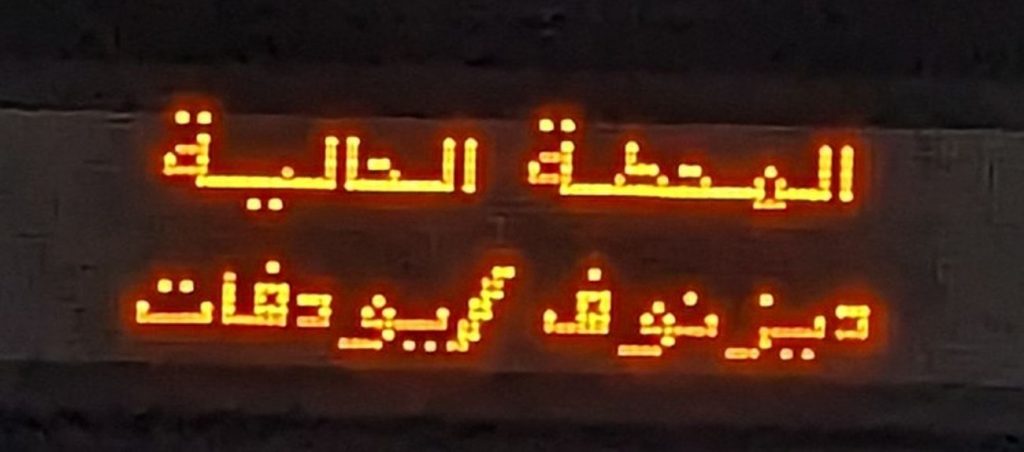
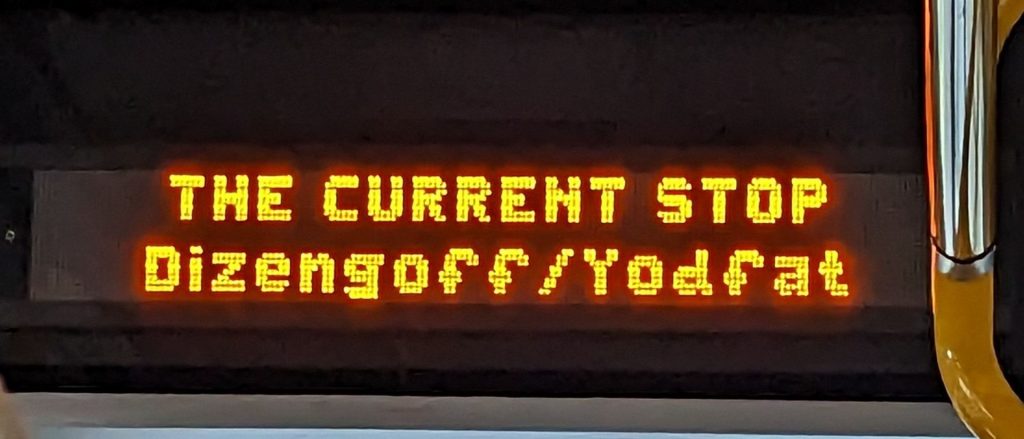
We used the Rav-Kav card to pay for public (light rail and bus) transportation. It is very convenient. If you plan to use the Rav-Kav card, note that you have to have one card per person for the light rail, but you can share an anonymous card for the bus since it lets you select the number of fares to attach to it.
Our first stop was the open air Carmel Market. This is a huge tourist spot, but we still wanted to go. The colors were pure eye candy! So, of course, I took roughly 78 pictures . . .
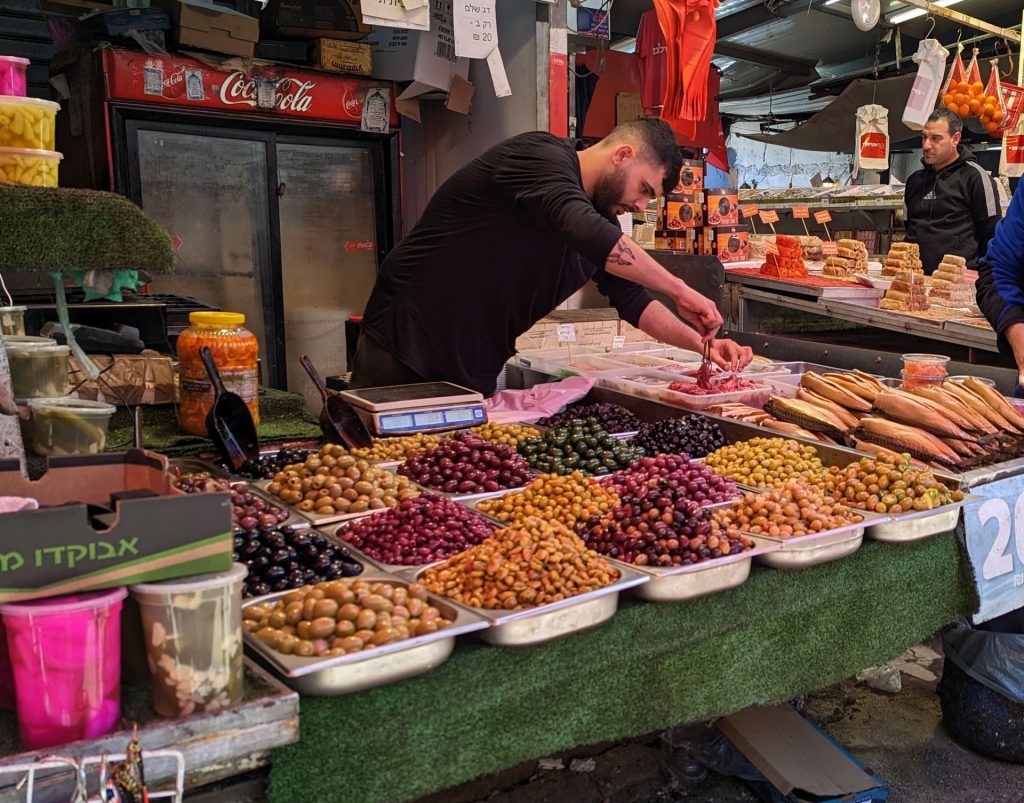
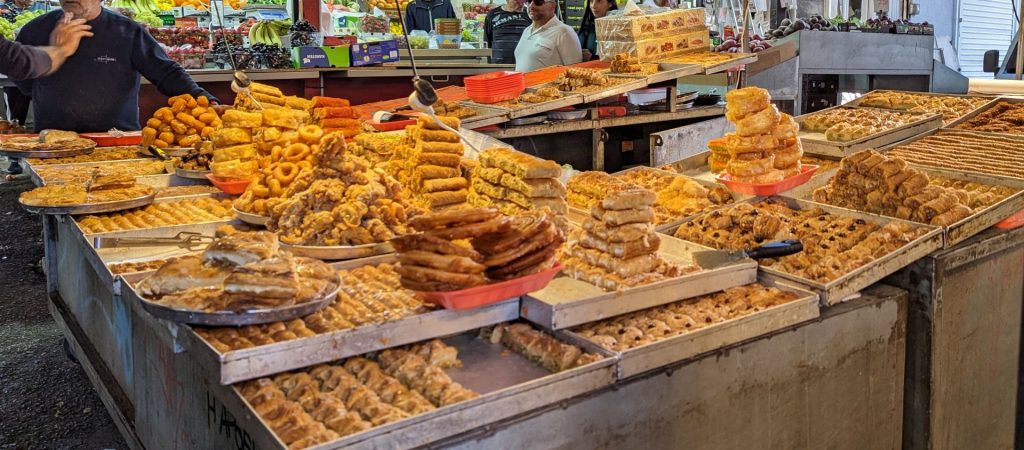
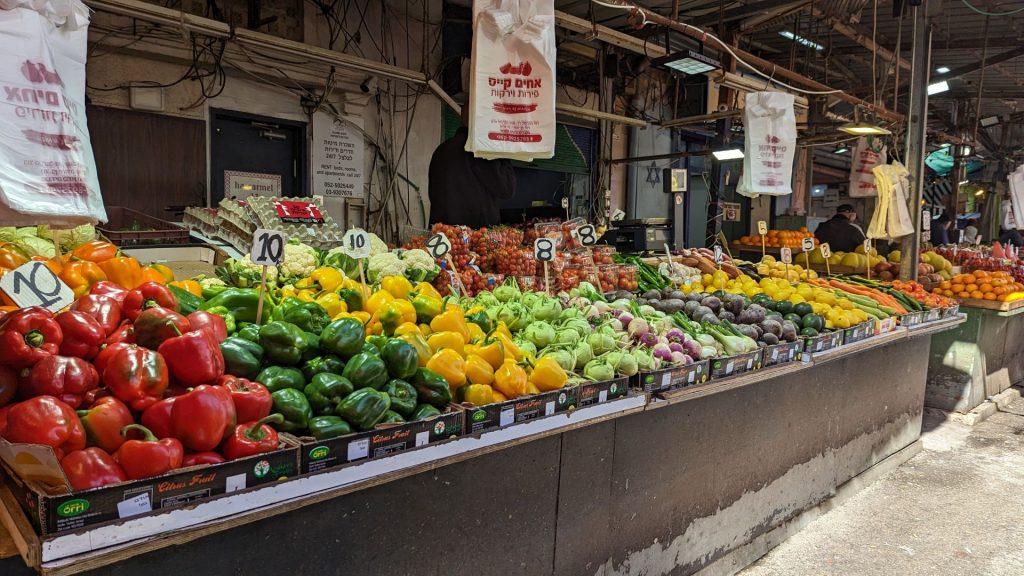
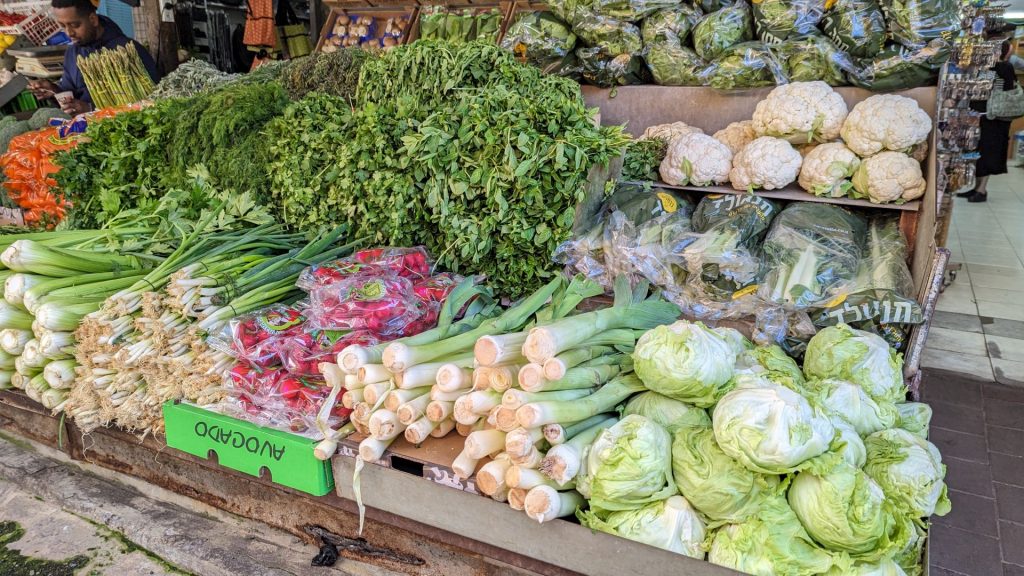
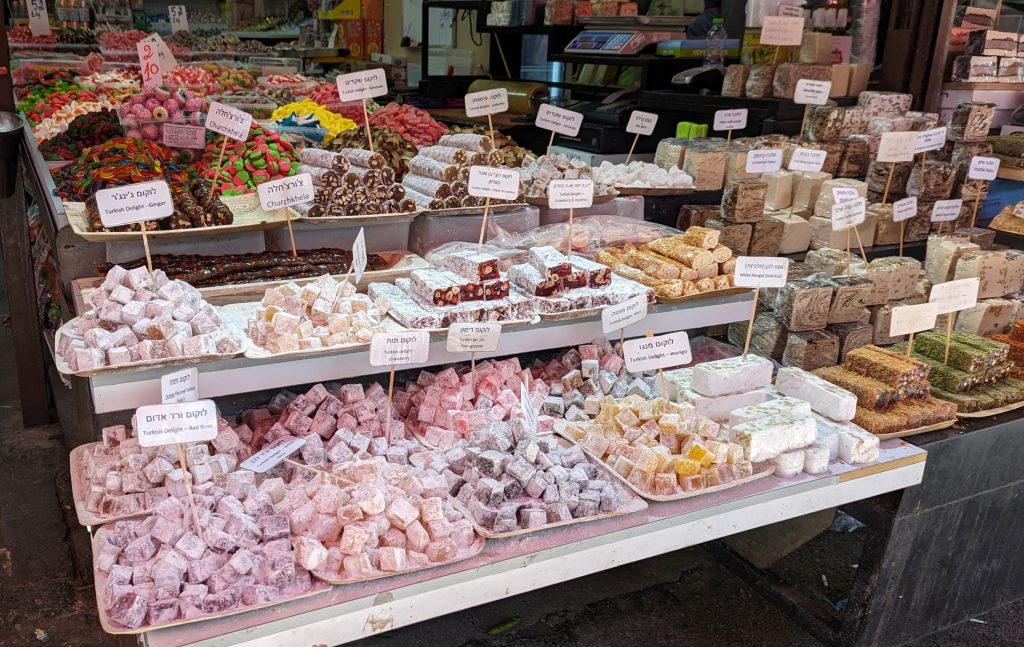
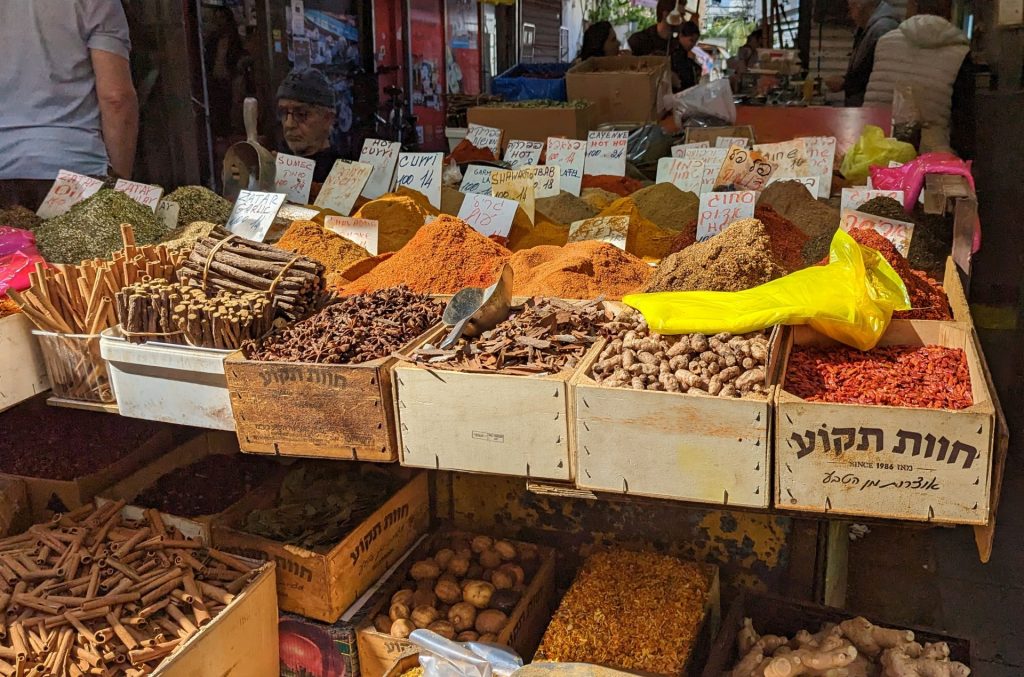
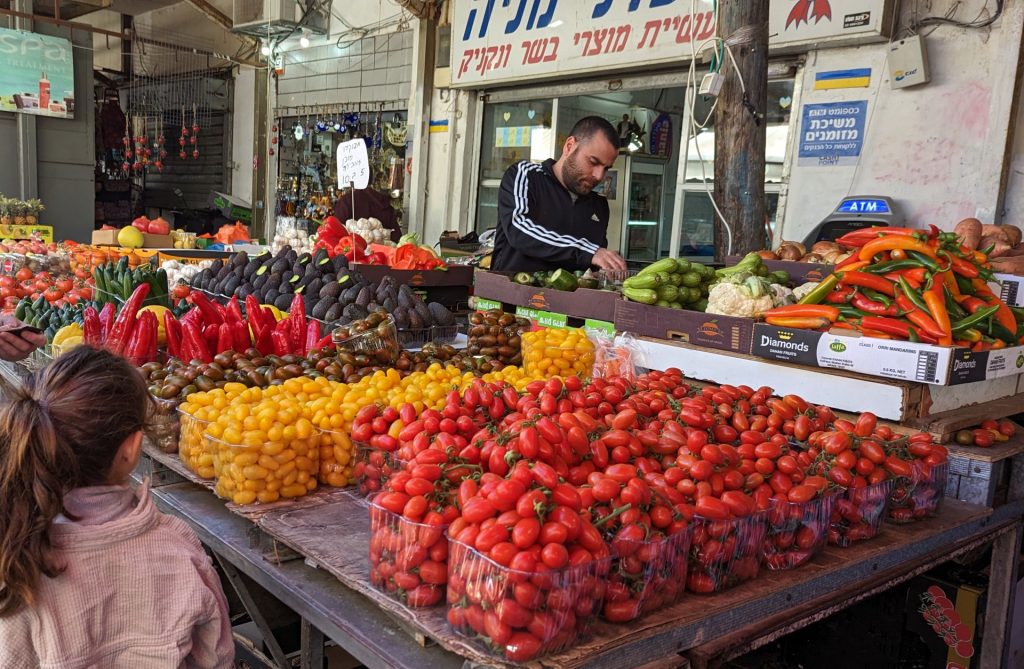
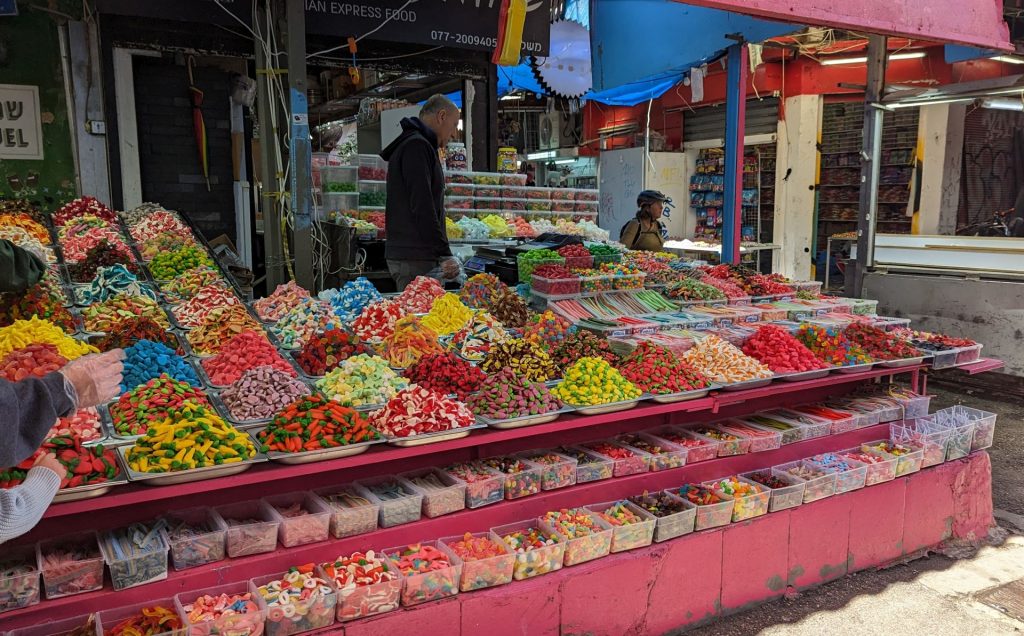
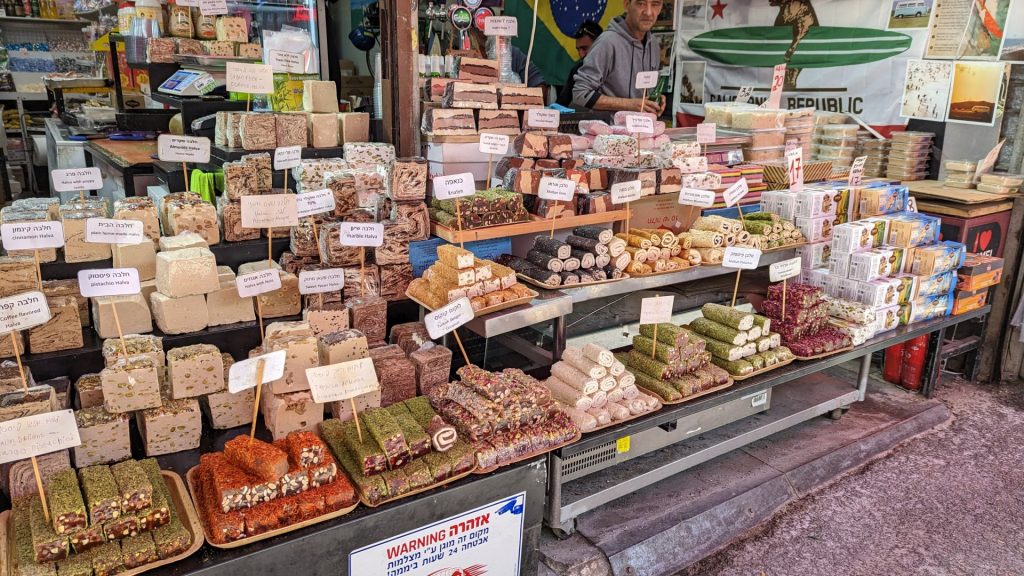
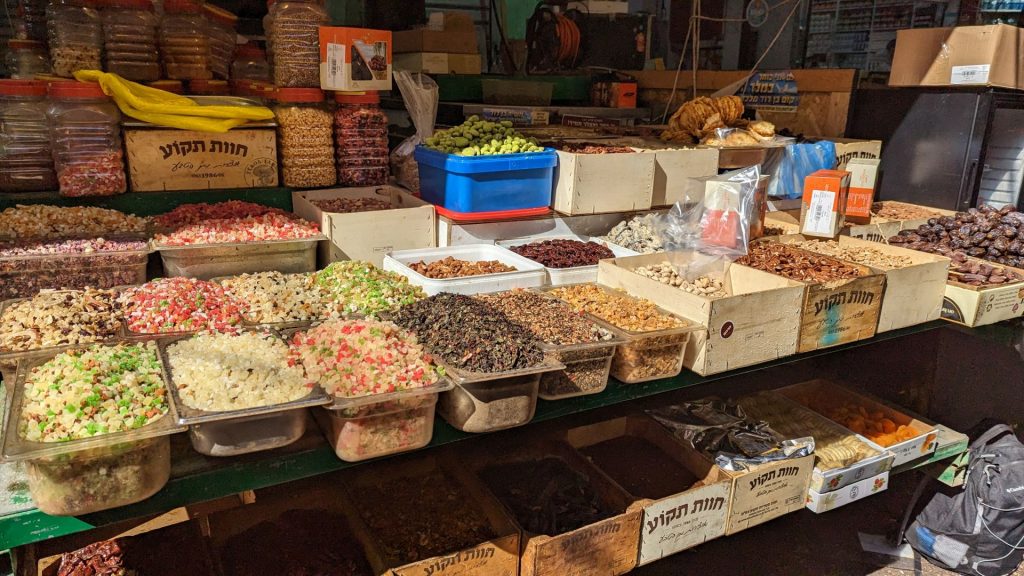
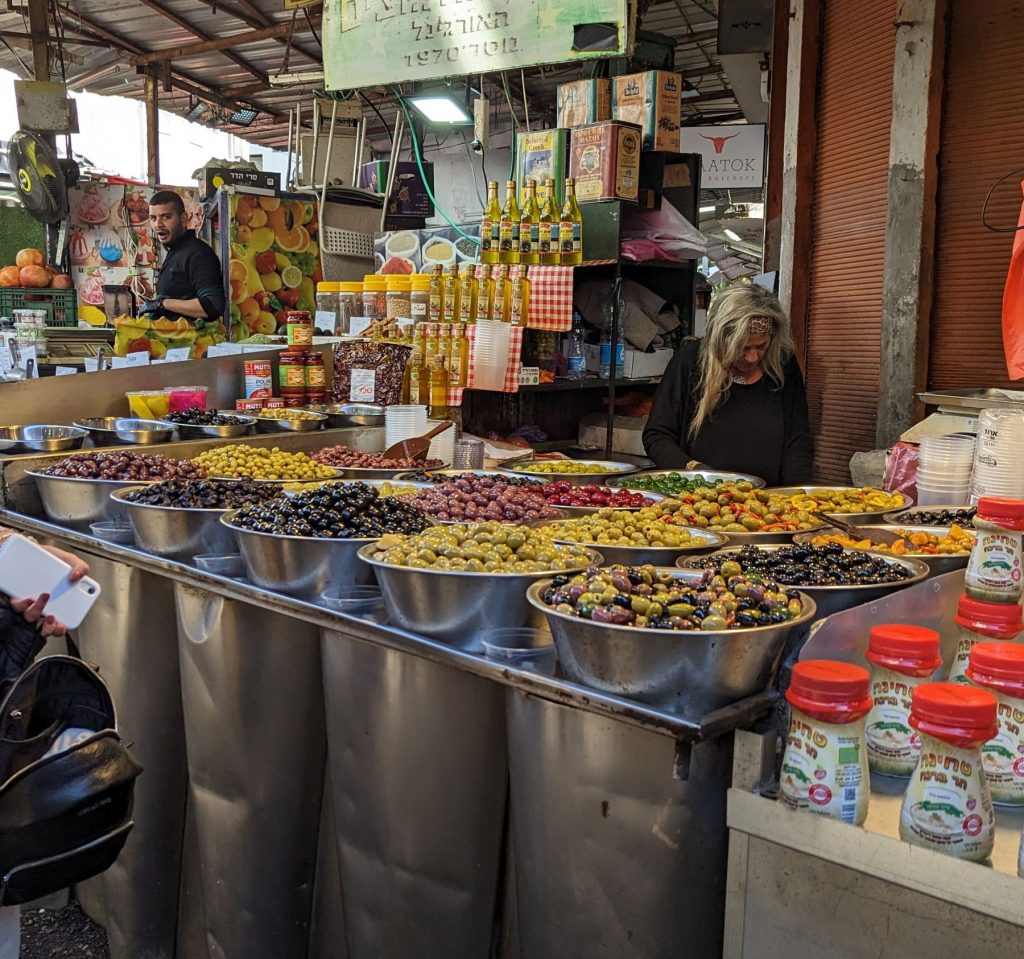
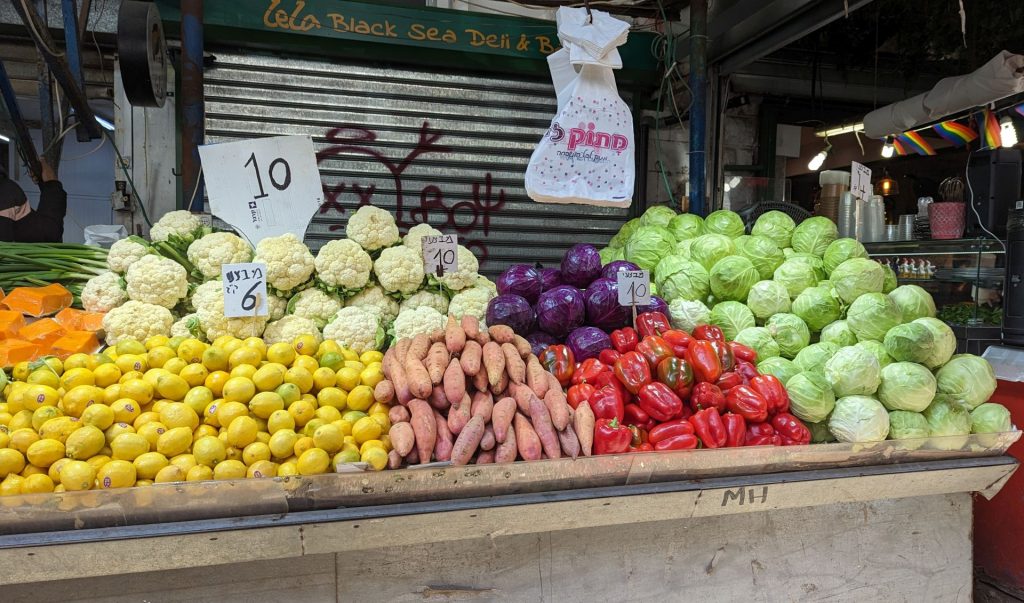
We stopped for lunch at an outdoor restaurant near Nachalat Binyamin. The waiter was so friendly. When he wasn’t serving us, he was sitting nearby singing loudly. He brought the bill to us in a box. Cute.
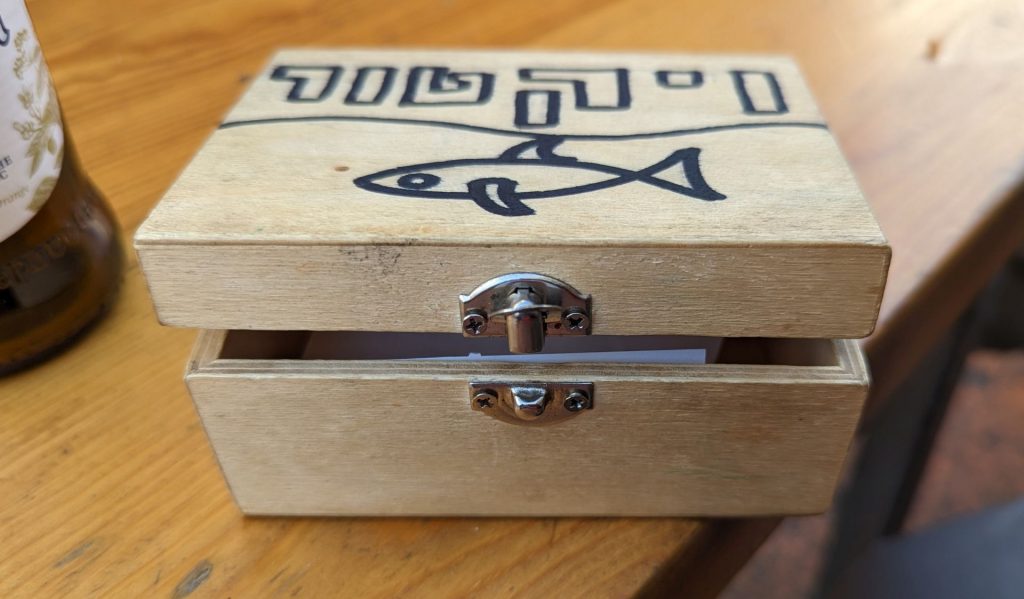
I’d read that it was a “must” to buy a gazoz, so I did from a corner storefront. A gazoz is a drink made of a variety of things, most of which I did not recognize. There is apparently a recipe book, which I wish to this day I had purchased.
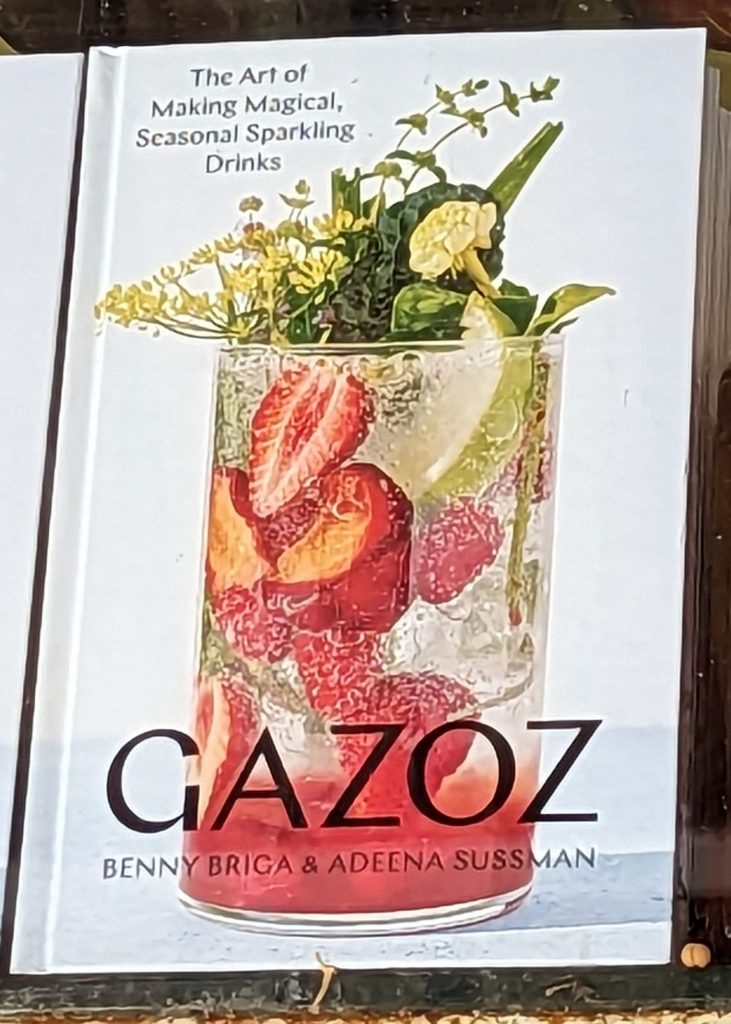
My gazoz both smelled and tasted very good! It is non-alcoholic, so if you ever go there, you can buy one for your kids as well as yourself.
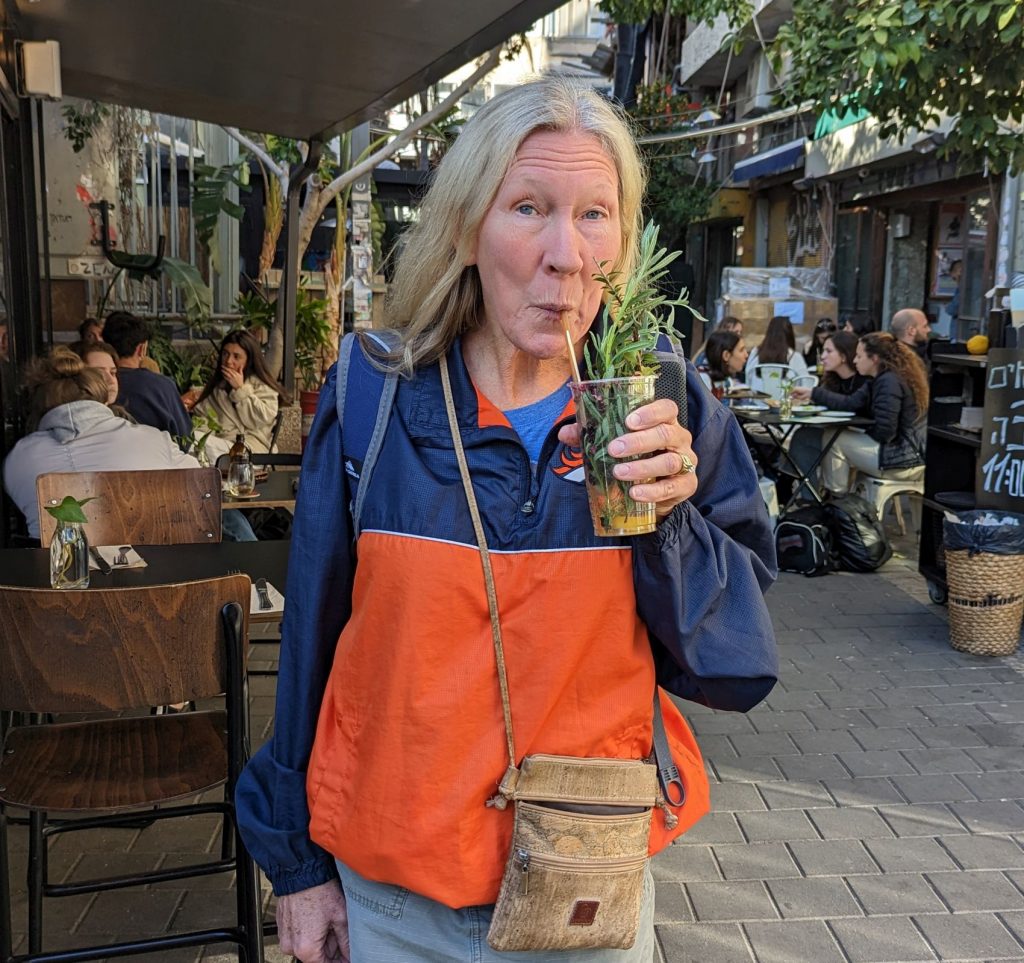
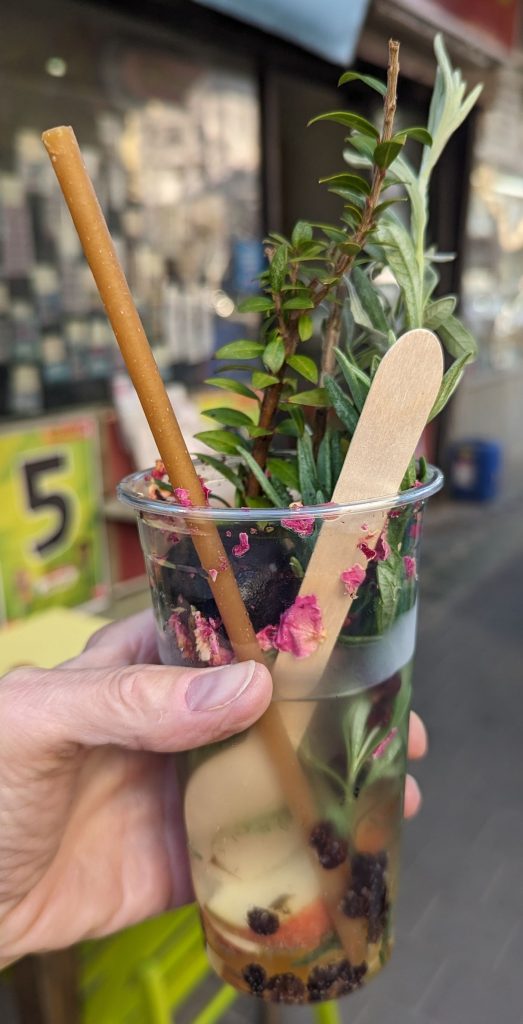
Michael didn’t get a gazoz because he’d purchased ice cream. I love how they made mountains/leaning towers of ice cream at the ice cream shop!
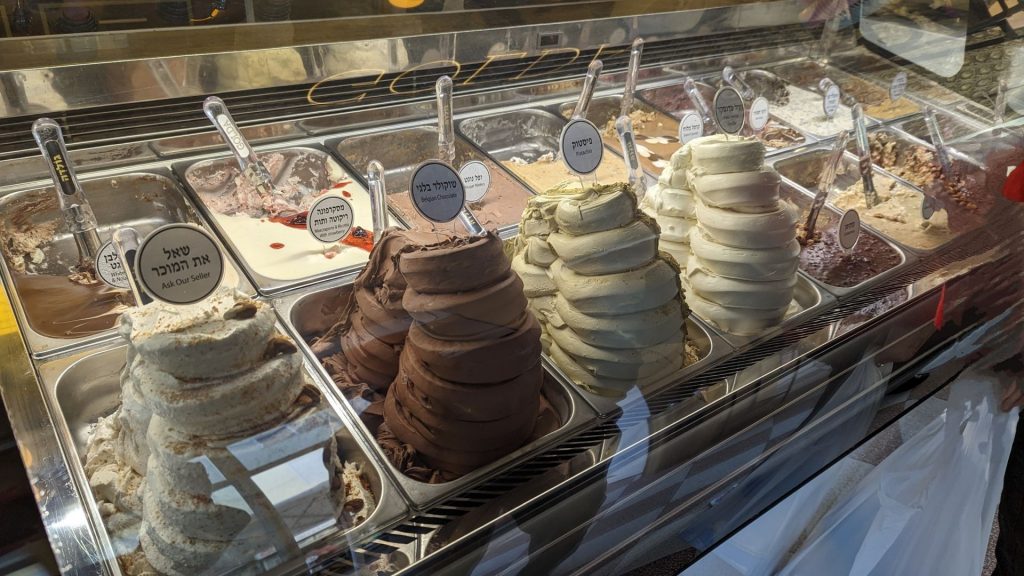
We were in this area because: 1) I wanted a gazoz, and 2) it was a Tuesday, so the Nachalat Binyamin Art Fair was open. It is the biggest and oldest art fair in Israel, and one of the most beautiful and esteemed in the world. They close off traffic on Tuesdays and Fridays to hold the fair on the street. There were a wide variety of things for sale. I almost bought a ring but I couldn’t find one that fit. Darn.
We then headed to Dizengoff Square to see the famous, accordion-style fountain by Israeli artist Yaacov Agam. You might have noticed that I was wearing my Broncos windbreaker. Three young men near the fountain saw me and shouted, “Peyton Manning, Peyton Manning!” while sporting big smiles. I gave them a thumbs up.
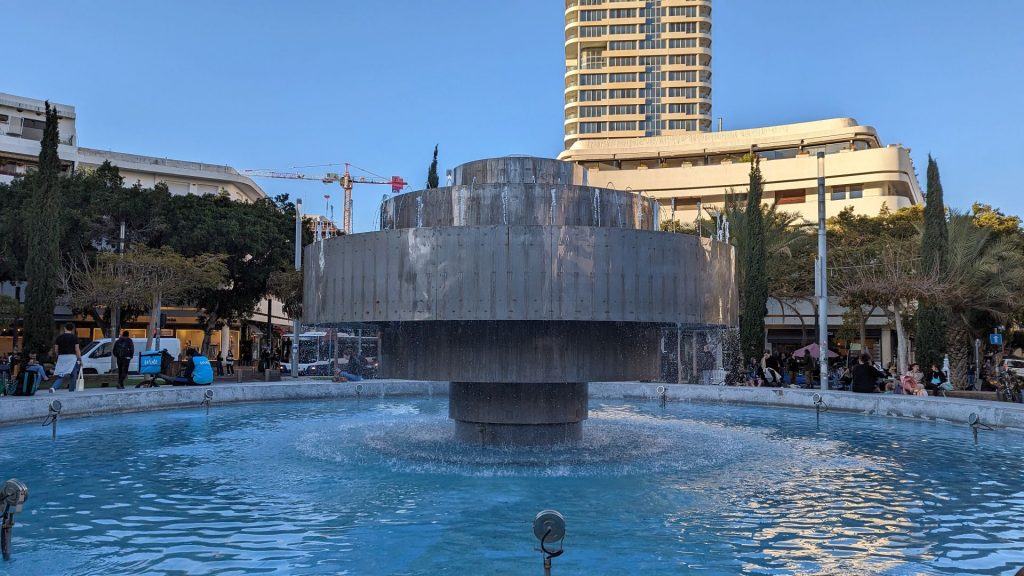
The next day, Wednesday, we took the train to Jerusalem.
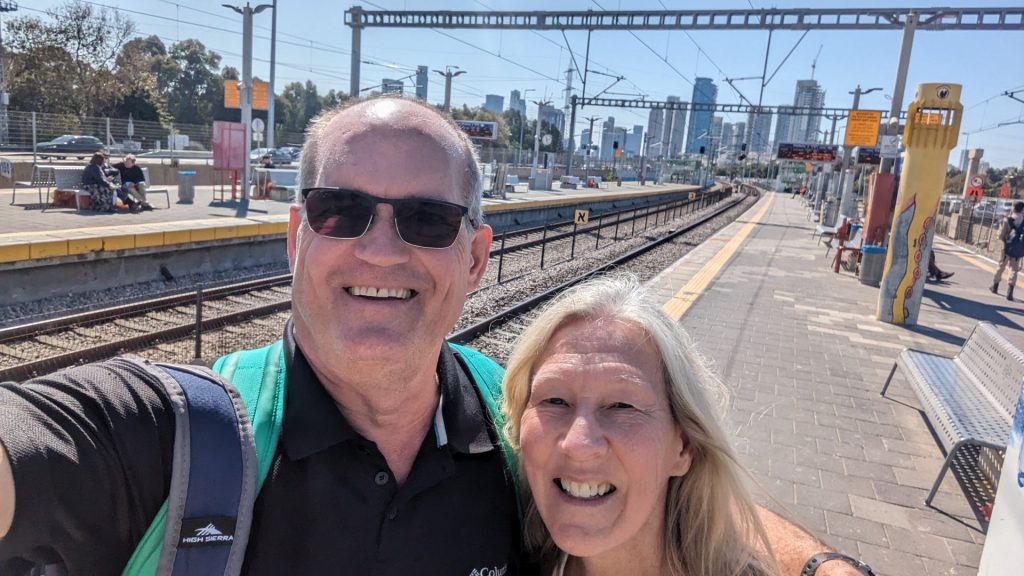
When we exited the train, we road up a very long escalator. Then we rode another one. And another one. We had no idea we had been so far underground, but it did explain why my ears kept popping during the ride!
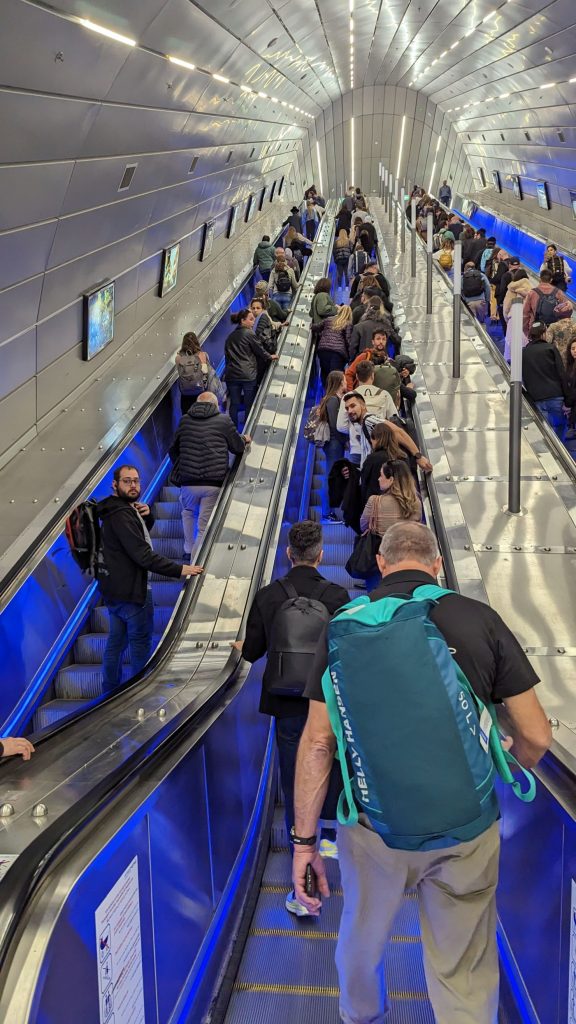
We arrived midday so our room wasn’t ready. The gentleman at the counter offered to hold our bags for us and put them in our room when it was ready. He recommended a couple of things to do and we opted to go to the Mount of Olives (this had not been on my itinerary, but I allowed it <smile>). The hotel (Hotel Addar) was charming.
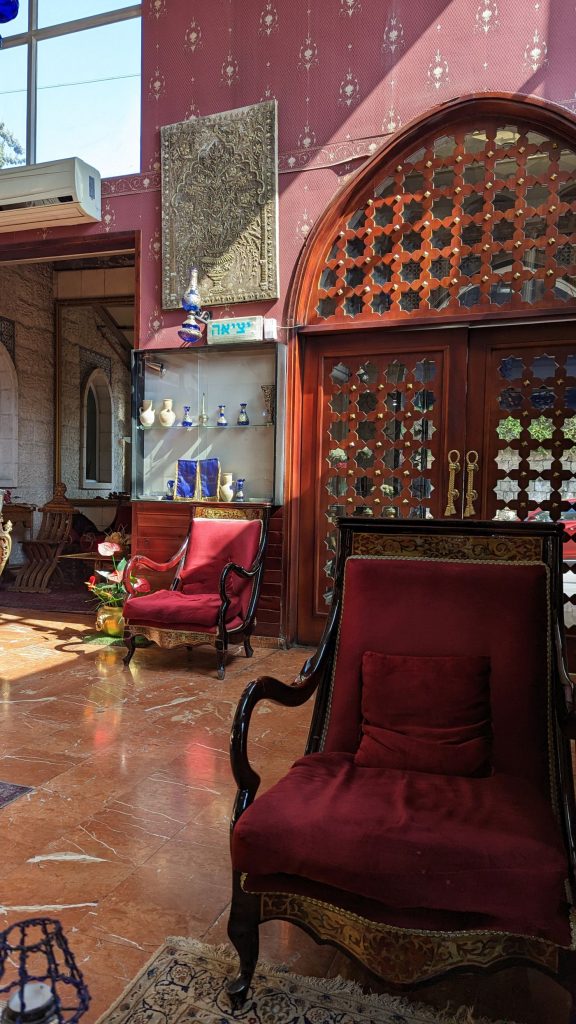
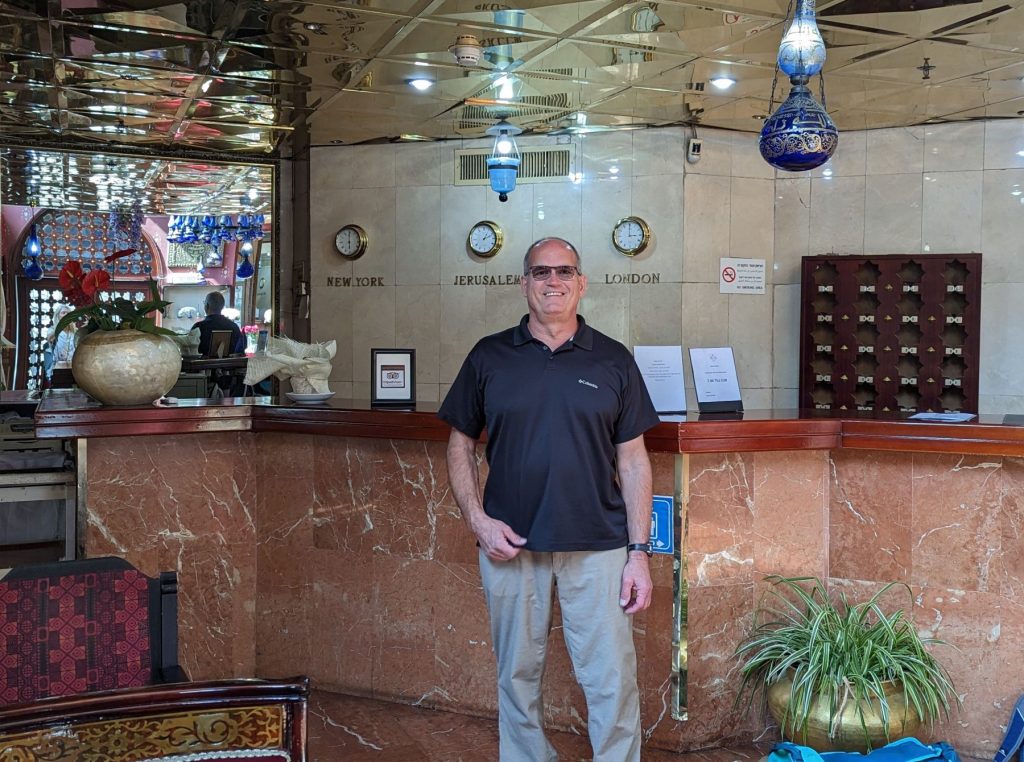
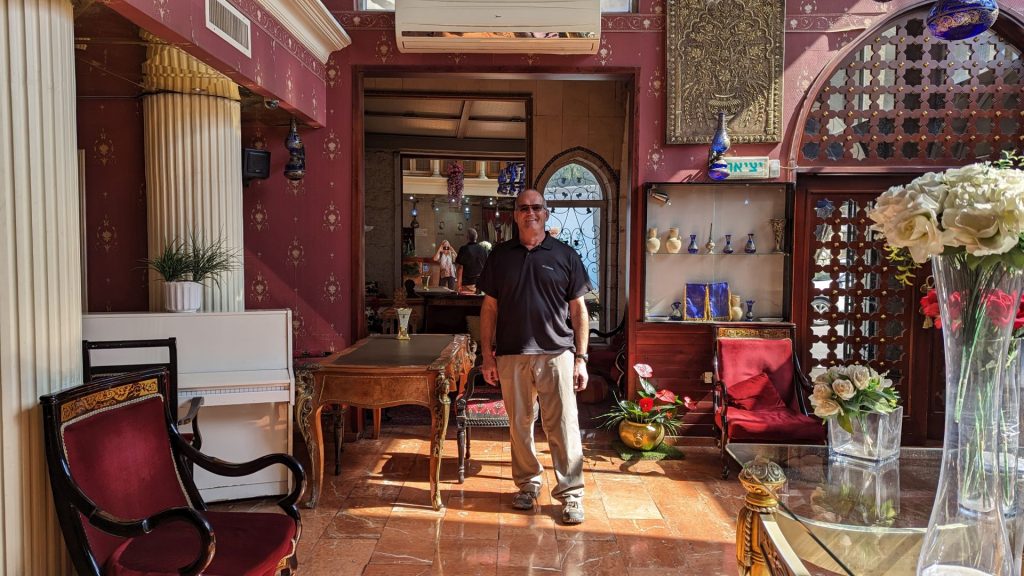
We took the light rail to the Jaffa stop and had lunch at “Mike’s Place.” We had a nice conversation with two gentlemen while we ate. Both of them relocated to Jerusalem from the U.S. because they feel at home here.
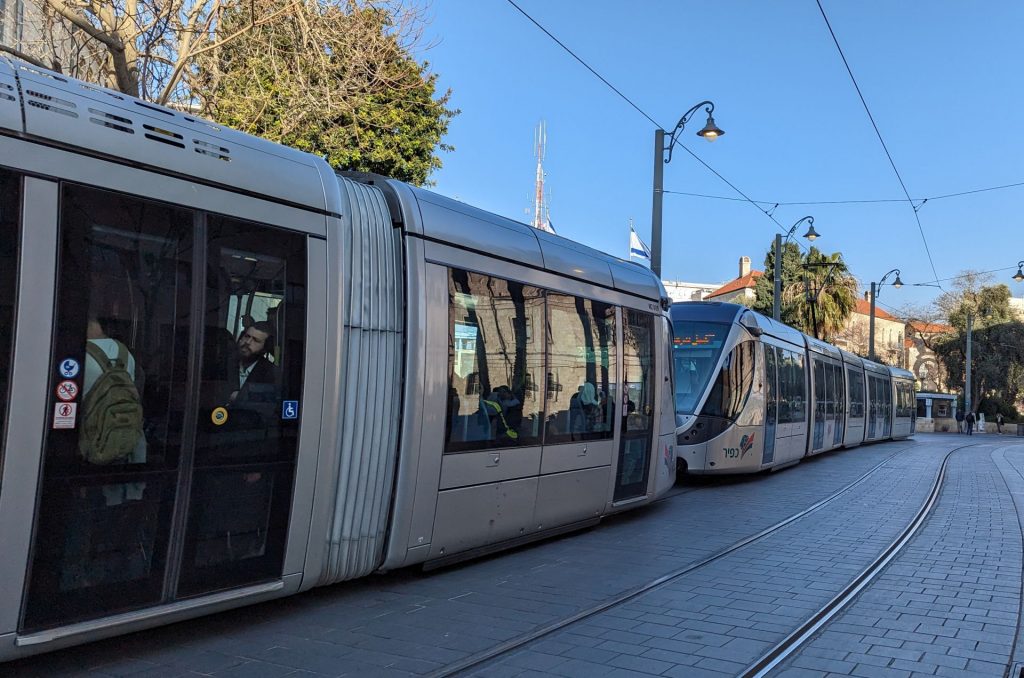
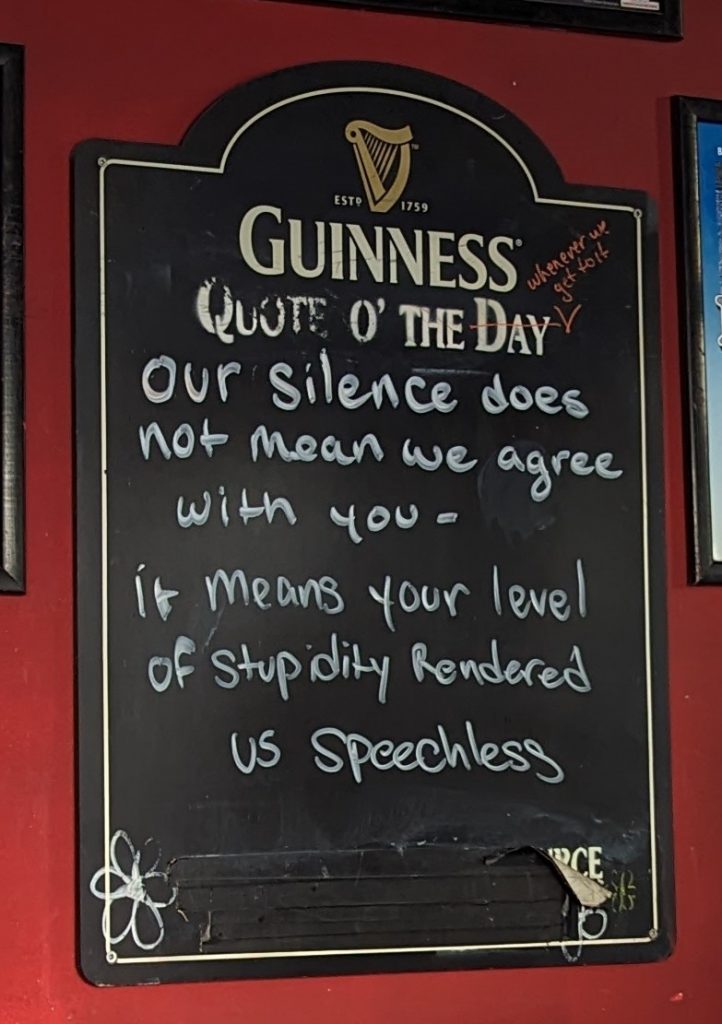
After a “super good for us” lunch of fried chicken, fried onion rings, French fries, and beer, we headed to the Mount of Olives.
We first visited the Church of All Nations, which stands at the foot of the Mount of Olives in Gethsemane. This church is considered a masterpiece. The modern church was created by the Italian architect Antonio Barluzzi. The church closely follows the shape of the ancient Byzantine church discovered during the construction works on the new sanctuary.
The garden of Gethsemane is one of the most sacred places in Jerusalem. It is where the Gospel of Matthew tells us that Jesus spent his last night praying. The Grotto of Gethsemane (beside Mary’s Tomb) is identified as the place where Jesus was arrested. The olive trees in the Garden of Olives are hundreds of years old, which is just really cool.
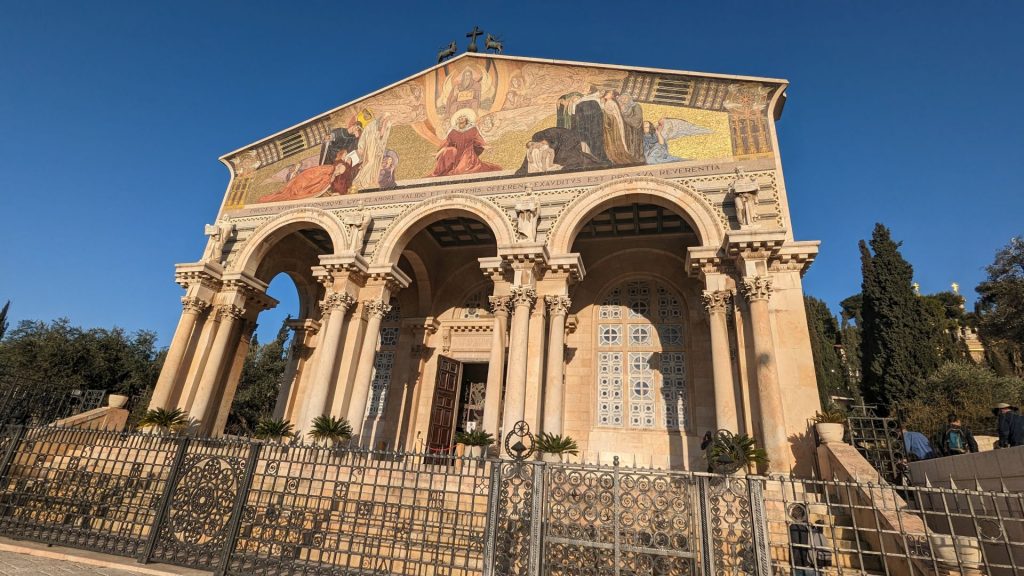
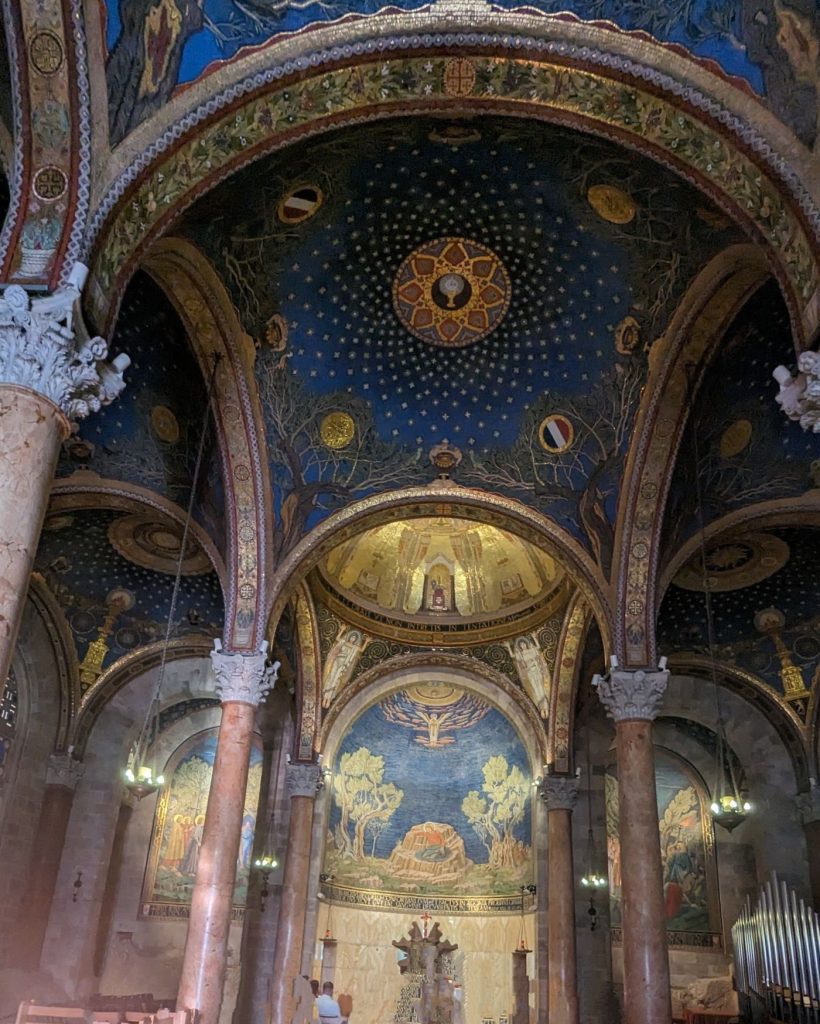
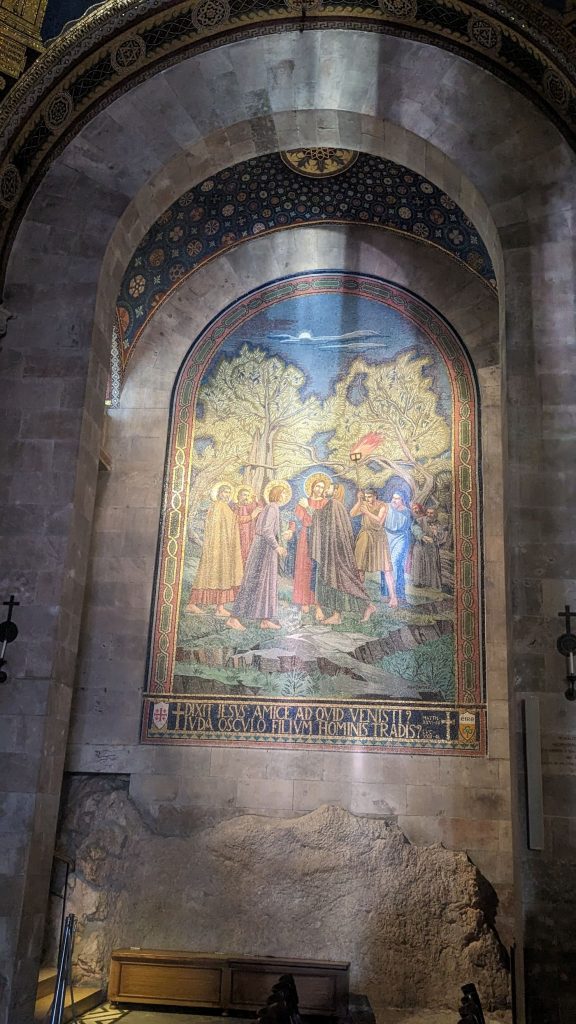
The Mount of Olives calls forth many memories of events in Jesus’ life, such as the teaching of the Lord’s Prayer, the weeping over Jerusalem, where he came from on a donkey when he entered Jerusalem in the week leading up to his crucifixion, and from where Jesus ascended into heaven. (This is for those who believe this, we are not proselytizing.) I am not going to lie: it was kind of amazing to be somewhere I’ve read about since I was a child.
Turns out you can walk to the top of the Mount of Olives via steps that pass through housing units. We did. I think there were roughly two gazillion steps. Proof:
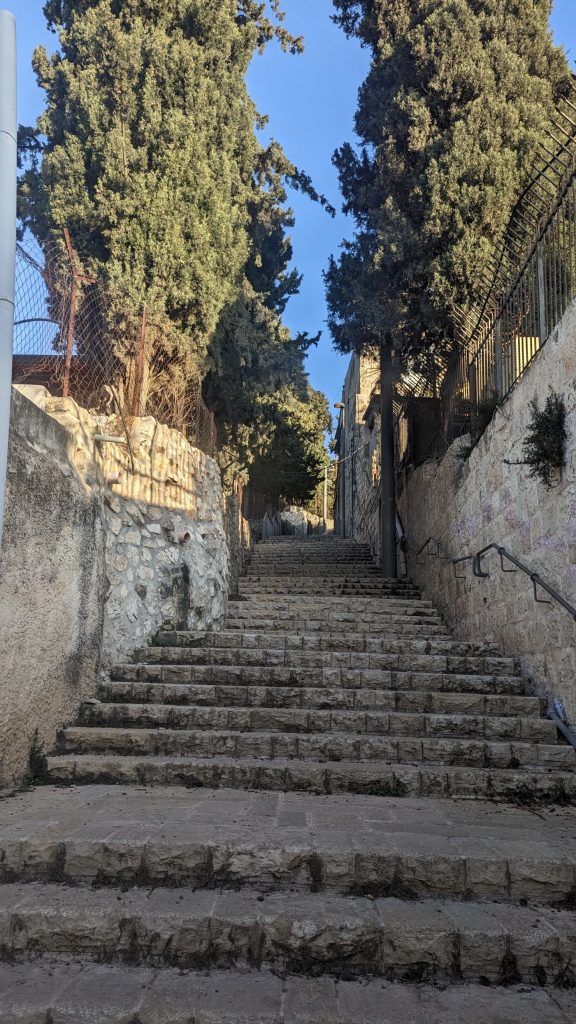
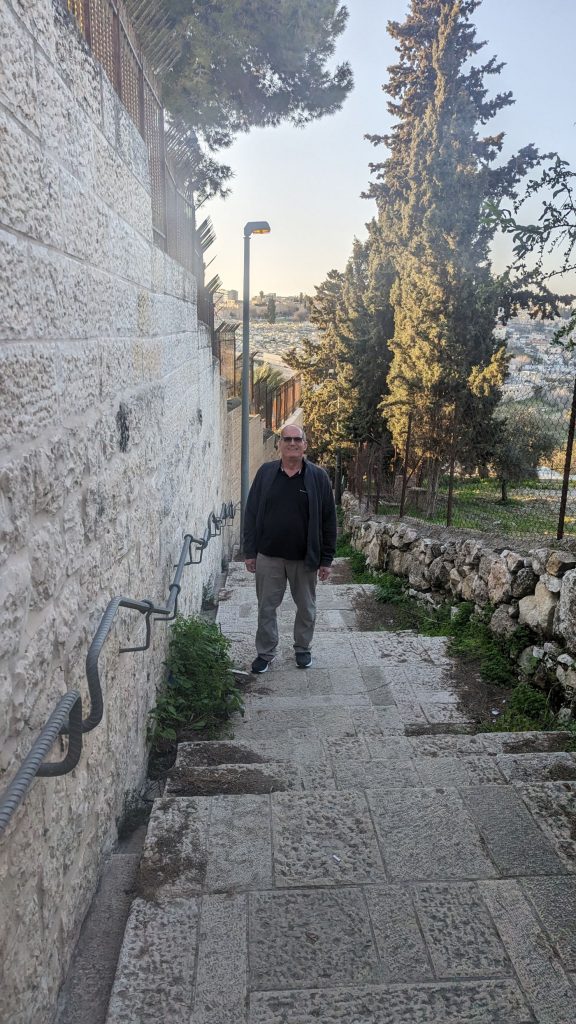
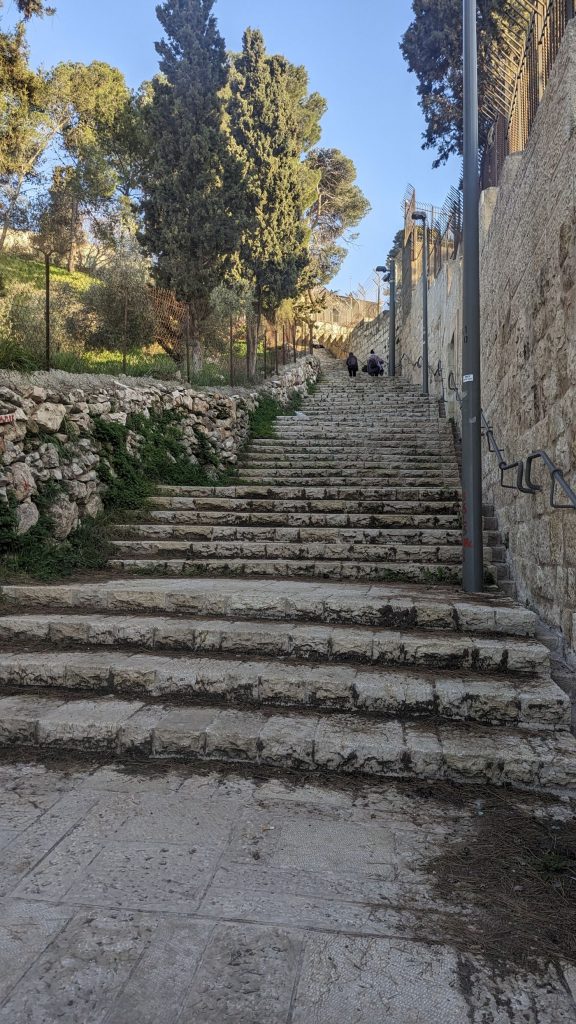
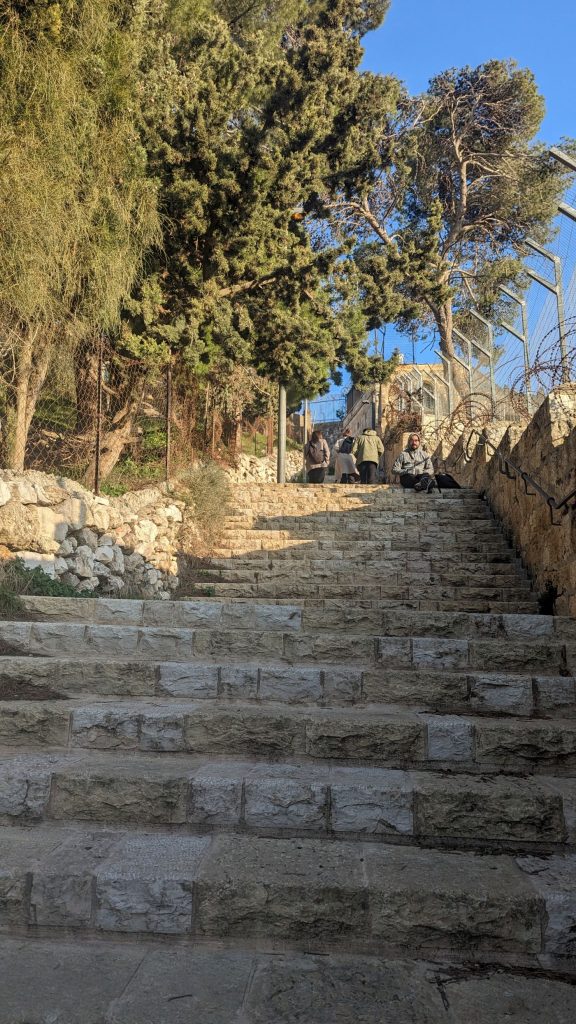
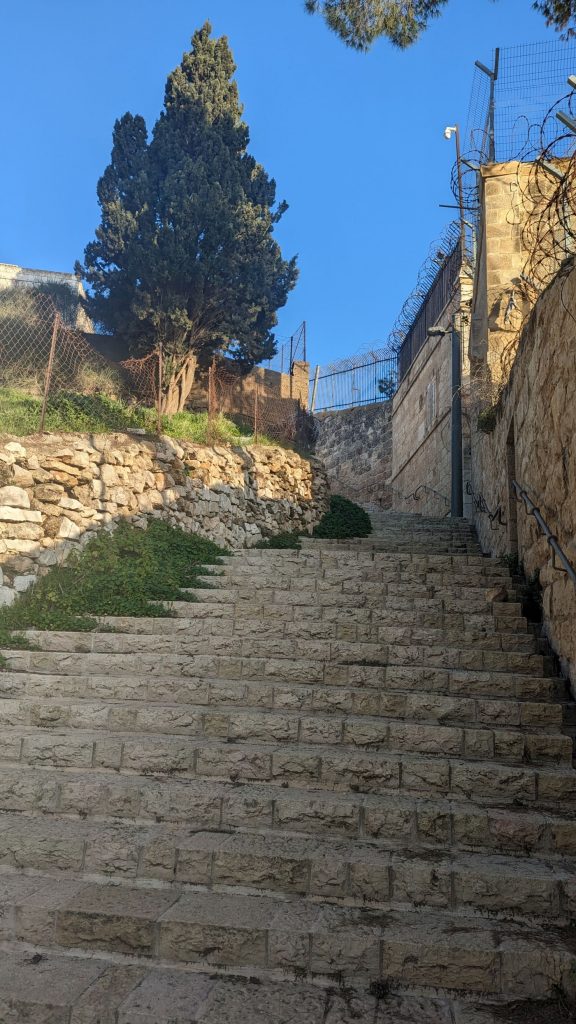
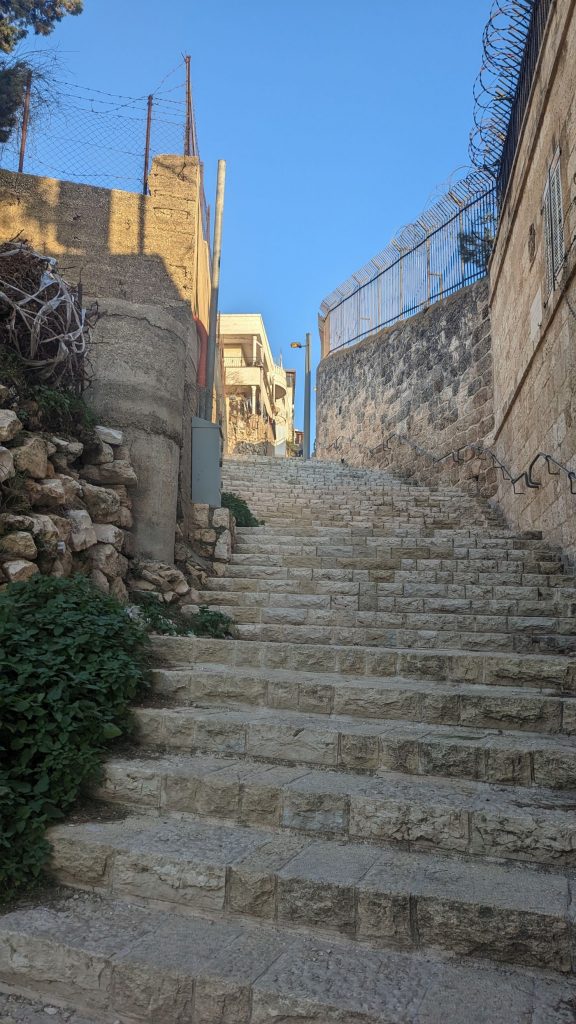
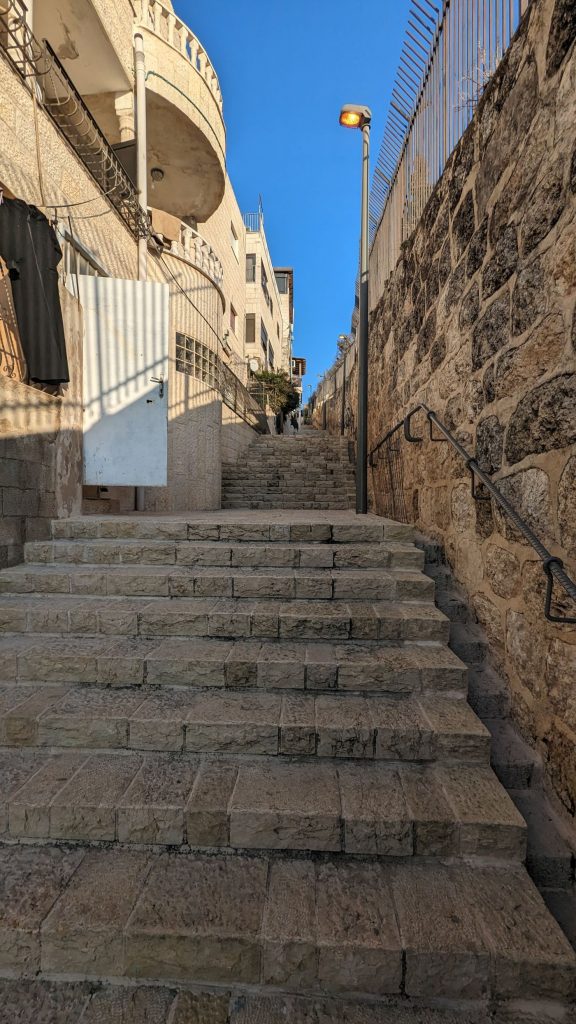
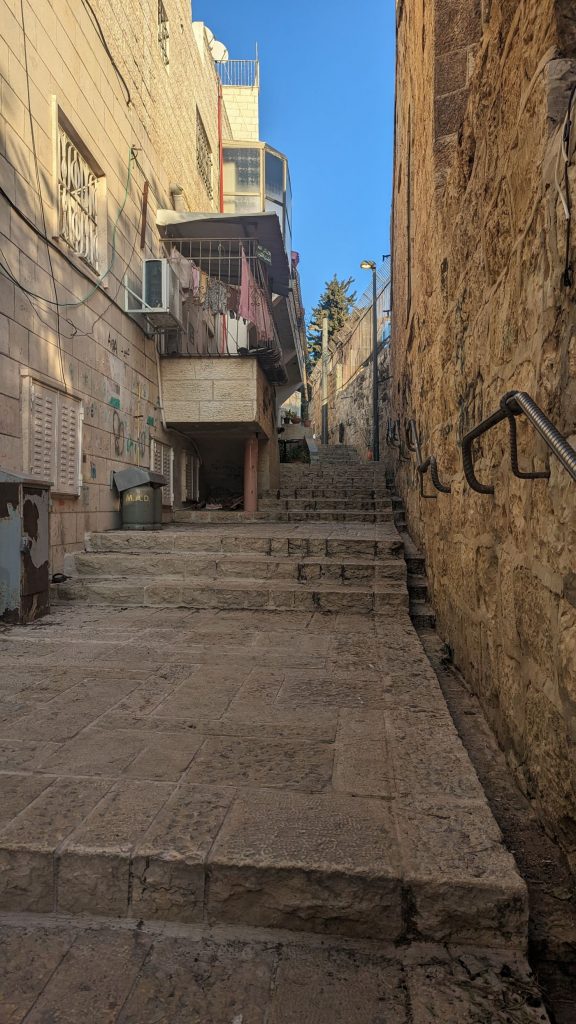
Anywho . . . we made it to the top. Really the only thing to do from up top is to look out and down. It was a pretty chilly day so we waited just until the sun got low in the sky and left.
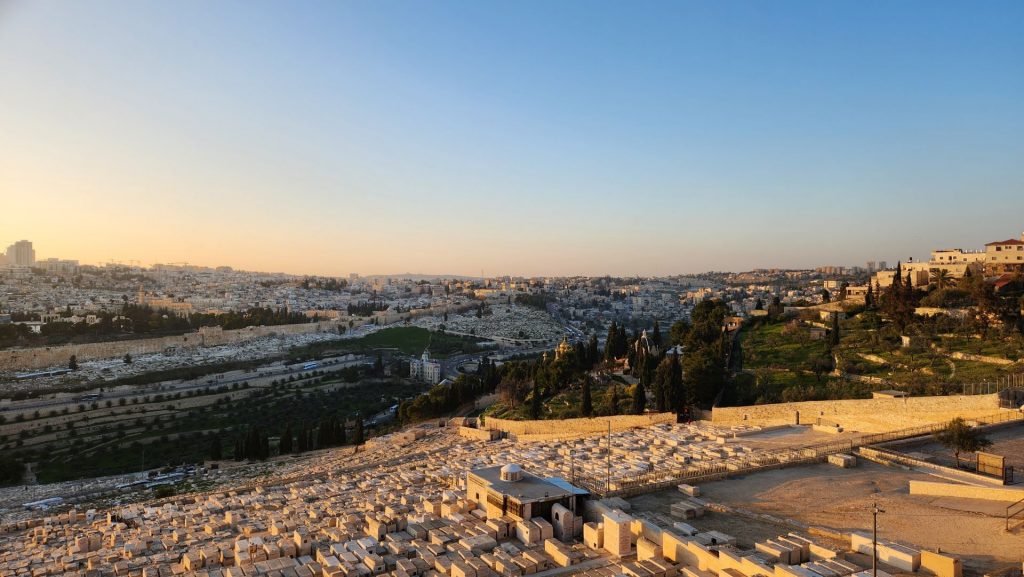
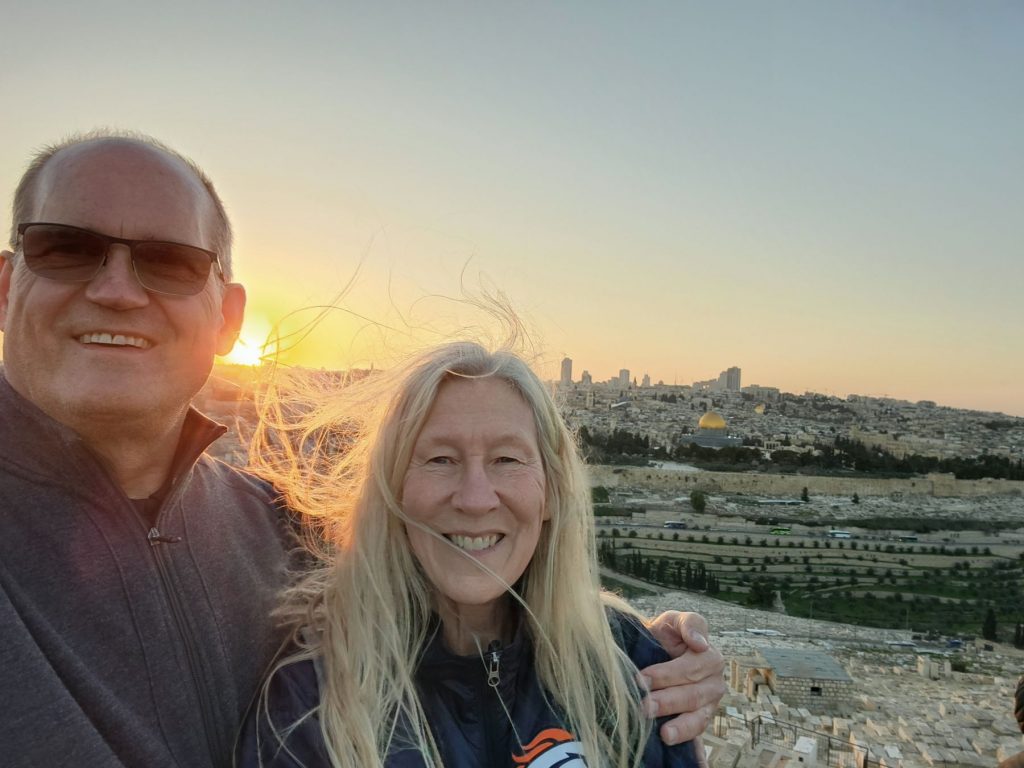
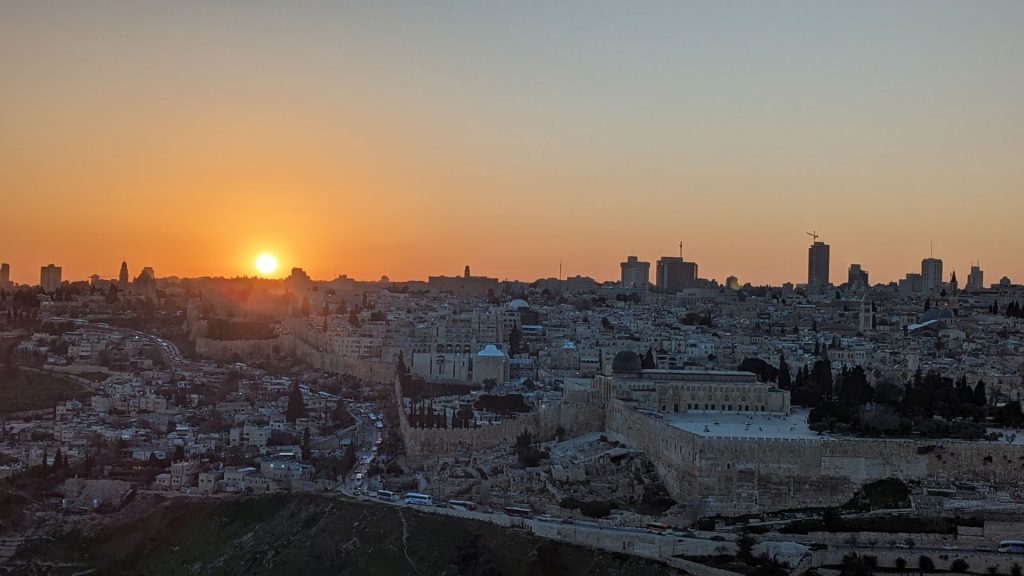
We’d decided to take a taxi back and luckily there was a driver just waiting for us. 🙂 He took us to Old Jerusalem, where we were going to see the night light show at the Tower of David. He dropped us off in the Armenian Quarter so we had dinner there.
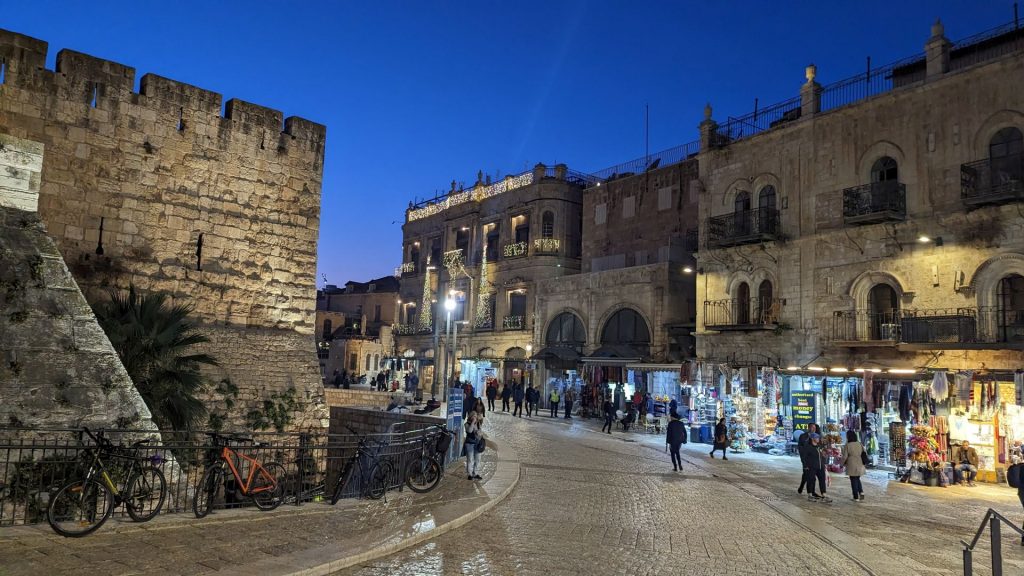
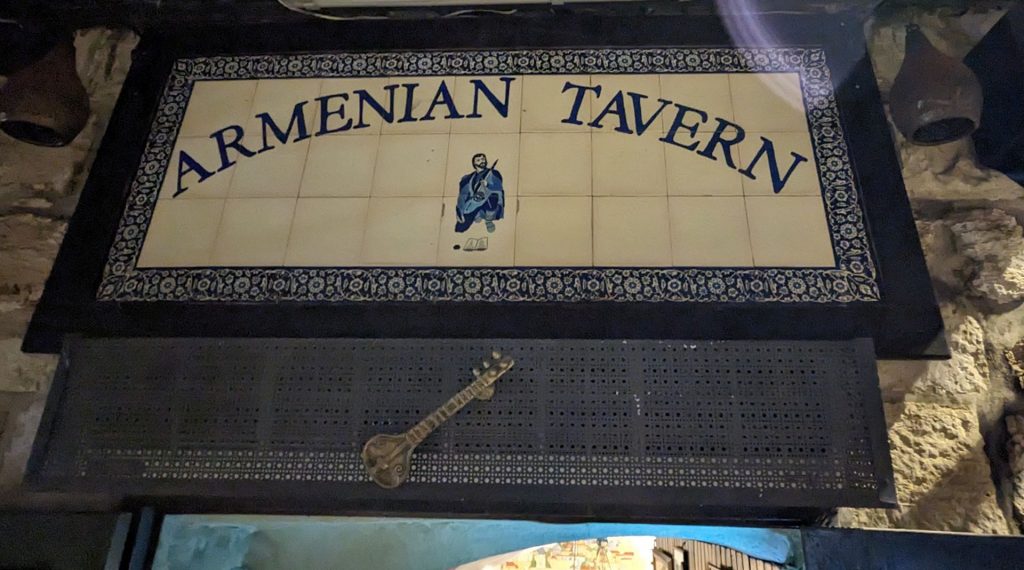
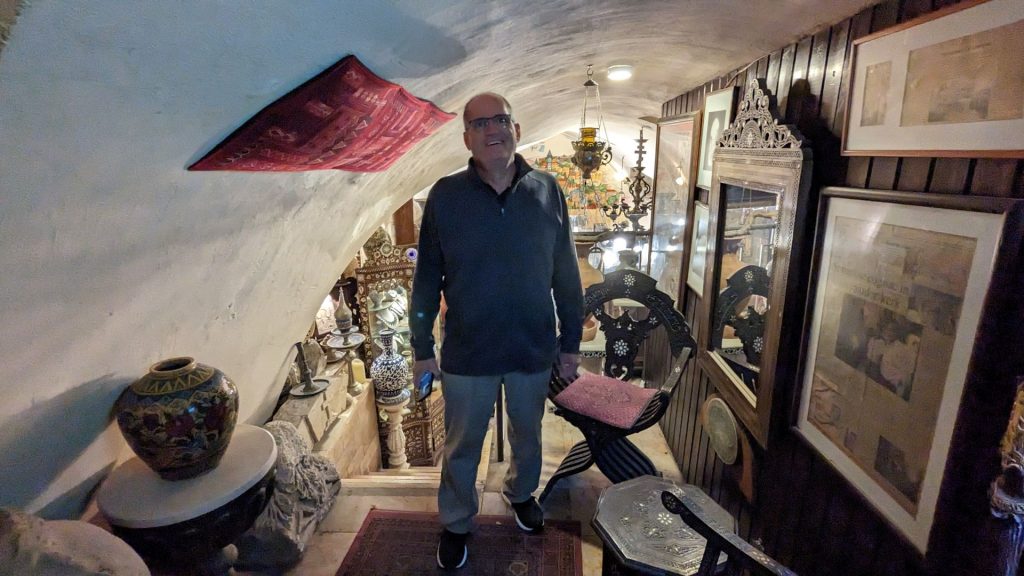
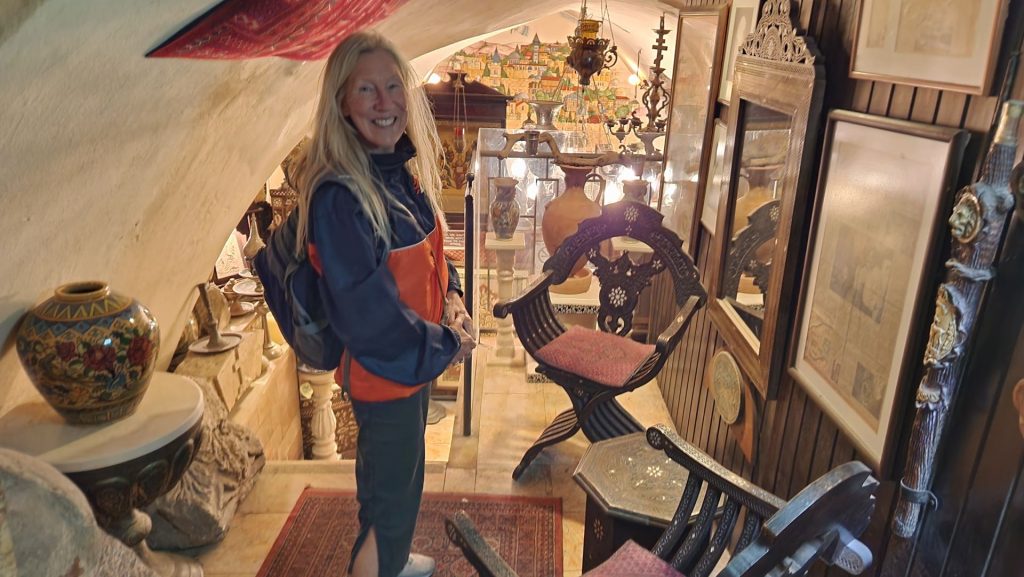
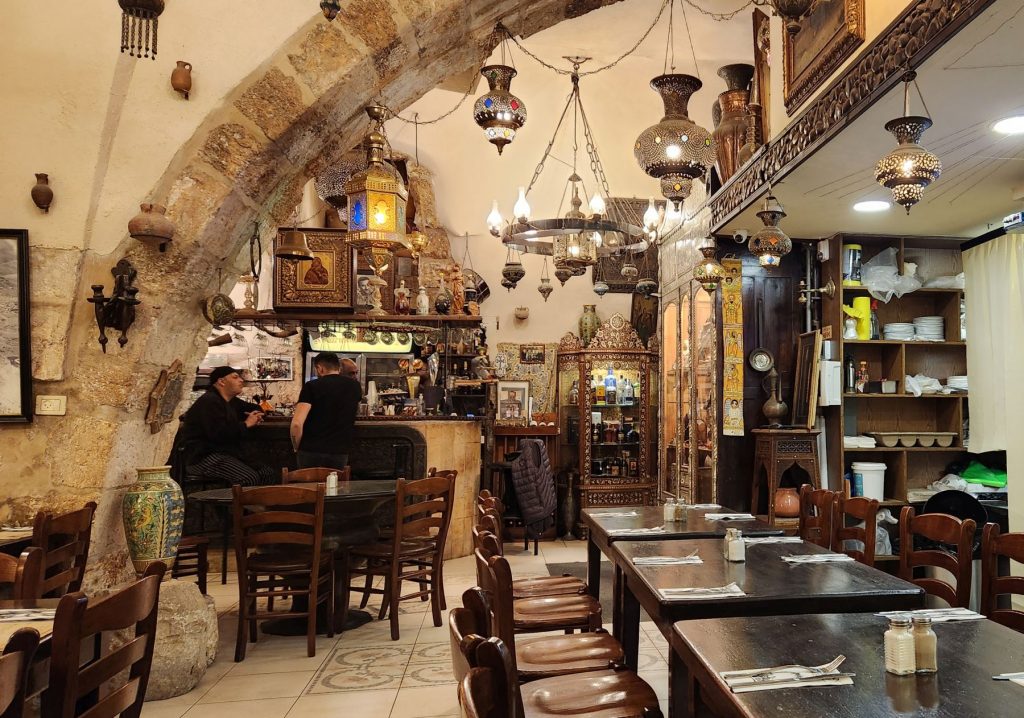
I was happy that I’d thought ahead and purchased this blanket, which was waiting for us at the entrance. We needed it to stay somewhat warm (really just slightly less cold) during the light show. And it is a souvenir as well!
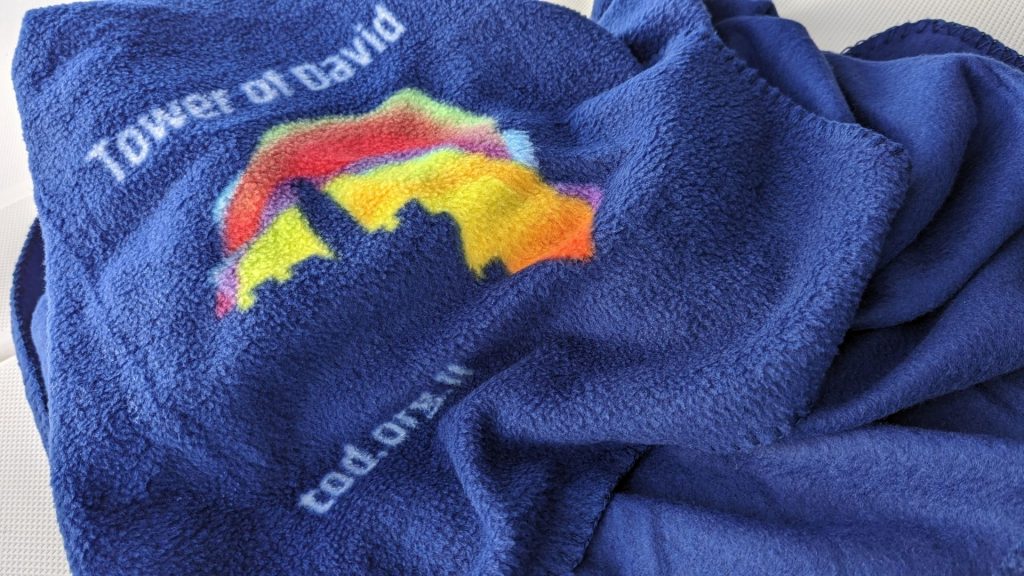
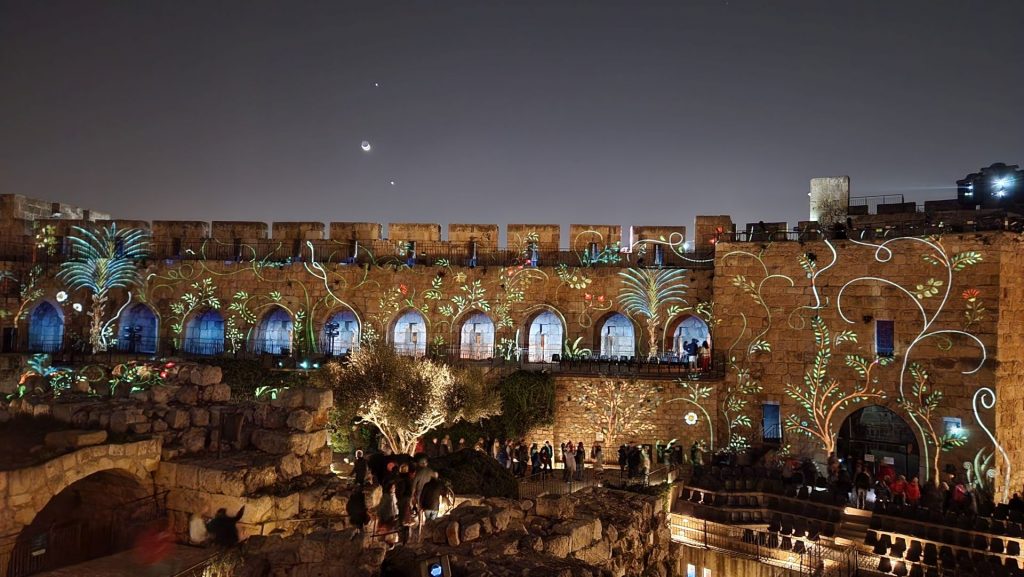
We can’t show you pictures of the actual show because it wasn’t permitted. (This is just an example of the lights that were displayed as we walked to the seating area.) This is how the 40-minute show is described on their website: “Marvelous images, original sound track and breathtaking video are woven together to create a unique experience, which takes viewers on a historic journey through thousands of years. Using a sophisticated, innovative laser projection system, the performance brings to life the reigns of kings and queens who rose and fell, holy buildings, armies which fought for Jerusalem, and cultures, religions and myths which flourished here. You are invited to view and be moved by the exciting and unique stories of Jerusalem against the wonderful setting of the Old City.” I recommend this if you visit Old Jerusalem. The show ended with “Pray for peace for Jerusalem” displayed in Hebrew, Arabic, and English. It was very moving. This is such an amazing city!
February 23: On tap for the next day was a tour of Old and new Jerusalem. We selected Bein Harim as the tour company and were extremely happy with them. We were picked up across the street from our hotel and dropped off at the same spot. The guide, Daniel, was incredible! I am sharing this in case any of you decide to book a tour.
There is so much to see and tell about this beautiful Old City. We are just sharing a couple of tidbits. We chose to focus on The Church of the Holy Sepulchre (a church in the Christian Quarter of the Old City), some of the stages of the Cross (I was not familiar with them since I am not Catholic, but I had heard of them), the Western Wall, and some random pictures of the markets and streets.
The Church of the Holy Sepulchre
According to the Bible (John 19:41–42), Jesus’ tomb was close to the place of the Crucifixion, and so the church was planned to enclose the site of both the cross and the tomb. I am going to just copy and paste from Wikipedia because it offers a good overview:
“The Church of the Holy Sepulchre is a church in the Christian Quarter of the Old City of Jerusalem. According to traditions dating back to the 4th century, it contains two sites considered holy in Christianity: the site where Jesus was crucified, at a place known as Calvary or Golgotha, and Jesus’s empty tomb, which is where he was buried and resurrected. Each time the church was rebuilt, some of the antiquities from the preceding structure were used in the newer renovation. The tomb itself is enclosed by a 19th-century shrine called the Aedicule. The Status Quo, an understanding between religious communities dating to 1757, applies to the site.
Within the church proper are the last four stations of the Cross of the Via Dolorosa, representing the final episodes of the Passion of Jesus. The church has been a major Christian pilgrimage destination since its creation in the 4th century, as the traditional site of the resurrection of Christ, thus its original Greek name, Church of the Anastasis (‘Resurrection’).
Control of the church itself is shared among several Christian denominations and secular entities in complicated arrangements essentially unchanged for over 160 years, and some for much longer. The main denominations sharing property over parts of the church are the Roman Catholic, Greek Orthodox and Armenian Apostolic, and to a lesser degree the Coptic, Syriac, and Ethiopian Orthodox churches.”
I was particularly interested in the Status Quo. Again from Wikipedia (emphasis mine):
“The Status Quo is an understanding among religious communities with respect to nine shared religious sites in Jerusalem and Bethlehem . . . The status quo stemmed from a firman (decree) of Ottoman sultan Osman III in 1757 that preserved the division of ownership and responsibilities of various Christian holy places. Further firmans issued in 1852 and 1853 affirmed that no changes could be made without consensus from all six Christian communities . . . . The 1929 summary prepared by L. G. A. Cust, The Status Quo in the Holy Places, became the standard text on the subject, and the details were further formalized in the 1949 United Nations Conciliation Commission after the 1947–1949 Palestine war.”
The Status Quo has remained largely intact from the 18th century to the present. Wow! But my favorite tidbit is about the impact the Status Quo has on the “immovable ladder.” When our guide told us about it, I thought he was kidding. He wasn’t! The so-called immovable ladder sits under the window of the Church of the Holy Sepulchre. It was in place by 1728 and has remained there ever since the 1757 status quo was established, aside from being temporarily moved twice. The ladder is referred to as immovable due to the agreement of the Status Quo that no cleric of the six Churches may move, rearrange, or alter any property without the consent of the other five orders. Now that is taking an agreement seriously!
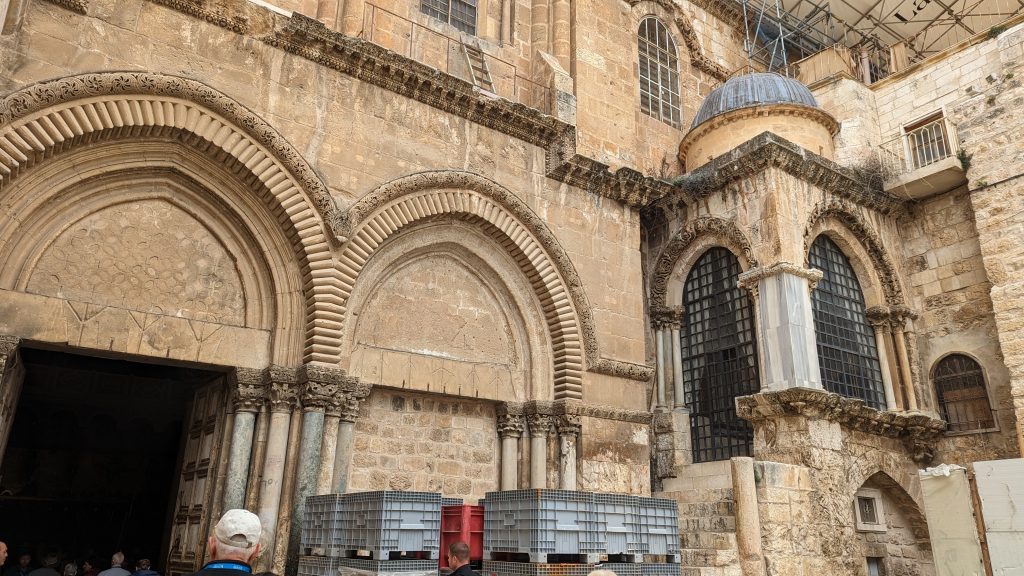
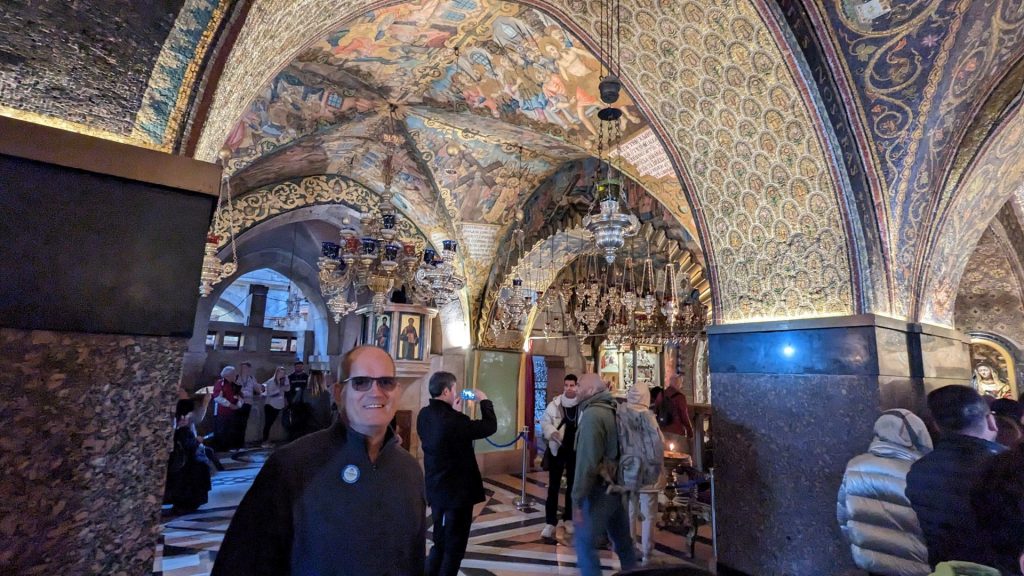
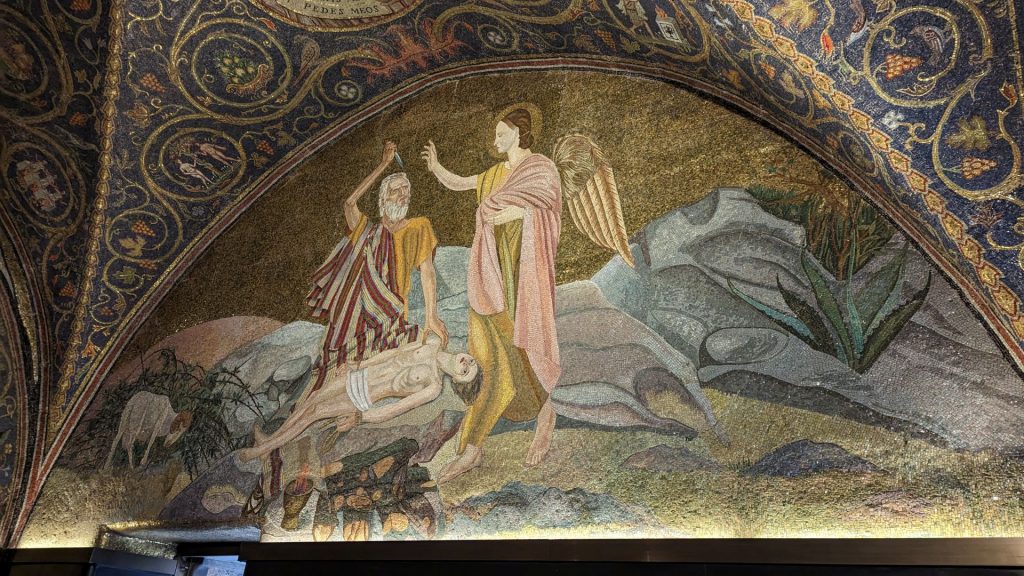
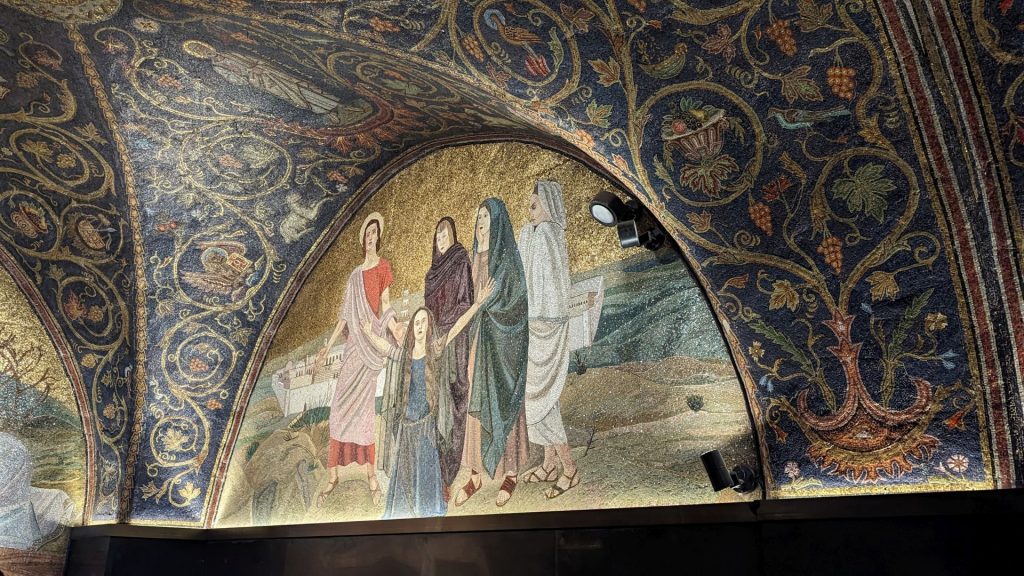
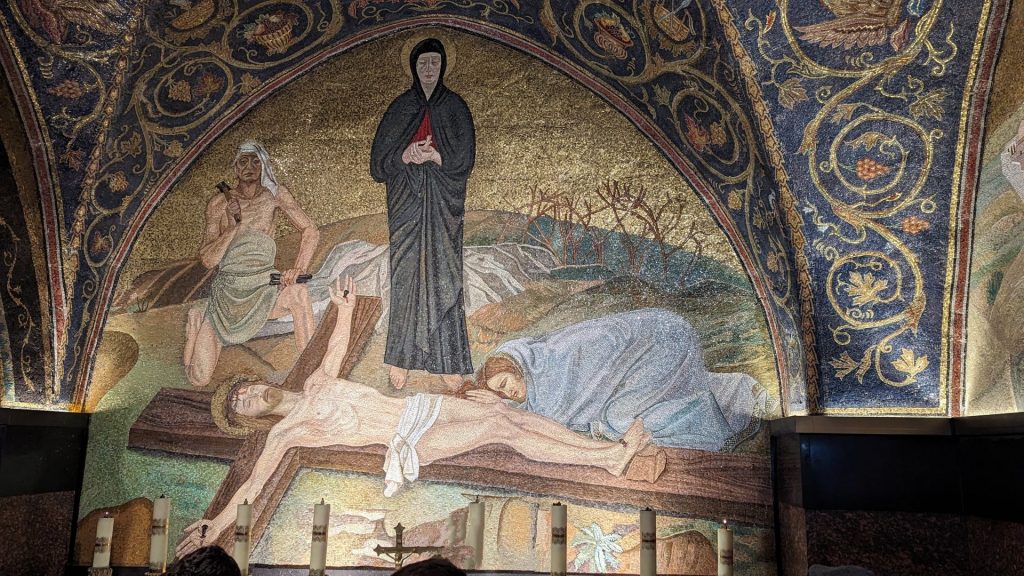
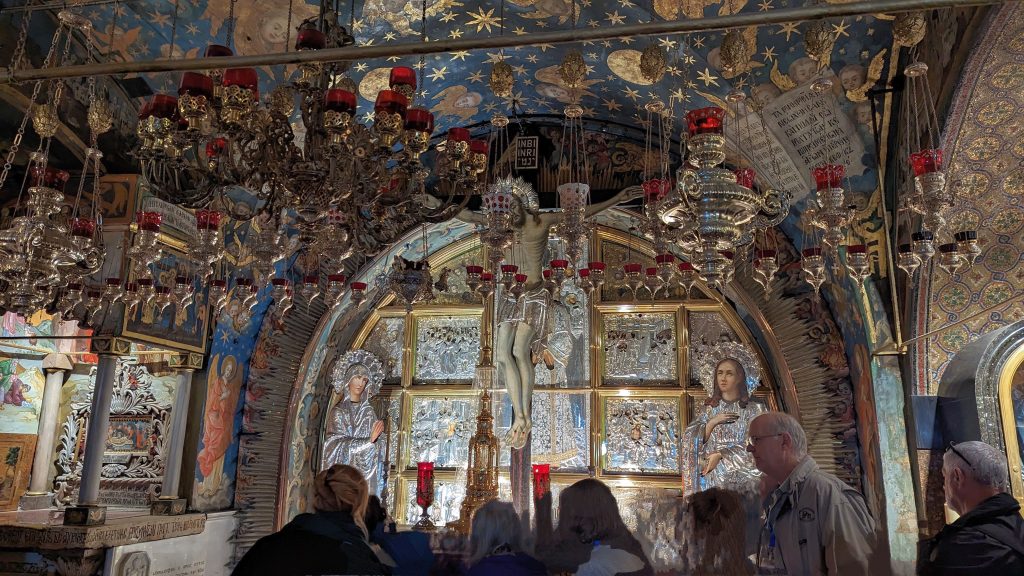
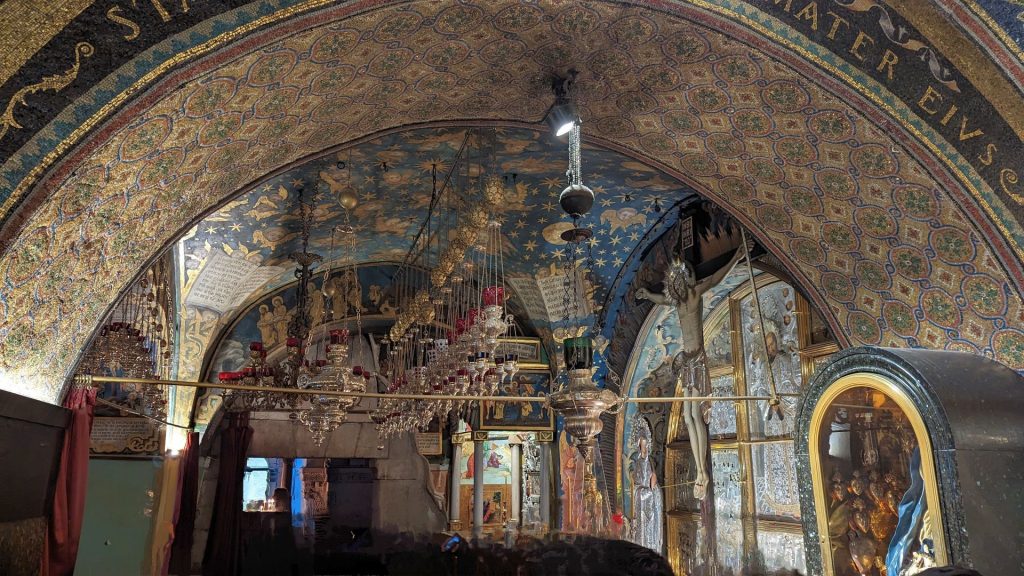
The ornate Greek altar stands over the place where Jesus’ Cross was erected. A silver disc beneath the altar apparently marks the spot the cross of Christ stood. There was a line of people waiting to take their turn reaching their arm down under the altar into the hole. (Not all Christians believe this is where Jesus was crucified.)
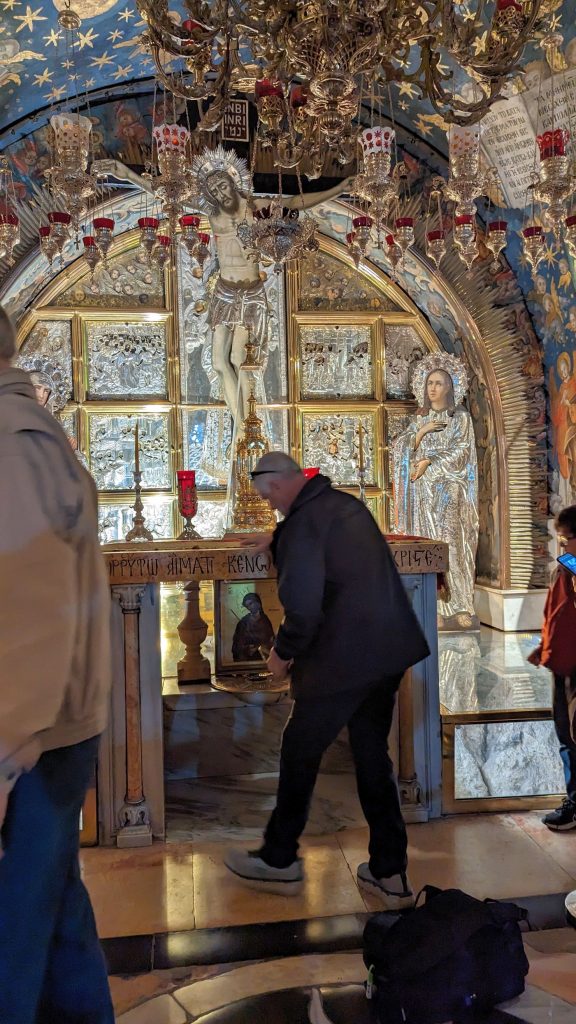
The 13th station is the Stone of Unction. This slab of rock is where the body of Jesus was laid out and anointed with oil and spices in preparation for his burial.
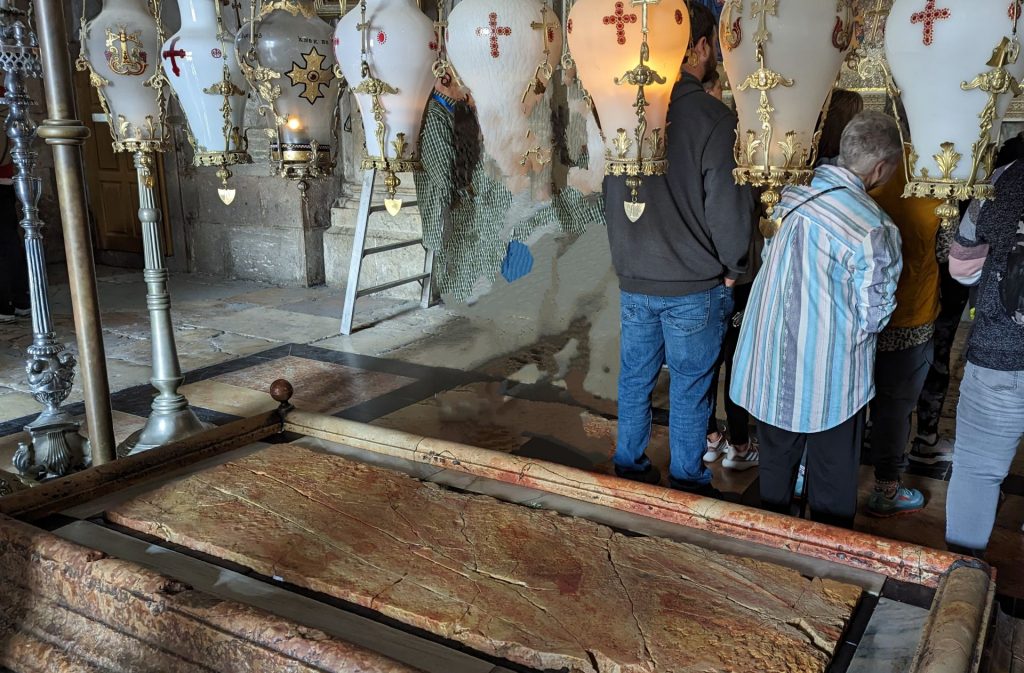
The marble slab that we see today was brought here in 1810 in order to protect the original stone underneath. For centuries, Christian pilgrims have been customarily prostrating themselves before the Stone and placing belongings and jewelry on it for luck. We didn’t place anything on the Stone but we did crouch down, touch it, and say a prayer. It was a very emotional and spiritual experience.
The 14th station is the tomb of Jesus. The line to enter it was exceedingly long and we had little time so we just got close and took this picture.
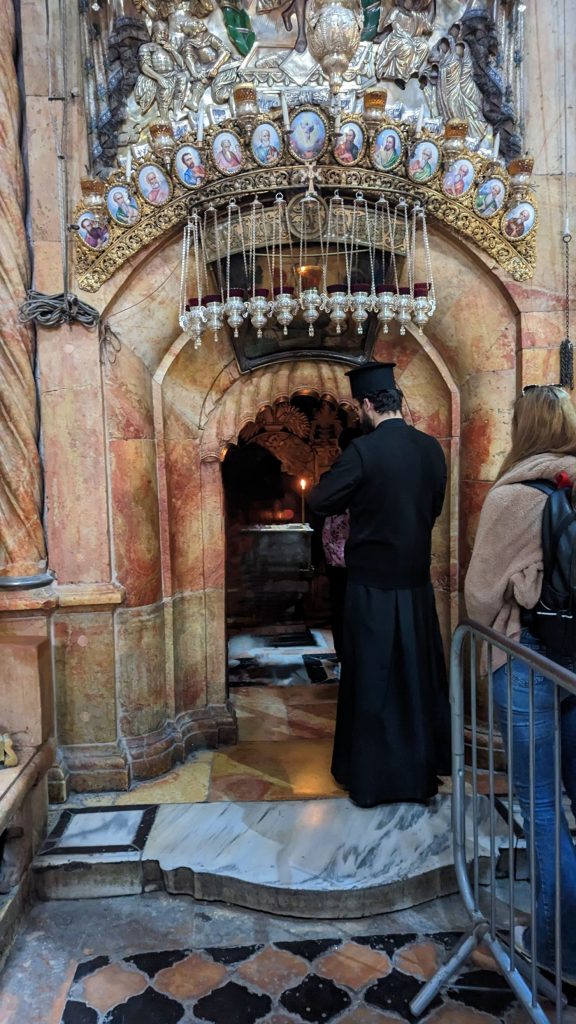
Behind the Stone of Unction is a wall mosaic that was prepared for the Millennium celebration and Pope John Paul II’s visit to the church. It illustrates the events following the crucifixion.
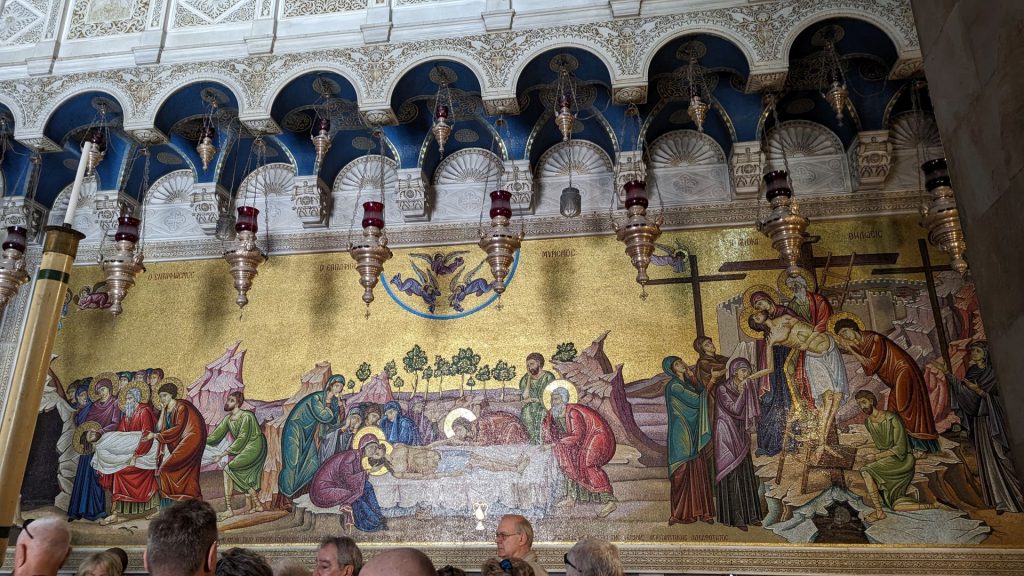
Some of our readers will be familiar with the story of how the earth shook when Jesus died. The Gospel of Matthew, Chapter 27, mentions that an earthquake coincided with the crucifixion: “And when Jesus had cried out again in a loud voice, he gave up his spirit. At that moment the curtain of the temple was torn in two from top to bottom. The earth shook, the rocks split and the tombs broke open.” A crack the rock wall that is supposedly a result of this earthquake is highlighted in the church:
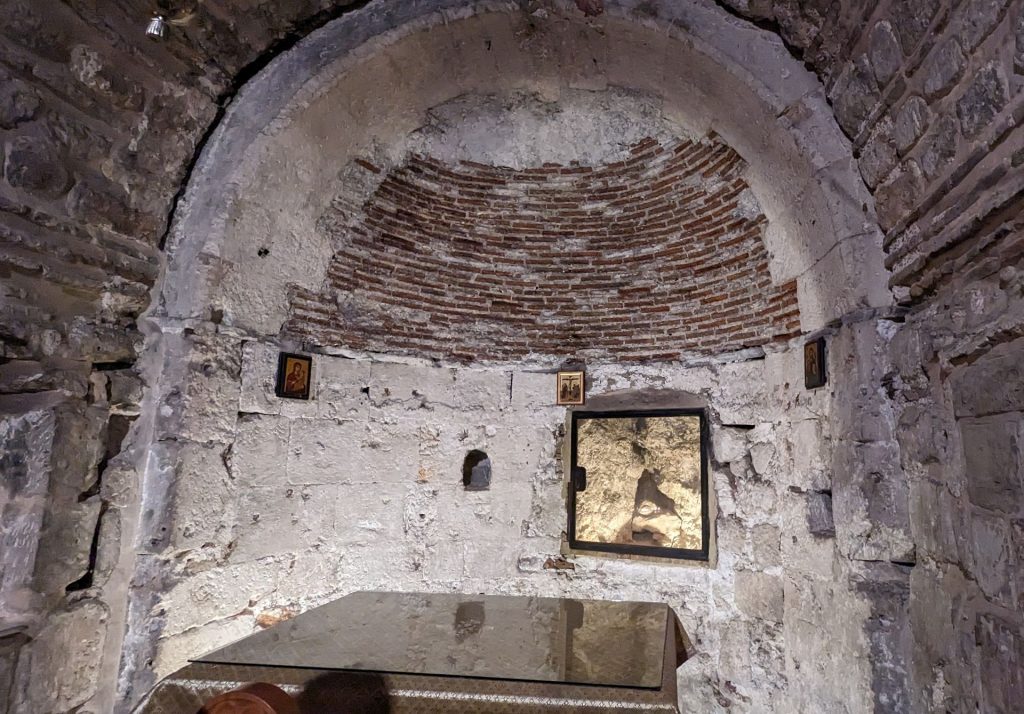
Here are some other pictures of this beautiful religious structure.
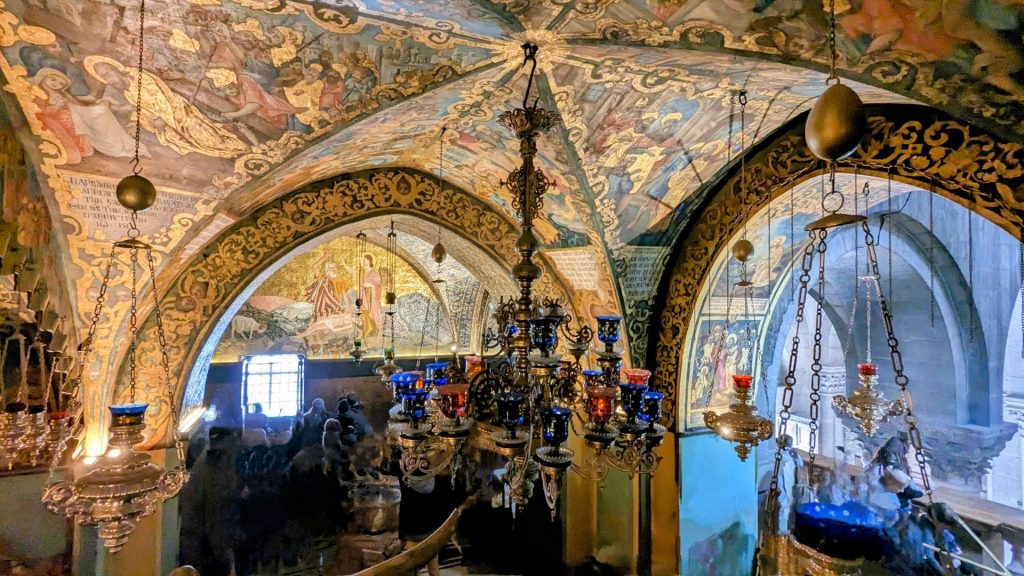
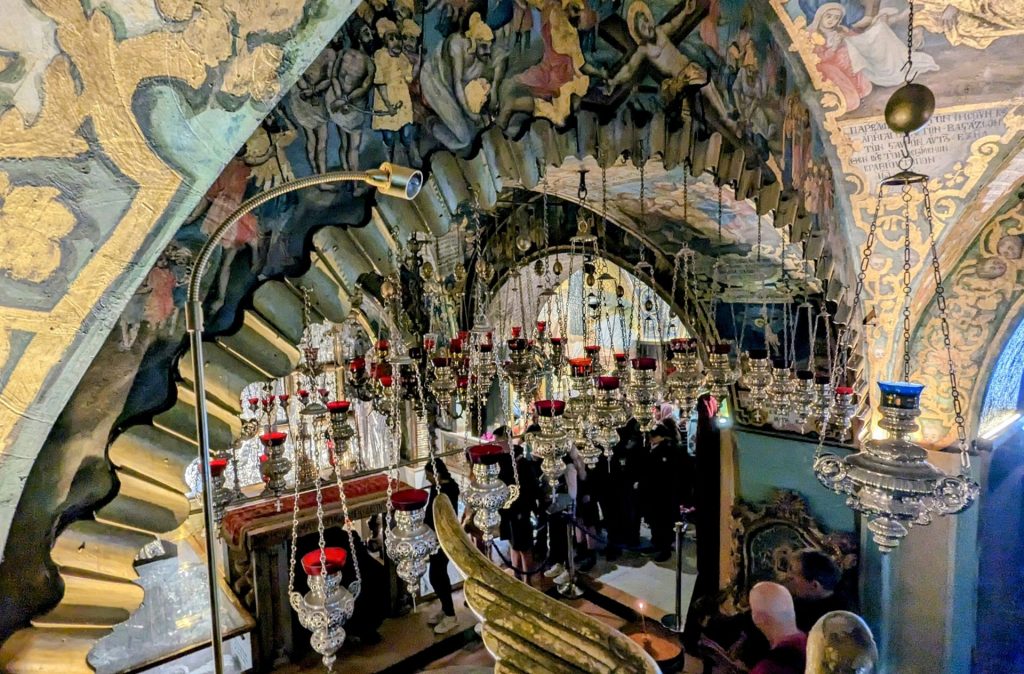
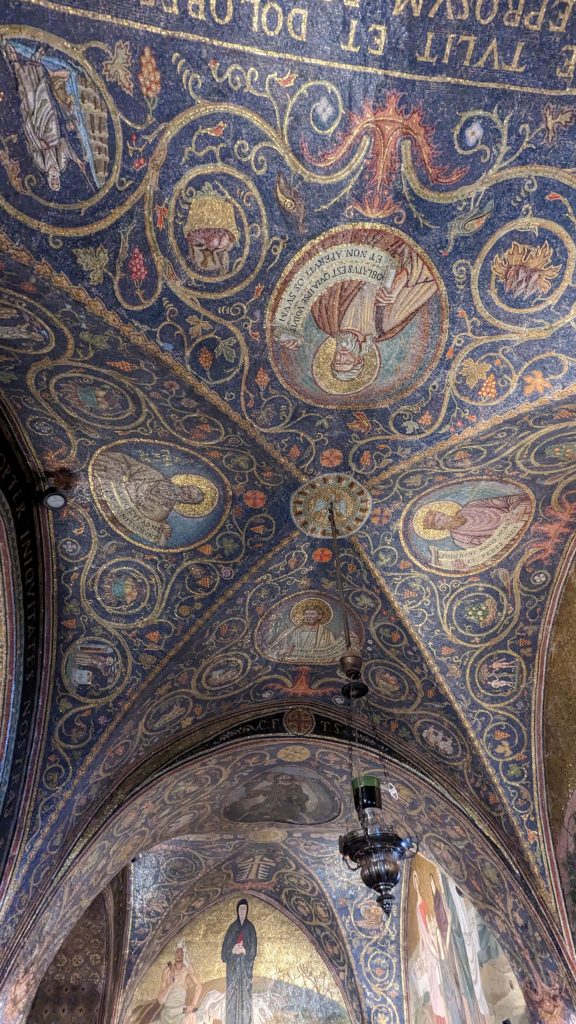
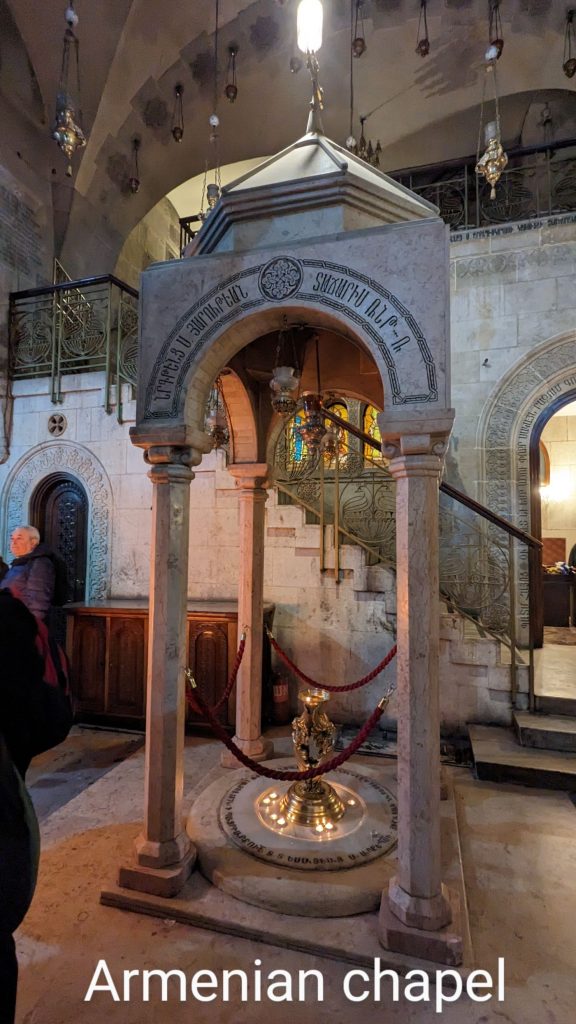
Okay, outside of the church now.
These are the other stations of the Cross we visited.
5th Station: Simon of Cyrene helps Jesus carry the cross. I like this picture because it also includes the name of the famous street.
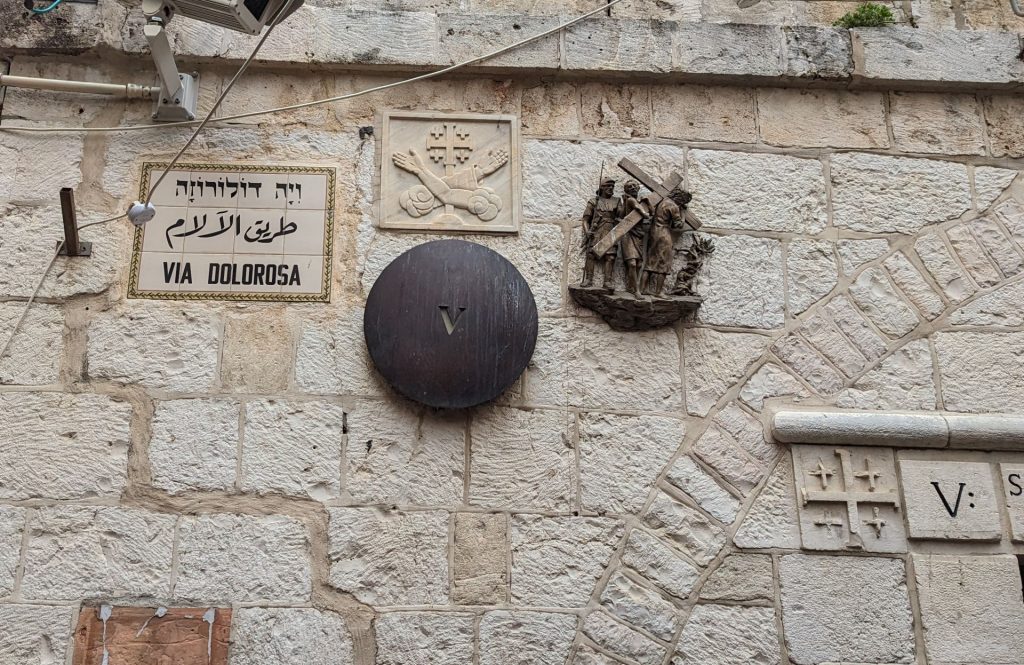
According to Christian tradition this hollow (pictured below) was an imprint made when Jesus stumbled and rested his hand upon the wall to keep his balance, and the touch of centuries of pilgrims has smoothed out the stone and made the depression deeper.
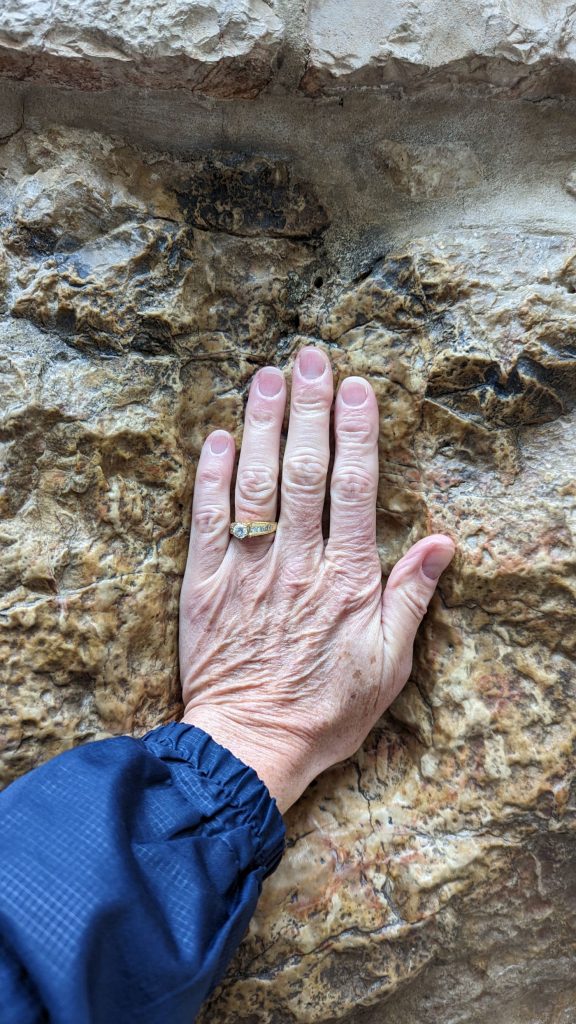
Station number six on the Via Dolorosa marks the site of the home of Veronica, that noble Jerusalem matron who came forward with a linen cloth in her hands to wipe the dust and blood off Jesus’ face. Tradition has it that she was the nameless woman who was twelve years under an issue of blood who had been cured by touching the fringe of Jesus’ garment while he was being thronged by the multitudes at Capernaum. (Luke 8) In persistent gratitude, she followed Jesus afterwards, wherever he went.
According to tradition, the veil was impressed with the image of the Holy Face of the Messiah. The name Veronica comes from the Latin Vera icona meaning the “true image.” Our guide told us that Veronica was the first female saint.
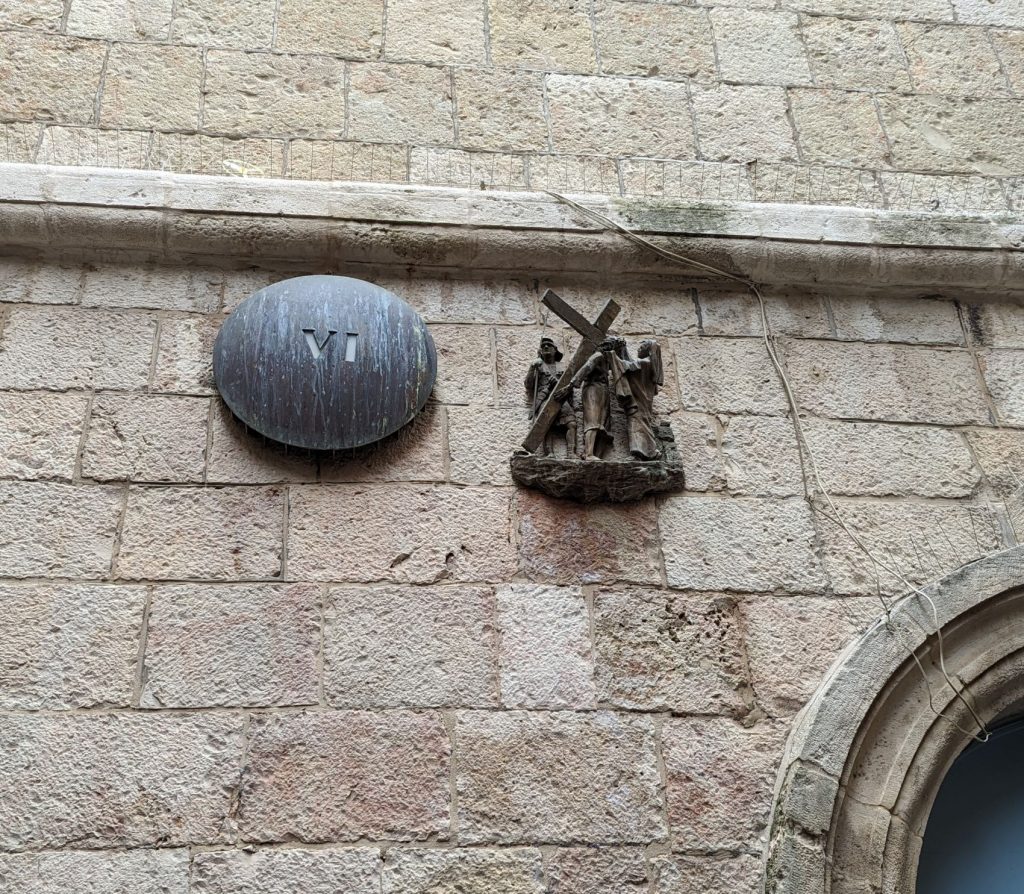
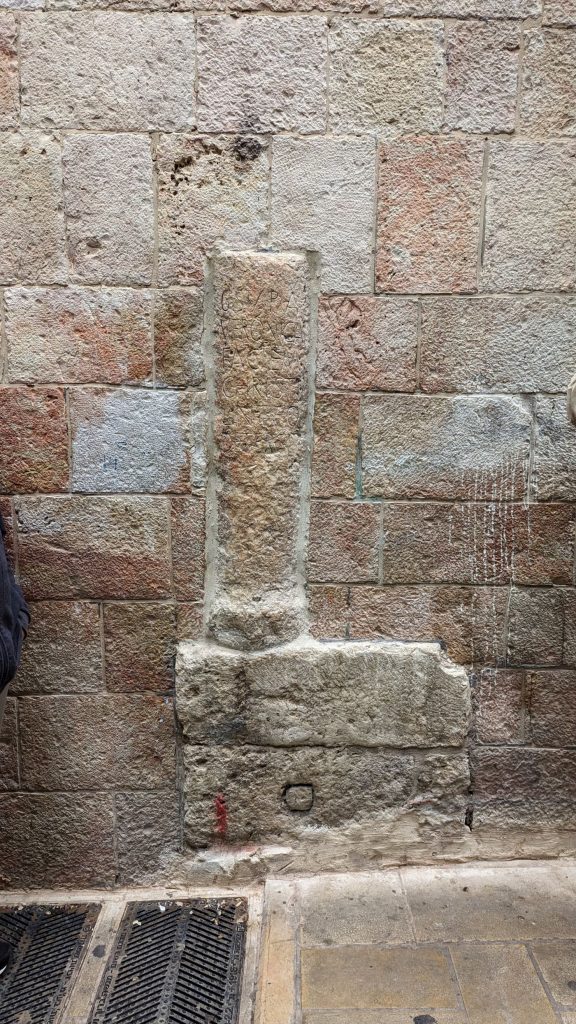
The seventh station marks the spot where Jesus passed through the Judgment Gate and fell for the second time. It is believed that Jesus’ death sentence was posted on this site.
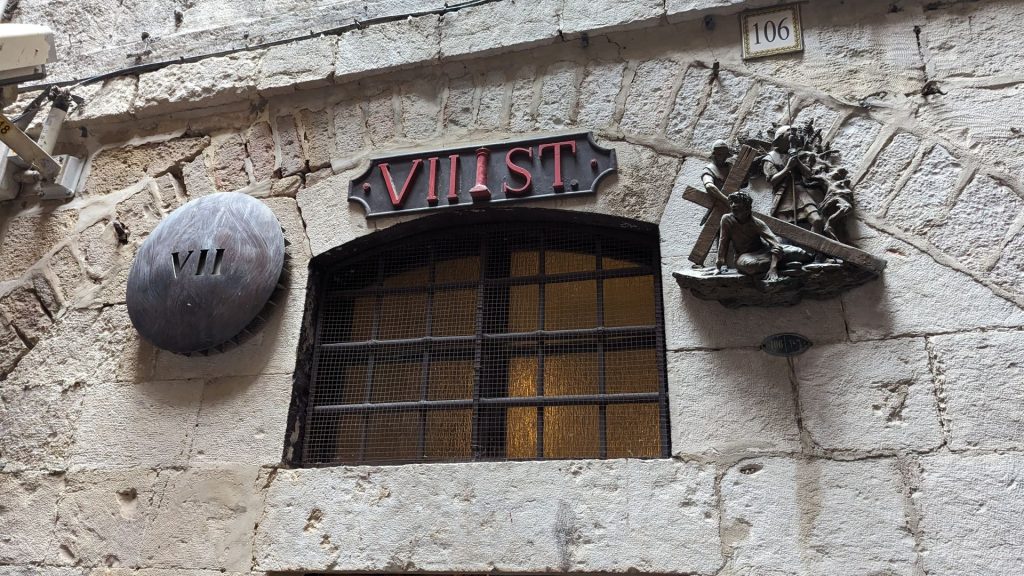
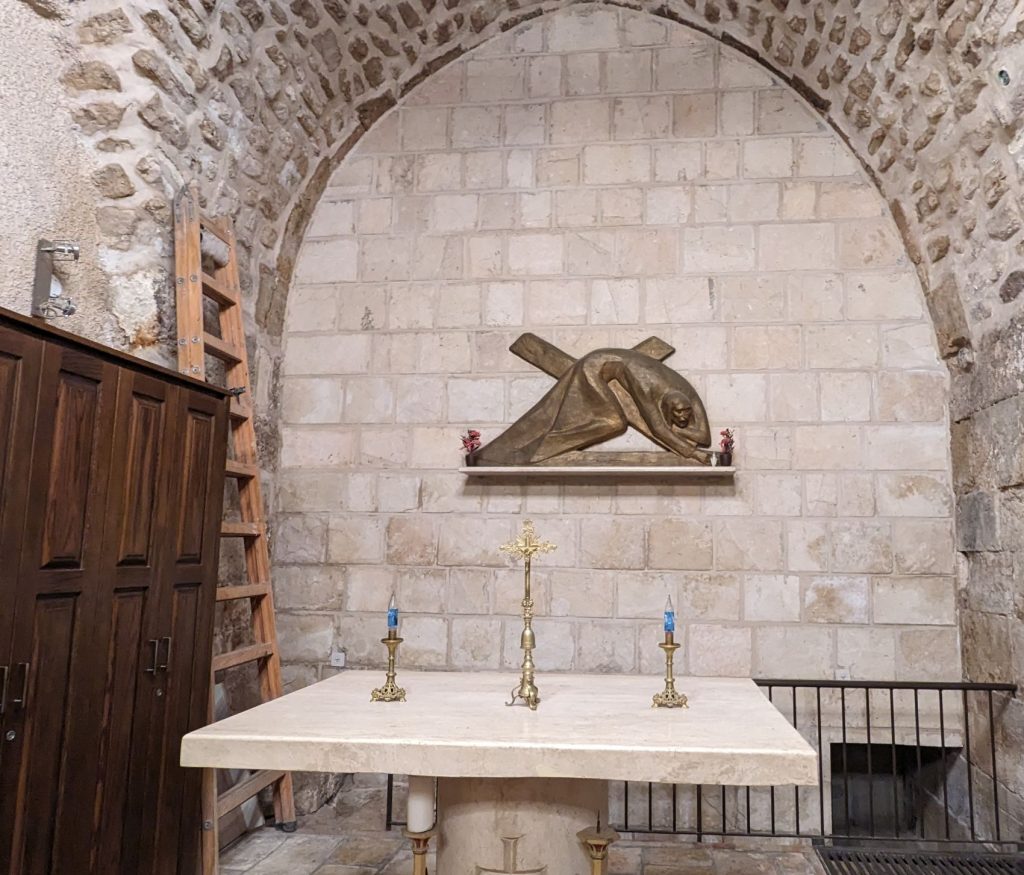
The eighth station is just around the corner from the seventh. This is where Jesus met the women of Jerusalem who wept for him. From the Gospel according to Luke. 23:28-31. Jesus turning to them said, “Daughters of Jerusalem, do not weep for me, but weep for yourselves and for your children.” These were intended to be words of comfort. They serve to focus the vague uneasiness of the women, and, in a society that disregards the concerns of women as imaginary or emotional, Jesus comforts them by taking them seriously. Incredible.
On the wall of a Greek Orthodox monastery, just beneath the number eight marker, is a carved stone of a Latin cross with the Greek letters IC XC NI KA (meaning “Jesus Christ conquers”). I didn’t get a picture of it.
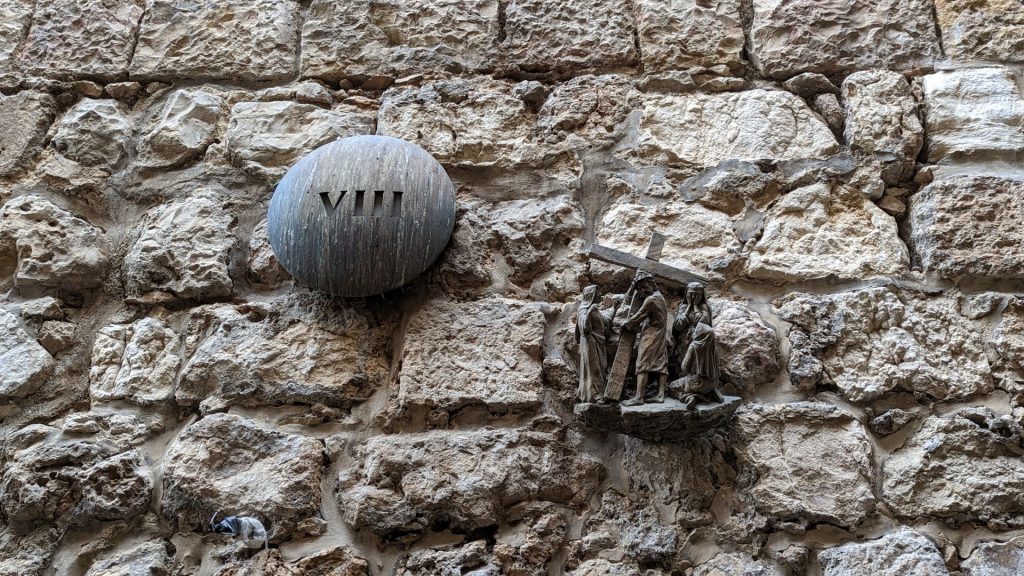
We also visited the Western Wall (also called the Wailing Wall). We learned that there is a side for men and a side for women. Michael and I went to our respective sides, touched the wall, and each said a prayer. I also left a note.
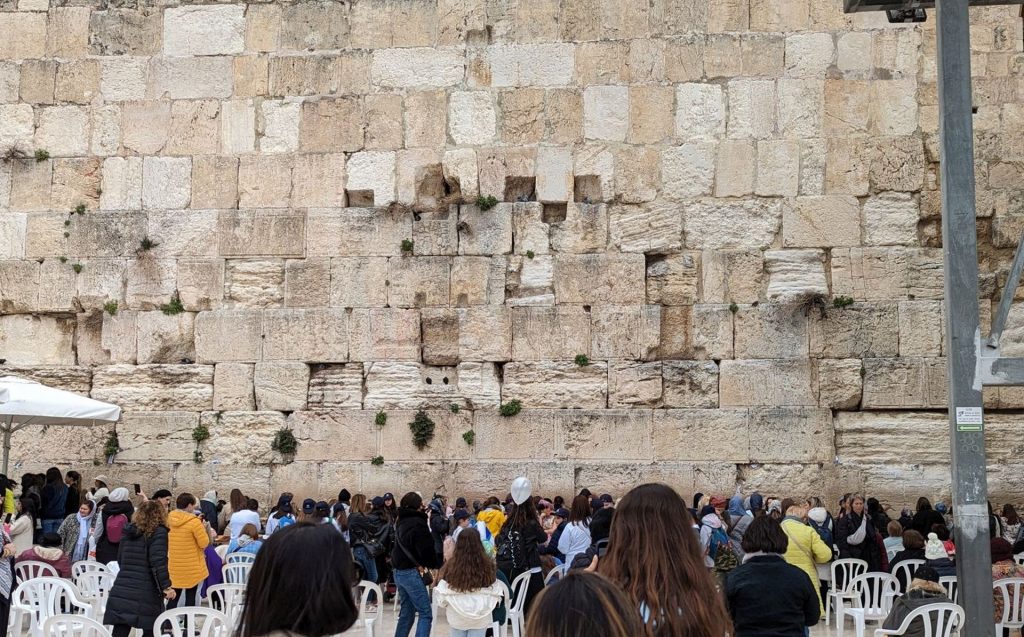
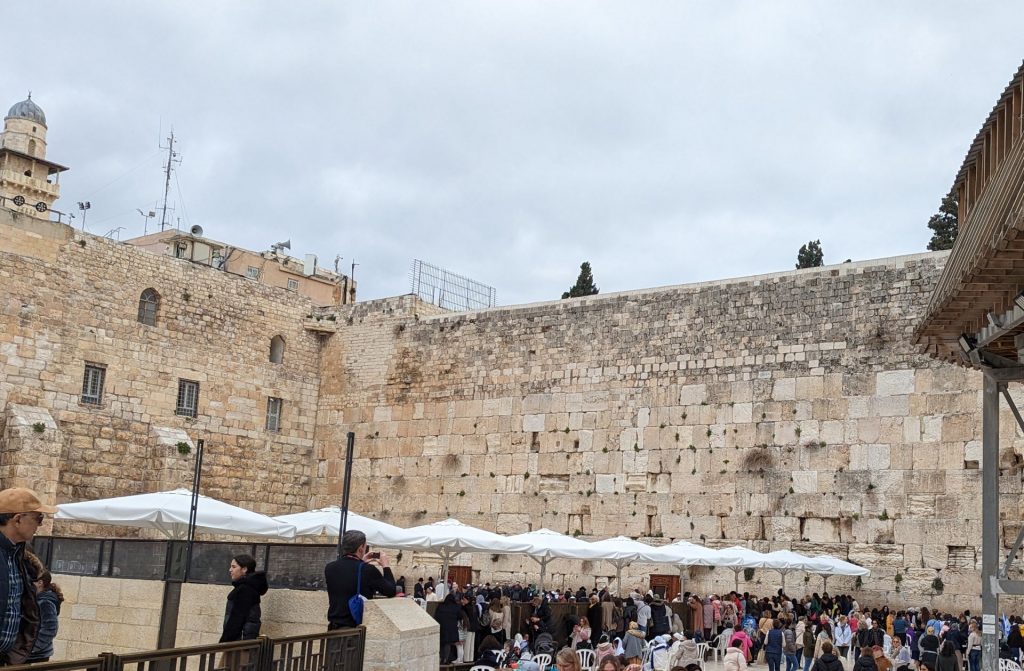
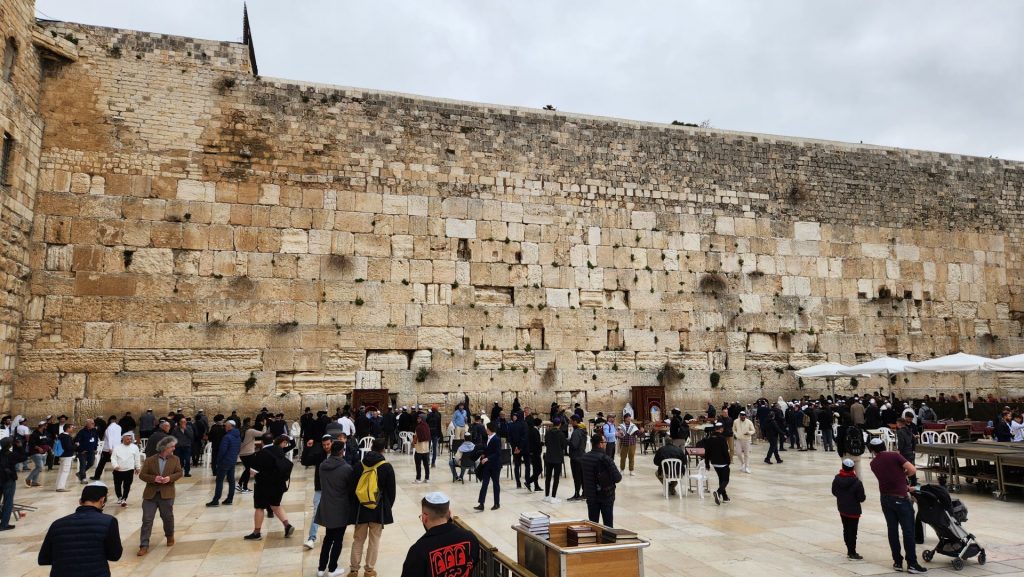
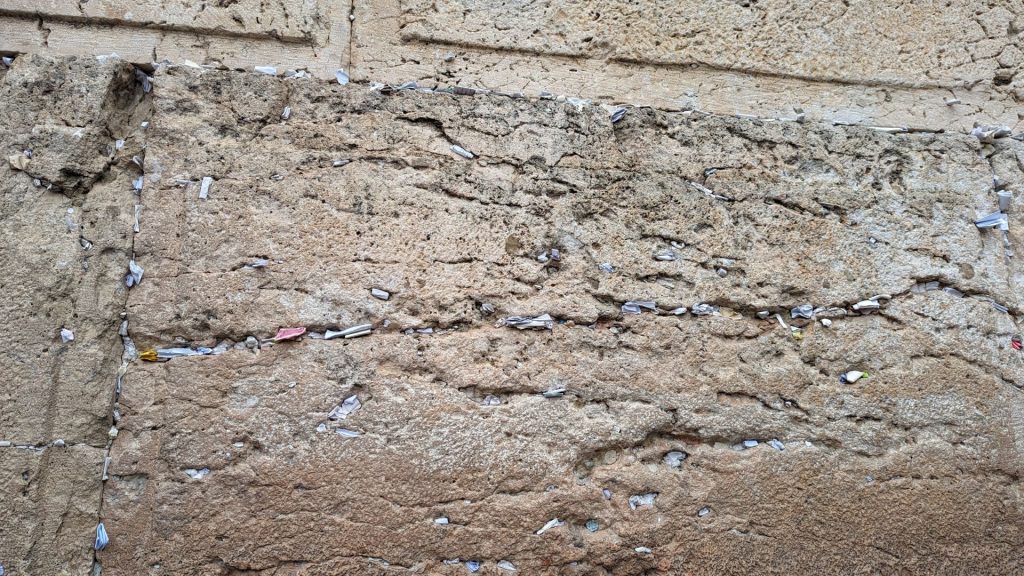
And now random pictures of the Old City of Jerusalem.
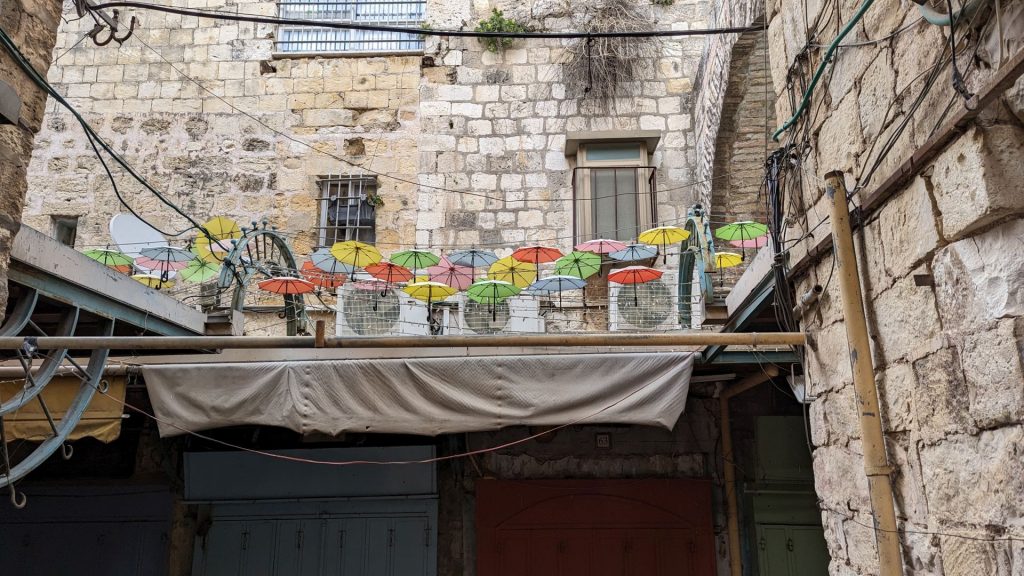
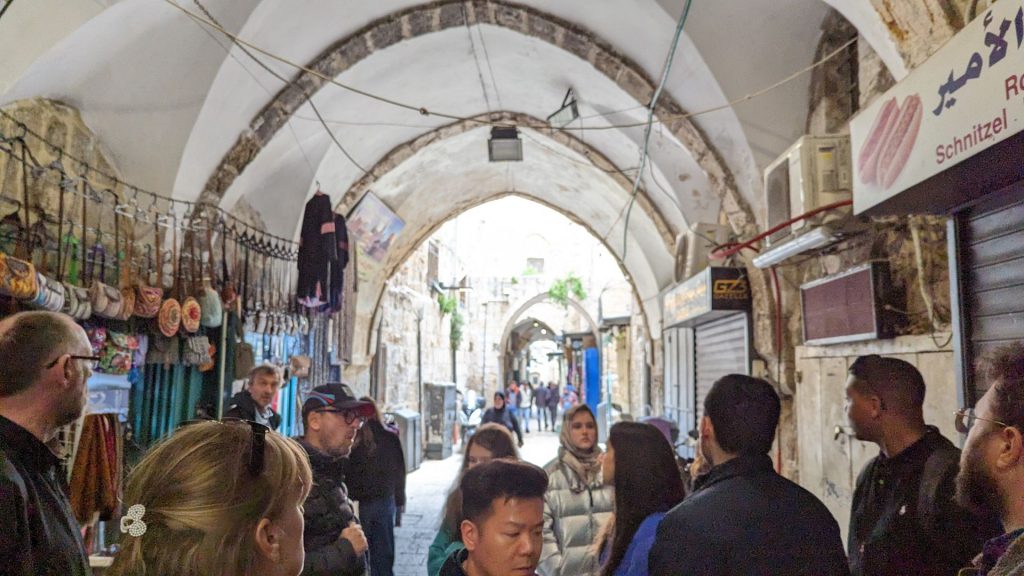
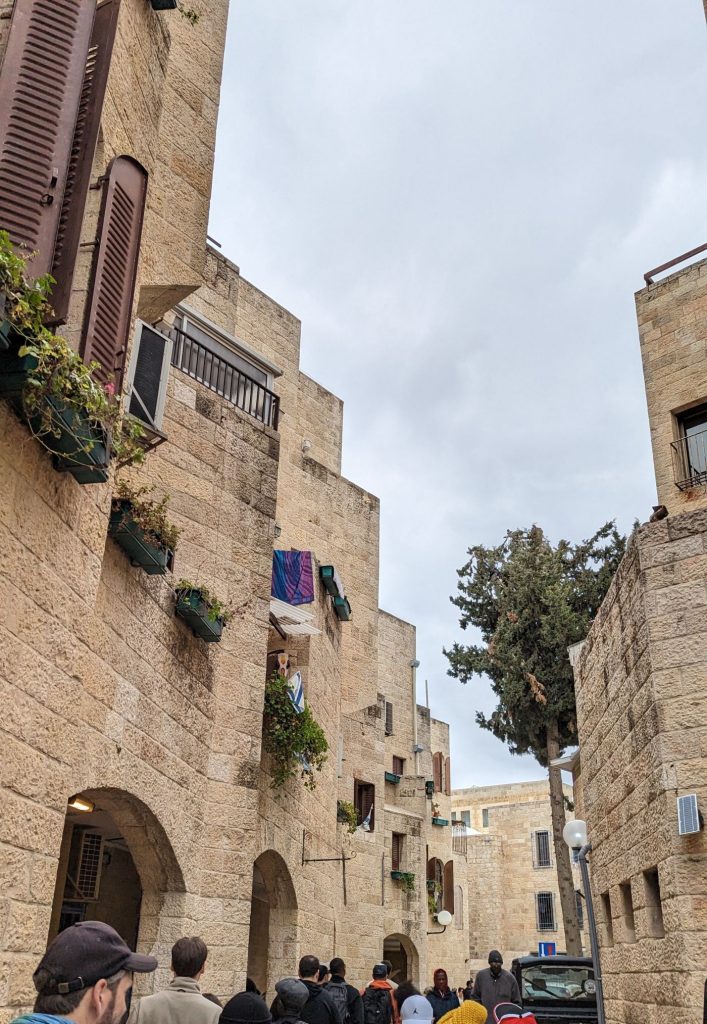
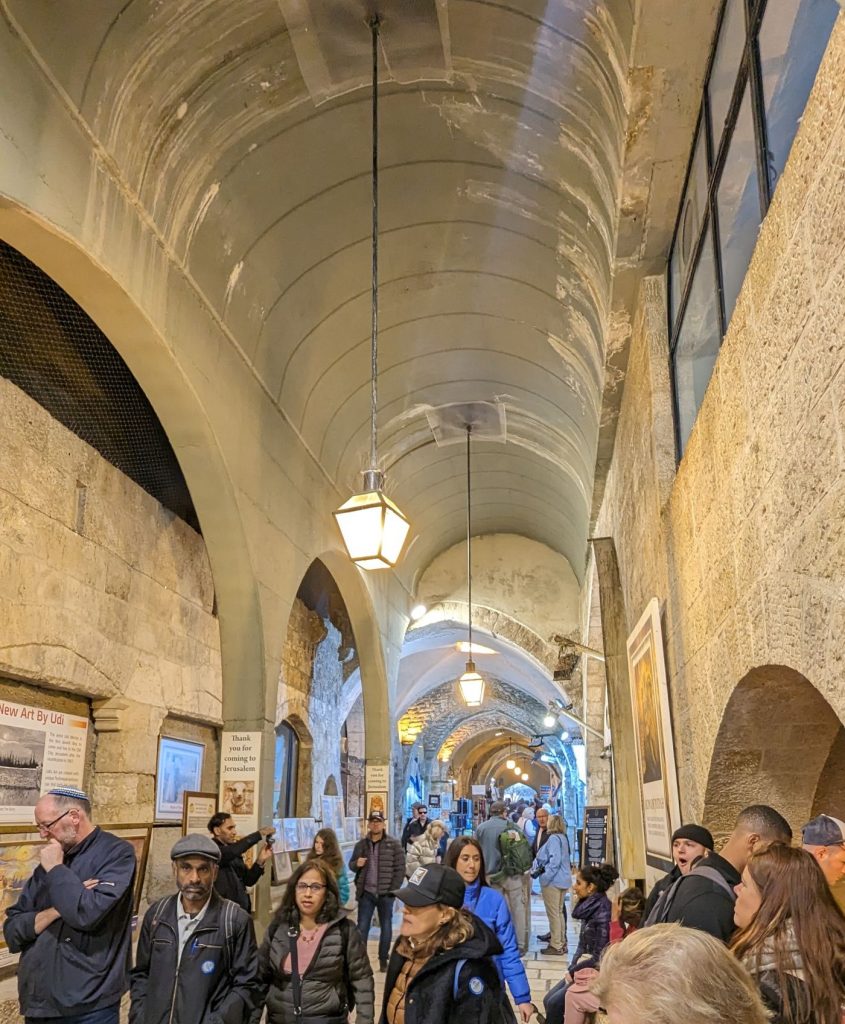
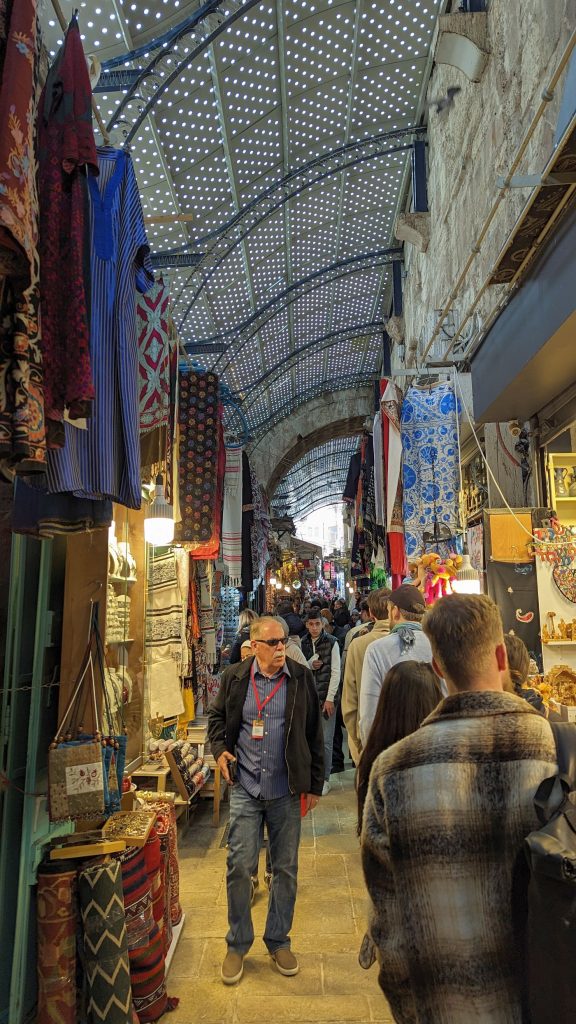
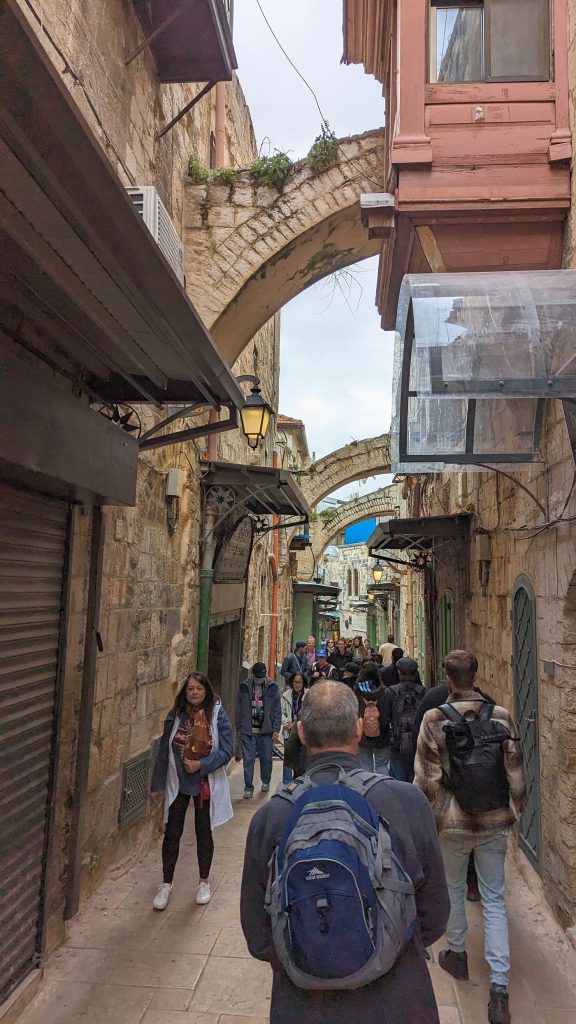
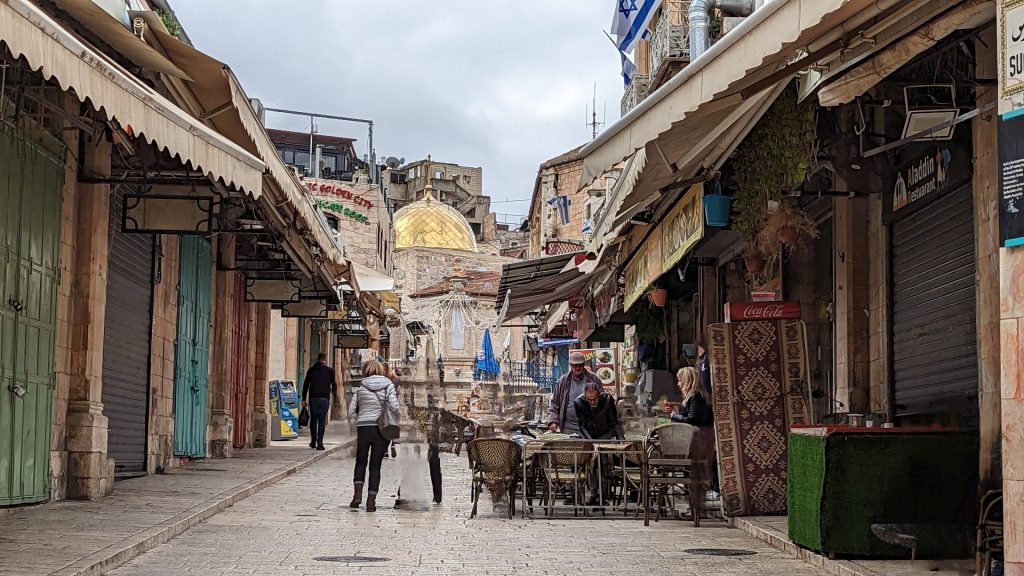
We visited the Holocaust Museum in the new city of Jerusalem but you can’t take pictures inside. I share these few pictures from the outside. These trees are planted in the names of those who helped the Jewish people during the Holocaust.
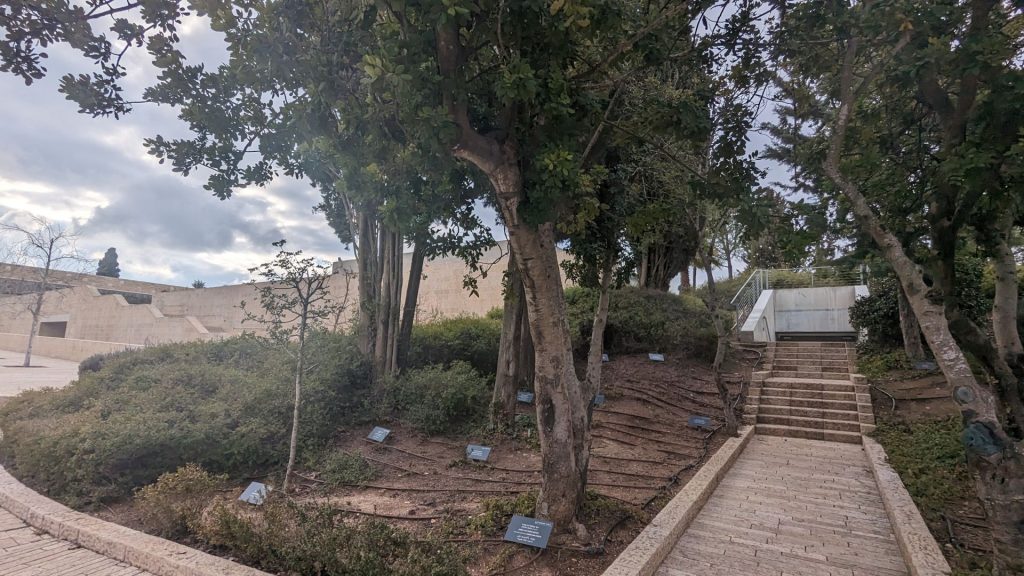
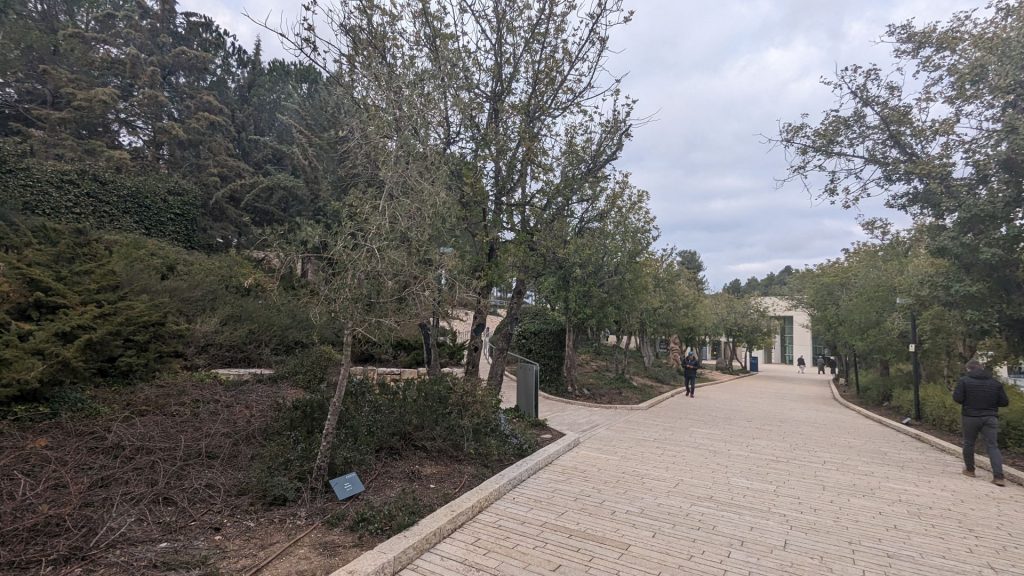
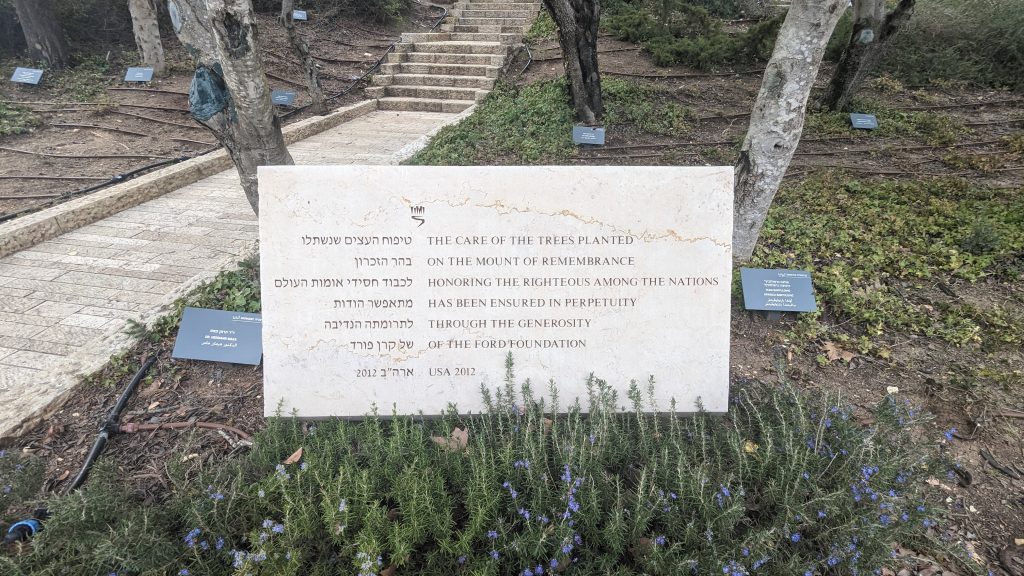
That’s it for this post. We will share more information about our trip to Israel in the next two posts.

Loved reading this and seeing these photos!